Exhibit 96.2
S-K 1300 Initial Assessment Technical report Summary
For the
Fiel rosita
Copper-Molybdenum-Gold-Silver-Zinc
Poly Metallic Mineral Deposit
Region III
Atacama, Chile
Dated July 17, 2023
Revised December 6, 2023
PREPARED FOR
KEY MINING CORP.
BY
RESOURCE DEVELOPMENT ASSOCIATES INC.
Highlands Ranch, CO 80126
| Key Mining Corp. | |
| S-K 1300 - Technical Report Summary – Fiel Rosita | Page I |
| | |
Table of Contents
| 1 | | Executive Summary | 1 |
| 1.1 | | Introduction | 1 |
| 1.2 | | Key Project Outcomes | 1 |
| 1.3 | | Land Tenure | 2 |
| 1.4 | | Geology and Mineralization | 2 |
| 1.5 | | Drilling and Sampling | 2 |
| 1.6 | | Mineral Resources | 2 |
| 1.7 | | Mining Methods | 3 |
| 1.8 | | Recovery Methods | 4 |
| 1.9 | | Infrastructure | 4 |
| 1.10 | | Capital Cost and Operating Cost Estimate | 4 |
| 1.10.1 | | Capital Costs | 4 |
| 1.10.2 | | Operating Costs | 4 |
| 1.11 | | Project Economics | 5 |
| 1.12 | | Interpretations and Conclusions | 9 |
| 1.13 | | Recommendations | 9 |
| 1.13.1 | | Exploration Recommendations | 9 |
| 1.13.2 | | Recommended Work Program to Support a Pre-Feasibility Study | 10 |
| 2 | | Introduction | 11 |
| 2.1 | | Overview | 11 |
| 2.2 | | QP Qualifications | 11 |
| 2.3 | | Terms Of Reference | 11 |
| 2.4 | | Personal Inspection of the Fiel Rosita Property | 11 |
| 2.5 | | Effective Date | 11 |
| 2.6 | | Declaration | 11 |
| 2.7 | | Sources of Information | 12 |
| 2.8 | | Currency and Calculations | 12 |
| 2.9 | | Important Notice | 12 |
| 2.10 | | Acknowledgements | 12 |
| 3 | | Property Description and Location | 13 |
| 3.1 | | Mineral Property and Title in Chile | 13 |
| 3.2 | | Chilean Regulations | 13 |
| 3.3 | | Chilean Mineral Tenure | 13 |
| 3.3.1 | | Pedimento (EXPLORATION CONCESSION) | 13 |
| 3.3.2 | | Manifestacion (EXPLOITATION CONCESSION) | 13 |
| 3.3.3 | | Mensura (SURVEY) | 14 |
| 3.3.4 | | Chilean Claim Process | 14 |
| 3.3.5 | | Surface Rights | 14 |
| 3.3.6 | | Rights of Way | 14 |
| 3.3.7 | | Water Rights | 15 |
| 3.3.8 | | Environmental Regulations | 15 |
| 3.3.9 | | Land Use | 15 |
| 3.3.10 | | Foreign Investment | 16 |
| 3.3.11 | | CURRENT Mining Royalty | 17 |
| 3.3.12 | | The New Mining Royalty | 17 |
| 3.3.13 | | Fraser Institute Study | 19 |
| 3.4 | | Fiel Rosita Property Location | 19 |
| 3.5 | | Fiel Rosita Ownership | 20 |
| 3.5.1 | | Mineral Exploration and Joint Venture Agreement | 20 |
| 3.6 | | Mineral Tenure | 23 |
| 3.7 | | Surface Rights | 34 |
| 3.8 | | Water Rights | 34 |
| 4 | | Accessibility, Climate, Local Resources, Infrastructure and Physiography | 35 |
| 4.1 | | Access and Infrastructure | 35 |
| 4.2 | | Physiography | 35 |
| 4.3 | | Climate | 35 |
| 5 | | History | 39 |
| Key Mining Corp. | |
| S-K 1300 - Technical Report Summary – Fiel Rosita | Page II |
| | |
| 6 | | Geological Setting, Mineralization and Deposit | 40 |
| 6.1 | | Geological Setting | 40 |
| 6.1.1 | | Regional Geology | 40 |
| 6.1.2 | | Local/Property Geology | 41 |
| 6.2 | | Mineralization | 50 |
| 6.3 | | Deposit | 51 |
| 7 | | Exploration | 52 |
| 7.1 | | Exploration History | 52 |
| 7.2 | | Drilling | 52 |
| 8 | | Sample Preparation, Analyses and Security | 55 |
| 8.1 | | Database | 55 |
| 8.2 | | Coarse Blanks | 55 |
| 8.3 | | Standards | 56 |
| 8.4 | | Duplicates | 58 |
| 8.4.1 | | Coarse Duplicates (CD) | 58 |
| 8.4.2 | | Fine Duplicates | 59 |
| 8.4.3 | | Laboratory Duplicates | 59 |
| 8.5 | | Sufficiency of Procedures | 60 |
| 9 | | Data Verification | 61 |
| 9.1 | | Summary | 61 |
| 9.2 | | Data Verification Procedures | 61 |
| 10 | | Mineral Processing and Metallurgy | 62 |
| 11 | | Mineral Resource Estimation | 69 |
| 11.1 | | Copper Equivalent Formula | 69 |
| 11.2 | | Grade Estimates | 69 |
| 11.2.1 | | Exploratory Data Analysis | 69 |
| 11.2.2 | | Grade Capping | 73 |
| 11.3 | | Block Model | 74 |
| 11.3.1 | | Mineral Classification | 74 |
| 11.3.2 | | Grade Estimates and Sensitivity to Cut Off Grade | 74 |
| 11.4 | | Mineral Resource Estimate | 78 |
| 12 | | Mineral Reserve Estimates | 81 |
| 13 | | Mining Methods | 82 |
| 13.1 | | Selection of Mining Method | 82 |
| 13.2 | | Rock Mass Quality Model | 84 |
| 13.3 | | Hydrogeology | 90 |
| 13.4 | | Mine Design | 91 |
| 13.5 | | Production | 93 |
| 14 | | Processing and Recovery Methods | 95 |
| 14.1 | | Flow Sheet | 95 |
| 15 | | Infrastructure | 97 |
| 16 | | Market Studies | 99 |
| 17 | | Environmental Studies, permitting and plans, negotiations, or agreements with local individuals or groups | 100 |
| 18 | | Capital and Operating Costs | 101 |
| 18.1 | | Capital Cost | 101 |
| 18.1.1 | | Mining Capital | 101 |
| 18.1.2 | | Process Plant CAPEX | 102 |
| 18.1.3 | | Other Capital Costs | 103 |
| 18.2 | | Operating Costs (OPEX) | 103 |
| 18.2.1 | | Mining OPEX | 103 |
| 18.2.2 | | Plant OPEX | 104 |
| 18.2.3 | | OPEX Summary | 105 |
| 19 | | Economic Analysis | 107 |
| 20 | | Adjacent Properties | 114 |
| 21 | | Other Relevant Data and Information | 115 |
| 22 | | Interpretation and Conclusions | 116 |
| 22.1 | | Mineral Resources Interpretations and Conclusions. | 116 |
| 22.2 | | Initial Assessment | 116 |
| 23 | | Recommendations | 117 |
| 23.1 | | Exploration Program | 117 |
| 23.2 | | Recommended Work Program to Support a Pre-Feasibility Study | 117 |
| 24 | | References | 119 |
| 25 | | Reliance on Information Provided by the Registrant | 120 |
| 26 | | Date and Signature Page | 121 |
| Key Mining Corp. | |
| S-K 1300 - Technical Report Summary – Fiel Rosita | Page III |
| | |
List of Tables
| Table 1-1 | Fiel Rosita Project Indicated Mineral Resource | 3 |
| Table 1-2 | Fiel Rosita Inferred Mineral Resources | 3 |
| Table 1-3 | Initial capital and sustaining capital costs by major area (US$ Millions) | 4 |
| Table 1-4 | Total operating cost breakdown (LOM average) | 5 |
| Table 1-5 | Financial model inputs | 6 |
| Table 1-6 | Summary of the economic analysis of underground mining of the Project | 7 |
| Table 1-7 | Proposed Exploration Work Program to Delineate Fiel Rosita Mineral Resources | 9 |
| Table 1-8 | Pre-Feasibility Cost Breakdown | 10 |
| Table 3-1 | NSR Based Royalty | 23 |
| Table 3-2 | Summary of Mineral Tenure for the Fiel Rosita Concessions | 24 |
| Table 6-1 | Minor joint system orientations | 47 |
| Table 7-1 | Total Drill Hole Database | 52 |
| Table 7-2 | Drilling Assays with Mineralization Above Detection | 52 |
| Table 8-1 | Comparison of database entries versus assay certificates | 55 |
| Table 8-2 | Number of coarse blanks submitted for QAQC | 55 |
| Table 8-3 | Samples beyond acceptable limits | 56 |
| Table 8-4 | TCu, Mo, Au & Zn Standards, from the Laboratories of Ore Research & Exploration (OREAS), Geostats Pty Ltd. and Verilab | 57 |
| Table 8-5 | Summary of results from standards by element | 58 |
| Table 8-6 | Number of CD Analyses by Element and Area | 58 |
| Table 8-7 | Number of CD Analyses by Element and Area | 59 |
| Table 8-8 | Number of FD Analyses Assessed and Conducted by Element and Area | 59 |
| Table 8-9 | Summary of FD by Variable | 59 |
| Table 8-10 | Number of LD Analyses and Element by Area | 60 |
| Table 8-11 | Number of LD Analyses by Element and Area | 60 |
| Table 10-1 | Recoveries and grades of the rougher concentrate by sample. | 64 |
| Table 10-2 | Recoveries and grades of the rougher concentrate by sample. | 64 |
| Table 10-3 | Feed grade, by sample and average. | 65 |
| Table 10-6 | Grade of the weighted final concentrate, by sample and average | 66 |
| Table 11-1 | Cu General Statistics | 70 |
| Table 11-2 | Cu Outliers | 73 |
| Table 11-3 | Search Radii for Mineralization | 74 |
| Table 11-4 | Grade / Tonnage Relationship of Fiel Rosita Deposit | 75 |
| Table 11-5 | Grade Tonnage Relationship of La Viejita Deposit | 76 |
| Table 11-6 | Grade / Tonnage Relationship for El Chiflon Deposit | 77 |
| Table 11-7 | Fiel Rosita Project Grade Tonnage Relationship | 78 |
| Table 11-8 | Fiel Rosita Project Indicated Mineral Resource | 79 |
| Table 11-9 | Fiel Rosita Inferred Mineral Resources | 79 |
| Table 13-1 | Dimensions of Mineralized Zones | 83 |
| Table 13-2 | Summary of Geotechnical Units | 86 |
| Table 13-3 | Summary of horizontal tasks | 93 |
| Table 13-4 | Summary of vertical tasks | 93 |
| Table 13-5 | Underground Mining Fleet | 94 |
| Table 18-1 | Mining CAPEX | 102 |
| Table 18-2 | Plant CAPEX | 103 |
| Table 18-3 | Mining OPEX | 104 |
| Table 18-4 | Plant OPEX | 105 |
| Table 19-1 | Summary Mining Plan and Criteria for the Economic Analysis Including Inferred Mineral Resources | 107 |
| Table 19-2 | Summary Mining Plan and Criteria for the Economic Analysis Excluding Inferred Mineral Resources | 108 |
| Table 19-3 | Summary of the economic analysis of underground mining of the Project Including Inferred Mineral Resources | 109 |
| Table 19-3 | Summary of the economic analysis of underground mining of the Project Excluding Inferred Mineral Resources | 110 |
| Table 19-5 | Sensitivity Analysis Summary | 111 |
| Table 19-6 | Sensitivities to NPV by varying metallurgical recoveries | 113 |
| Table 23-1 | Proposed Exploration Work Program to Delineate Fiel Rosita Mineral Resources | 117 |
| Table 23-2 | Pre-Feasibility Cost Breakdown | 118 |
| Key Mining Corp. | |
| S-K 1300 - Technical Report Summary – Fiel Rosita | Page IV |
| | |
List of Figures
| Figure 1-1 | Sensitivity of Fiel Rosita to varying metal prices, OPEX and CAPEX. | 8 |
| Figure 1-2 | Sensitivity of Fiel Rosita to varying metallurgical recoveries. | 8 |
| Figure 3-1 | Location of the Fiel Rosita Project | 20 |
| Figure 3-2 | Layout and Location of the Concessions | 33 |
| Figure 4-1 | Overview and cross section showing the morpho-structural units and topography in the Atacama Region in relation to Fiel Rosita | 36 |
| Figure 4-2 | Climate zones of the Atacama region with Koppen Climate Classification scheme. | 37 |
| Figure 4-3 | Monthly precipitation in the Tierra Amarilla Sector Years 2013-2022 | 38 |
| Figure 6-1 | Geologic Map showing the regional geology of the Fiel Rosita Project | 41 |
| Figure 6-2 | Lithologic map of the Fiel Rosita Project | 42 |
| Figure 6-3 | Fiel-Rosita Cross Section | 43 |
| Figure 6-4 | Stratigraphic Section for Fiel Rosita | 44 |
| Figure 6-5 | Major fault structures of the deposit | 45 |
| Figure 6-6 | Left: Aerial interpretation of structural domains. Right: Interpretations of the structures using the Riedel model. | 46 |
| Figure 6-7 | Minor joint systems | 46 |
| Figure 6-8 | Fiel Rosita Prospect Alteration Map | 48 |
| Figure 6-9 | Fiel Rosita hydrogeological basin | 49 |
| Figure 6-10 | Drainage network of the Project area | 50 |
| Figure 7-1 | A) Drill Platform; B) Interpretation Section; C) Detail of a Mineralized Nucleus; D) Reject Storage; E) RC-DDH Core-Sample Storage, and F) El Chiflón and Camp. Storage facilities and Camp have been dismantled and no longer exist at the Project site. | 53 |
| Figure 7-2 | Fiel Rosita Drilling Plan Map | 54 |
| Figure 10-1 | Average mineralogy of variability compounds for flotation | 63 |
| Figure 10-2 | Average distribution of copper sulfides of variability compounds for flotation. | 63 |
| Figure 10-3 | Abrasion Index, Ai, by sample. | 66 |
| Figure 10-4 | SAG Design results, for Fiel Rosita, compared to the S&A database | 67 |
| Figure 10-5 | SVT results, for Fiel Rosita, compared to the S&A database | 67 |
| Figure 11-1 | Breccia Log Prob Plot | 70 |
| Figure 11-2 | Skarn Log Prob Plot | 71 |
| Figure 11-3 | Hornfels Log Prob Plot | 71 |
| Figure 11-4 | Dacite Log Prob Plot | 72 |
| Figure 11-5 | Porphyry Log Plot | 72 |
| Figure 11-6 | Intrusive Log Plot | 73 |
| Figure 11-7 | Distribution of Cu Estimation Domains | 74 |
| Figure 11-8 | Fiel Rosita Grade Tonnage Relationship | 75 |
| Figure 11-9 | Cu-Equivalent Tonne/Grade Curve El Chiflon | 77 |
| Figure 11-10 | Fiel Rosita Area Grade / Tonnage Relationship | 78 |
| Figure 13-1 | Mineralized Zones of the Fiel Rosita Deposit | 82 |
| Figure 13-2 | Mining Layout | 84 |
| Figure 13-3 | Geotechnical unit construction layout of the Project | 85 |
| Figure 13-4 | Overview showing geotechnical sections | 87 |
| Figure 13-5 | Representative section of the geotechnical units for the west mineral body | 88 |
| Figure 13-6 | Representative section of the geotechnical units for the central mineral body | 88 |
| Figure 13-7 | Representative section of the geotechnical units for the central mineral body | 89 |
| Figure 13-8 | Representative section of the geotechnical units for the Fiel Rosita Project | 89 |
| Figure 13-9 | Fiel Rosita hydrogeological basin | 90 |
| Figure 13-10 | Drainage network of the Project | 91 |
| Figure 13-11 | Overview of mining access and infrastructure | 92 |
| Figure 13-12 | Underground Mining Layout | 93 |
| Figure 13-13 | Fiel Rosita Mine Production Plan | 94 |
| Figure 14-1 | Processing Flow Diagram | 96 |
| Figure 15-1 | General layout of the Fiel Rosita Infrastructure | 98 |
| Figure 18-1 | Distribution of Project Capital Expenditures | 103 |
| Figure 18-2 | Distribution of mining OPEX | 106 |
| Figure 18-3 | Distribution of processing OPEX | 106 |
| Figure 19-1 | Sensitivity Analysis (Pre-Tax) | 111 |
| Figure 19-2 | Sensitivity Analysis (Post-Tax) | 112 |
| Figure 19-3 | Sensitivity of varying metallurgical recoveries | 113 |
| Key Mining Corp. | |
| S-K 1300 - Technical Report Summary – Fiel Rosita | Page V |
| | |
| TABLE OF ABBREVIATIONS |
| Abbreviation | Description |
| m | Meters(s) |
| km | Kilometer(s) |
| g/t | Grams / tonne |
| oz | Ounces |
| au | Gold |
| ag | Silver |
| cu | Copper |
| zn | Zinc |
| pb | Lead |
| AA | Atomic absorption |
| AuEq | Gold equivalent |
| AOI | Area of Influence |
| AMR | Advanced Mineral Royalties |
| CuEq | Copper Equivalent |
| FA | Fire Assay with Atomic Absorption Finish |
| GPS | Global Positioning System |
| ICP | Inductively Coupled Plasma (Geochemical analytical method) |
| LOM | Life of Mine |
| NSR | Net Smelter return |
| RQD | Rock quality designation |
| RC | Reverse circulation |
| Key Mining Corp. | |
| S-K 1300 - Technical Report Summary – Fiel Rosita | Page VI |
| | |
| COMMON UNITS OF MEASUREMENT |
| Unit | Description |
| g | Gram |
| k | Kilo (thousand) |
| < | Less than |
| M | Million |
| ppb | Parts per billion |
| ppm | Parts per million |
| % | Percent |
| m2 | Square meter |
| t | Tonne |
| Tonne | 2,204.62 pounds |
| tpd | Tonnes per day |
| tph | Tonnes per hour |
| tpy | Tonnes per year |
| CHEMICAL SYMBOLS |
| Abbreviation | Description |
| Cu | Copper |
| CN | Cyanide |
| Au | Gold |
| H | Hydrogen |
| Fe | Iron |
| Pb | Lead |
| Ag | Silver |
| Na | Sodium |
| S | Sulfur |
| Zn | Zinc |
| Key Mining Corp. | |
| S-K 1300 - Technical Report Summary – Fiel Rosita | Page 1 |
| | |
The Fiel Rosita Project (herein also referred to as “the Project” or “Fiel-Rosita”) is a polymetallic exploration project located in Region III, Chile, South America. The Project is located some 200 km southeast of Copiapó in a mining district that has been actively exploited for decades.
This Technical Report Summary (“TRS”) was prepared and compiled by Resource Development Associates Inc. (“RDA”) at the request of Key Mining Corp. (“KM US”). The purpose of this report is to summarize the results of an initial assessment and scoping study for the Project mineral deposit. This TRS has been prepared in accordance with §§229.1300 through 229.1305 (subpart 229.1300 of Regulation S-K).
This TRS includes an initial assessment based on a scoping, effective as of March 31, 2023 which has an optimized configuration of 7,000 t/d from an underground blast/load/haul, sub-level open stope mining operation. Mill feed would be processed in a 7,000 t/d comminution circuit consisting of primary and secondary crushing, wet grinding in a single semi-autogenous (SAG) mill and single ball mill, followed by conventional selective flotation and separation of three concentrates. Concentrates will be trucked to a nearby port and shipped to smelters worldwide. Refined metals will be sold at contract prices.
For financial modeling tonnages are reported in metric tonnes and all costs are reported in $/t.
All monetary units are in United States dollars ($, US$), unless otherwise specified. Costs are based on first quarter (Q1) 2023 dollars.
The reader is advised that the results of the Initial Assessment (“IA”) summarized in this TRS are intended to provide an initial, high-level review of the proposed project configuration and design options. The IA mining plan and economic model include numerous assumptions. There is no guarantee the Project economics described herein will be achieved.
The key outcomes of the IA are the following:
| ● | The Fiel Rosita Project Mineral Resource is estimated at 195 M Indicated tonnes at average grades of 0.18% Cu (348 Kmt), 100 ppm Mo (43,197 Klbs), 0.15 ppm Au (942 Koz), 2.83 ppm Ag (17,715 Koz) and 0.12% Zn (233 Kmt). Inferred Mineral Resources are estimated at 168 M tonnes at average grades of 0.16% Cu (267 Kmt), 254 ppm Mo (93,82 Klbs), 0.09 ppm Au (503 Koz), 2.83 ppm Ag (15,311 Koz) and 0.11% Zn (179 Kmt). |
| ● | The mine plan developed for the IA provides sufficient feed to support an annual production rate of 19.8 Mlb Cu, 2.3 Mlb Mo, 11 Koz Au, 273 Koz Ag and 12.7 Mlb Zn over 14 years. |
| ● | The initial capital cost (-50% / + 50% accuracy) of the underground mine, processing plant and general site infrastructure is estimated at US$342.95M, including contingency of US$64.81M. |
| | | |
| ● | LOM project sustaining capital costs total US$14.1M and closure costs are estimated at US$20.0M. |
| | | |
| ● | The mining cost (including G&A) is estimated at US$19.2/t mined, processing plant operating cost (including G&A) is estimated at an average of US$10.08/t processed. |
| | | |
| ● | All-in sustaining cost of production is estimated at US$1.36/Cu Lb including sustaining capital and before royalties, mining and income taxes. |
| | | |
| ● | Scheduled Mineral Resources are based on 29.9M tonnes of combined indicated and inferred mineralization. There are 15.25Mt of Inferred Mineral Resources which accounts for 51% of the tonnage. |
| | | |
| ● | The annual production for the project excluding Inferred Mineral Resources is 22.6 Mlb Cu, 0.89 Mlb Mo, 0.01 Koz Au, 0.3 Koz Ag and 12.3 Mlb Zn over 8 years. |
| | | |
| ● | Base Case (US$4.10/Cu lb) Including Inferred Mineral Resources has positive Project NPV of US$302M at an 8% discount rate and an IRR of 37% after mining and income taxes. Payback period is two years. |
| | | |
| ● | Base Case (US$4.10/Cu lb) excluding Inferred Mineral Resources has positive Project NPV of US$82M at an 8% discount rate and an IRR of 18% after mining and income taxes. Payback period is three years. |
| Key Mining Corp. | |
| S-K 1300 - Technical Report Summary – Fiel Rosita | Page 2 |
| | |
KM US operates the Fiel Rosita Project in Chile through its wholly owned Chilean subsidiary, Key Metals Corporation Chile (“KM Chile”), an agreement with Sociedad Química y Minera de Chile S.A. (“SQM”) which calls for KM Chile to spend $20 million in qualified exploration and development expenditures and make $10 million in payments plus a variable royalty to SQM over the next five years to earn an eighty percent (80%) interest the Fiel Rosita Project.
| 1.4 | Geology and Mineralization |
The Fiel Rosita district is located between the Lower Cretaceous to Paleocene metallogenic belt to the west and that of the Eocene to Miocene to the east. Within the project area the primary geologic feature recognized is formed by the contact between the Eocene age Manflas composite pluton containing several porphyritic intrusions and younger breccias, on the east, and the stratified sequences of the Lautaro Formation (Lower-Middle Jurassic) and the Picudo Formation (Upper Jurassic) on the west. This contact runs in a north-south direction.
The district includes the Fiel Rosita Skarn and Porphyry, La Viejita and El Chiflón porphyry style deposits and several other copper and precious metals prospects.
The first two deposits are located in contact with a volcanic-sedimentary series (referred to as a skarn) with the Manflas pluton. La Viejita and El Chiflón deposits are each sub-vertical porphyry and breccia bodies hosted within the Manflas pluton. A thin overburden partly covers the various deposits.
The borehole database received from KM Chile contains 201 boreholes, with a total of 63,706.84 m drilled, 191 of which are in the areas of interest, providing information on a total of 51,713.36m. Most of this available information includes an analysis of %Cu, Mo ppm, Au ppm, Ag ppm and % Zn.
The current sample collection, assaying and certification of assays are consistent with current operating practices. The sampling methods were standardized and tracked. Sample preparation, analysis and security are handled by reputable laboratories. All data had been verified by Golder and Associates before being entered into the drill hole database for grade estimation.
Industry accepted standard practices were used during all drilling programs on the Project. Drill holes were oriented to cross the mineralized zones based on surface and geologic mapping and other geological investigative techniques.
RDA generated the mineralized resource calculation for the Fiel Rosita Project using industry accepted standards. Mineralization has been categorized as either 1) Indicated Mineral Resources or 2) Inferred Mineral Resources.
Three-meter length composites were used for the estimation of Mineral Resources. The results were calculated using Vulcan software and stored in a Vulcan block model. Inverse Distance Cubed estimation techniques were used to estimate mineralization throughout the deposit. Resources were classified as Indicated or Inferred based on the drilling density of the Fiel Rosita drilling data. Resources are reported at a copper equivalent cutoff grade of 0.2% based on selling prices of $3.50/lb Cu, $14.00/lb Mo, $1,750/oz Au, $23.00/oz Ag and $1.10/lb Zn, at the date of July 17,2023.
| Key Mining Corp. | |
| S-K 1300 - Technical Report Summary – Fiel Rosita | Page 3 |
| | |
Table 1-1 Fiel Rosita Project Indicated Mineral Resource
| Deposit | CuEq Cutoff | K mt | CuEq% | Cu % | Mo ppm | Au ppm | Ag ppm | Zn % |
| Fiel Rosita | 0.25% | 66,092 | 0.61 | 0.29 | 173 | 0.12 | 5.89 | 0.29 |
| La Viejita | 0.25% | 58,520 | 0.34 | 0.14 | 31 | 0.24 | 1.21 | 0.02 |
| El Chiflon | 0.25% | 5,039 | 0.55 | 0.19 | 765 | 0.02 | 0.92 | 0.01 |
| Total | | 129,651 | 0.49 | 0.22 | 132 | 0.17 | 3.58 | 0.16 |
| | | | Metal | Cu Kmt | Mo Klbs | Au Koz | Ag Koz | Zn Kmt |
| | | | Fiel Rosita | 192 | 25,168 | 255 | 12,517 | 192 |
| | | | La Viejita | 82 | 4,032 | 452 | 2,277 | 12 |
| | | | El Chiflon | 10 | 8,504 | 3 | 149 | 1 |
| | | | Total | 283 | 37,703 | 710 | 14,943 | 204 |
Table 1-2 Fiel Rosita Inferred Mineral Resources
| Deposit | CuEq Cutoff | K mt | CuEq% | Cu % | Mo ppm | Au ppm | Ag ppm | Zn % |
| Fiel Rosita | 0.25% | 104,429 | 0.51 | 0.19 | 363 | 0.12 | 3.59 | 0.12 |
| La Viejita | 0.25% | 3,442 | 0.32 | 0.19 | 28 | 0.21 | 1.20 | 0.02 |
| El Chiflon | 0.25% | 144 | 0.46 | 0.28 | 352 | 0.01 | 1.08 | 0.01 |
| Total | | 108,015 | 0.50 | 0.19 | 352 | 0.12 | 3.51 | 0.12 |
| | | | Metal | Cu Kmt | Mo Klbs | Au Koz | Ag Koz | Zn Kmt |
| | | | Fiel Rosita | 198 | 83,603 | 403 | 12,055 | 125 |
| | | | La Viejita | 5 | 216 | 23 | 133 | 1 |
| | | | El Chiflon | 1 | 112 | 0 | 5 | 0 |
| | | | Total | 203 | 83,930 | 426 | 12,192 | 126 |
The date of the mineral resource estimate is July 17, 2023.
Mineral resources for the Project are enumerated as per §229.1302(d)(1)(iii)(A) (Item 1302(d)(1)(iii)(A) of Regulation S-K).
Mineral resources are not mineral reserves and do not meet the threshold for reserve modifying factors, such as economic viability, that would allow for conversion to mineral reserves. There is no certainty that any part of the Mineral Resources estimated will be converted to mineral reserves.
Numbers in the table have been rounded to reflect the accuracy of the estimate and may not sum due to rounding.
Three areas within the Fiel Rosita mineral body have been selected for this scoping study. Sub Level Open Stoping (SLOS) mining methods will be utilized for the Project. Cement backfilling of the stopes will aid in this mining method. Stope dimensions will vary depending on rock mass quality. Backfilling will be accomplished through a network of shafts and piping that connect the cement plant with the mine.
| Key Mining Corp. | |
| S-K 1300 - Technical Report Summary – Fiel Rosita | Page 4 |
| | |
Mineralization will be accessed by three portals; one for each mine. Production will be carried out using drilling/ blasting/hauling underground mining methods.
Processing at the Project will be accomplished by conventional flotation of three processing streams:
| 1. | Copper concentrates which also recover gold and silver |
Comminution will be through primary crushing followed by a SAG mill and ball mill. Three separate concentrates will be produced through selective flotation and stockpiled. Water will be recycled and tailings stored in a properly designed tailings storage facility.
The infrastructure to support the Fiel Rosita Project will consist of the mine site, facilities, offices, and workshops, water management systems, tailings storage, waste material disposal, and electric power distribution. The mine and plant facilities will have potable water, compressed air, power, diesel, communication and sanitary systems, as required.
| 1.10 | Capital Cost and Operating Cost Estimate |
The total estimated preproduction capital cost (+/- 50%) to design, procure, construct and commission the Project facilities, including reclamation activities, is estimated to be US$260.27M. The estimated sustaining capital cost required by the Project is US$14.1M. Contingencies and indirect costs are estimated to be US$82.69M. Closure costs are estimated at US$20.0M. The cumulative LOM capital expenditures (preproduction and sustaining capital) are estimated to be US$377.06M. Table 1-3 summarizes the initial capital and sustaining capital costs by major area.
Table 1-3 Initial capital and sustaining capital costs by major area (US$ Millions)
| Cost Item | Initial US$M | Sustaining US$M |
| Mine Equipment | 23.47 | |
| Mine Development | 35.15 | |
| Processing Facilities | 74.92 | 14.1 |
| Infrastructure | 84.61 | |
| Power Supply | 14.85 | |
| Construction | 27.27 | |
| Contingency | 64.81 | |
| Owner’s Cost | 4.61 | |
| Total | 325.69 | |
Note: Rounding of some figures may lead to minor discrepancies in totals
The operating cost estimate for the Project includes all expenses incurred to operate the mine and process plant from the start of Year 1 through Year 14 at a daily average production rate of 7,000 mt/d. The expected accuracy for the operating cost estimate is that of an initial assessment study level (+/- 50%). Any process material excavated during the preproduction period is considered as a capital expense. The average operating cost over the life of mine is estimated to be US$36.09/t.
The total operating cost estimate summaries are shown in Table 1-4 for the three major operating cost areas: mining, processing and general and administrative (G&A). The unit costs areas are shown in terms of total cost LOM per processed tonne milled and total cost per pound of copper produced.
| Key Mining Corp. | |
| S-K 1300 - Technical Report Summary – Fiel Rosita | Page 5 |
| | |
Table 1-4 Total operating cost breakdown (LOM average)
| Cost Item/Area | Total $M | Average ($/t milled) | Average ($lb Cu Recovered) | Average ($lb CuEq Recovered) |
| Mining | 602.6 | 20.15 | 2.17 | 0.92 |
| Processing | 316.7 | 10.59 | 1.14 | 0.48 |
| General and Administrative | 24.2 | 0.81 | 0.09 | 0.04 |
| Total Onsite Mine Operating Costs | 943.5 | 31.55 | 3.40 | 1.44 |
| Treatment and Sales | 135.7 | 4.54 | 0.49 | 0.21 |
| Total | 1,079.2 | 36.09 | 3.89 | 1.65 |
The following section discusses an initial economic assessment for the Project. This economic assessment is preliminary in nature, it includes Inferred Mineral Resources that are considered too speculative geologically to have modifying factors applied to them that would enable them to be categorized as mineral reserves, there is no certainty that this economic assessment will be realized. Fifty percent (50%) of the Mineral Resources used in the cash flow analysis are classified as Inferred Mineral Resources.
A financial analysis for the Project was carried out using a discounted cash flow approach. The internal rate of return (IRR) on total investment was calculated based on the initial investment of US$342.96. The net present value (NPV) was calculated from the cash flow generated by the Project based on a discount rate of 8%. The payback period based on the undiscounted annual cash flow of the Project was also indicated as a financial measure.
No inflation or escalation exists in the economic model. KM Chile compiled the taxation calculations for the Project with assistance from third-party taxation experts. The model calculates pre-tax and after-tax returns and is based on the current Chilean tax system applicable to mineral resource income. The model includes provisions for transportation, insurance, refining and payable charges. The major inputs and assumptions used for the development of the financial model are listed in Table 1-5.
| Key Mining Corp. | |
| S-K 1300 - Technical Report Summary – Fiel Rosita | Page 6 |
| | |
Table 1-5 Financial model inputs
| Execution Plan |
| Construction Period | 18 months |
| Mine Life (after pre-production) | 14 years |
| LOM Plan Feed Tonnes (millions) | 29.0 |
| LOM Copper Grade (%) | 0.47 |
| LOM Gold Grade (g/mt Au) | 0.27 |
| LOM Silver Grade (g/mt Ag) | 8.80 |
| LOM Molybdenum Grade (g/mt Mo) | 706.2 |
| LOM Zinc Grade (g/mt Zn) | 0.33 |
| LOM Copper Equivalent Grade (%) | 0.91 |
| Metallurgical Recovery |
| Copper (%) | 90 |
| Gold (%) | 62 |
| Silver (%) | 45 |
| Molybdenum (%) | 68 |
| Zinc (%) | 80 |
| Metal Pricing |
| Copper Price (US$/lb) | 4.10 |
| Gold Price (US$/oz) | 1802.00 |
| Silver Price (US$/oz) | 23.50 |
| Molybdenum Price (US$/lb) | 12.70 |
| Zinc Price (US$/lb) | 1.50 |
| Cost and Tax Criteria |
| Estimate Basis | Q1 2023 |
| Inflation/Currency Fluctuation | None |
| Income Tax | 27% Chilean Federal |
| Metal Transportation, Smelting and Payable Charges |
| Copper Price (US$/t Diluted Plant Feed) | 5.005 |
| Gold Price (US$/t Diluted Plant Feed) | 0.001 |
| Silver Price (US$/t Diluted Plant Feed) | 0.100 |
| Molybdenum Price (US$/t Diluted Plant Feed) | 0.006 |
| Zinc Price (US$/t Diluted Plant Feed) | 4.058 |
| Payable Terms |
| Concentrate | 100% |
| Key Mining Corp. | |
| S-K 1300 - Technical Report Summary – Fiel Rosita | Page 7 |
| | |
Table 1-6 below presents the results of the economic analysis
Table 1-6 Summary of the economic analysis of underground mining of the Project
| | Value | Unit |
| Production Metrics |
| Mill Throughput | 7,000 | Dry tonnes/day |
| Head Grade – LOM | 0.91 | % Copper Equivalent |
| Mine Life (including pre-production) | 15.5 | Years |
| Total Copper Produced | 277,600,000 | Pounds |
| Total Gold Produced | 159,000 | Ounces |
| Total Silver Produced | 3,823,000 | Ounces |
| Total Molybdenum Produced | 31,626,000 | Pounds |
| Total Zinc Produced | 178,350,000 | Pounds |
| Capital and Operating Costs | |
| CAPEX – Initial | 342.96 | US$Million |
| CAPEX – Sustaining | 14.1 | US$Million |
| Reclamation | 20 | US$Million |
| OPEX – Mining | 17.50 | US$/t mined |
| OPEX – Processing | 9.22 | US$/t processed |
| OPEX – G&A | 2.56 | US$/t mined/processed |
| Pre-Tax Financial Metrics |
| Pre-Tax NPV (@8%) | 459.8 | US$Million |
| Pre-Tax IRR | 48 | % |
| Pre-Tax Payback | 1.4 | Years |
| Post-Tax Financial Metrics |
| Post-Tax NPV (@8%) | 302.0 | US$Million |
| Post-Tax IRR | 40 | % |
| Post-Tax Payback | 2.2 | Years |
The pre-tax internal rate of return (IRR) is 48% and the pre-tax net present value (NPV) using an 8% discount rate over the life of mine is US$459M. The after-tax IRR is 40% and the pre-tax NPV using an 8% discount rate over the life of mine is US$302M.
Excluding Inferred Resources, the pre-tax internal rate of return is 30% and the pre-tax NPV 8% is US$184M. On an after-tax basis the post-tax IRR is 20% and the post-tax NPV 8% is UD$94M
The results of the after-tax sensitivity analysis performed are summarized in Figure 1-1 and Figure 1-2. The Figure 1-1 sensitivity analyses demonstrate that metal values are most sensitive to selling price and recovery. A 20% increase in the metal selling prices would yield an NPV of US$410M. A 20% decrease in metal selling prices would yield a reduced NPV of US$194M. The impact of variations in operating and capital cost on both financial metrics is similar with the operating cost changes resulting in marginally larger project returns than capital cost changes, meaning reducing operating expenses would benefit the Project more than reducing capital costs by the same percentage.
Figure 1-2 is a sensitivity to varying metallurgical recoveries. Fiel-Rosita is a polymetallic deposit. Metal recoveries are highly impactful on revenue. An increase of 6% recovery would yield a NPV of US$361M. A 6% decrease in those same recoveries would yield a reduced NPV of US$243M.
| Key Mining Corp. | |
| S-K 1300 - Technical Report Summary – Fiel Rosita | Page 8 |
| | |
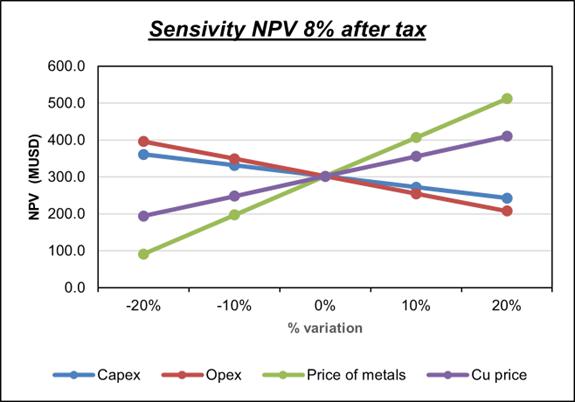
Figure 1-1 Sensitivity of Fiel Rosita to varying metal prices, OPEX and CAPEX.
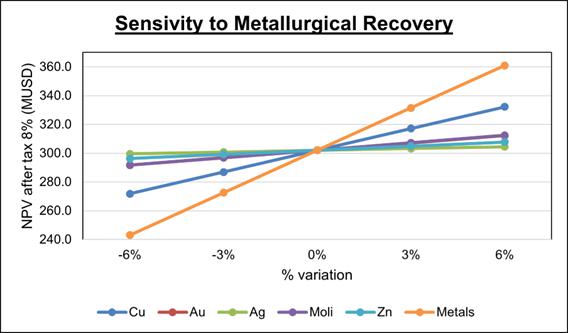
Figure 1-2 Sensitivity of Fiel Rosita to varying metallurgical recoveries.
| Key Mining Corp. | |
| S-K 1300 - Technical Report Summary – Fiel Rosita | Page 9 |
| | |
| 1.12 | Interpretations and Conclusions |
This TRS was prepared to initially assess the economic viability of an underground mine and process plant complex based on indicated and inferred mineral resource at the Fiel Rosita Project. Processing of 7,000 t/d is planned. The assessment provides a summary of the results and findings from each major area of investigation to a level that is equivalent and normally expected for an initial assessment of a resource development project. Standard industry practices were used in this study. The Project contributors, on the date of publication, are not aware of any unusual or significant risks or uncertainties that could affect the reliability or confidence in the Project or the disclosed economic outcomes.
The results of the economic analysis suggest the proposed project warrants further expenditures that would allow the Company to develop a Pre-Feasibility study. This would require resource development drilling (in addition to exploration drilling) which may increase resource confidence from Inferred Mineral Resources to Indicated Mineral Resources. Geotechnical drilling is required to develop a robust rock mass quality model for the mineral deposit. Recovery results from the metallurgical tests have yielded positive results. However, additional pre-feasibility supporting metallurgical testing is required to support the proposed processing method. More importantly, a better understanding of the metallurgical recoveries is required to convert Indicated Mineral Resources to Measured Mineral Resources.
A detailed pit optimization analysis and strategic mine planning for both open pit and underground mining should be completed. The surrounding area is suitable for developing an open pit and a milling operation.
There have been successive exploration campaigns, which have continued to contribute additional resources to the project. Mineralization has not yet been closed off by drilling. Additional exploration drilling is recommended.
RDA is recommending two separate work programs for the development of the Project: an exploration work program of US$6.9M and pre-feasibility development program of US$6.7M. Neither program is contingent on the other, nor are the programs successive to one another. KM Chile may choose to implement one, or the other, or both.
| 1.13.1 | Exploration Recommendations |
It is recommended that Fiel Rosita warrants further exploration including drilling to upgrade and delimit Mineral Resources, project-wide geological mapping with additional soil sampling. Geological models need to be improved in three dimensions to better define high grade zones of mineralization.
RDA recommends that a soil sampling program be implemented across the Fiel Rosita project area. This program would identify the existence of additional Cu bearing mineral deposits within the project area. Additionally, a drilling program consisting of 10,000 meters, tentatively distributed across ten, 500-to-1,500-meter-deep core holes, should be drilled to expand known mineralization and to infill portions of the current block models.
Table 1-7 Proposed Exploration Work Program to Delineate Fiel Rosita Mineral Resources
| Activity | Amount US$ (*1,000) |
| Core Drilling Program 10,000 meters @ $300US per meter | 3,000 |
| Assaying | 200 |
| Technical Services | 400 |
| Soil Sampling & Interpretation Program | 500 |
| Resource Modeling | 500 |
| License, Fees & Taxes | 300 |
| G&A | 1,000 |
| Calculated Exploration Development Cost | 5,900 |
| Contingency (17%) | 1,019 |
| Total | 6,919 |
| Key Mining Corp. | |
| S-K 1300 - Technical Report Summary – Fiel Rosita | Page 10 |
| | |
Monte Carlo simulations suggest there is a 55% probability that the recommended work program will exceed US$5,900,000. A contingency of 17% has been added to the suggested work program cost.
| 1.13.2 | Recommended Work Program to Support a Pre-Feasibility Study |
The Fiel Rosita initial assessment suggests an economically viable mining project may be developed. An infill drilling program is recommended. Additional drilling is required to characterize rock mechanics and to collect samples for metallurgical testing. Table 1-8 delineates the cost breakdown to develop a pre-feasibility study.
Table 1-8 Pre-Feasibility Cost Breakdown
| Activity | Amount US$ (*1,000) |
| Geotechnical Drilling Program 4,000 meters @ US$300 | 1,200 |
| Assaying | 100 |
| Metallurgical Testing Program | 1,000 |
| Hydro-geological modeling | 700 |
| Geotechnical Mapping | 200 |
| Infrastructure Layout Assessment | 400 |
| Mill Flowsheet | 700 |
| Technical Services and Economic Analysis | 1,180 |
| Site General Costs | 500 |
| G&A | 1,000 |
| Calculated Project Cost | 5,700 |
| Contingency (17%) | 971 |
| Total | 6,671 |
Monte Carlo simulations suggest there is a 49% probability that the recommended work program will exceed US$5,700,000. A contingency of 17% has been added to the suggested work program cost.
| Key Mining Corp. | |
| S-K 1300 - Technical Report Summary – Fiel Rosita | Page 11 |
| | |
This revised Technical Report Summary updates a prior version of the Technical Report Summary “S-K 1300 Technical Report Summary for the Fiel Rosita Copper-Molybdenum-Gold-Silver-Zinc Ploy Metallic Mineral Deposit, Region III, Atacama, Chile” dated July 17, 2023.
Revisions:
| ● | Resource Estimates were adjusted to reflect a change in the cutoff grade (Tables 1-1, 1-2, 11-8, 11-9) |
| ● | A stratigraphic column was added to page 45 |
| ● | A plan view showing drilling was added to page 55 |
| ● | The opinion of the qualified person regarding the adequacy of sample preparation, security, and analytical procedures was added to page 61 |
| ● | The degree to which metallurgical test samples is representative was described on page 69 |
| ● | The point of reference for mineral resources was added to page 81 |
| ● | The estimated recoveries used in the mineral resource estimate were added to page 81 |
| ● | A description of the cut-off grade, commodity price, reasons for selecting the commodity price, and unit costs associated with the cut-off grade can be found on page 81 |
| ● | A discussion of uncertainties in the estimates of mineralization, covering sources and explaining how these were considered, also identifying underlying factors contributing to the final conclusions, was added to page 81 |
| ● | The opinion of the qualified person as to whether all issues relating to all relevant technical and economic factors that are likely to influence the prospect of economic extraction can be resolved with further work can be found at the end of page 81 |
An economic analysis, using inferred resource only, is presented with equal prominence in Table 19-2 on page 109
This Technical Report Summary (this “TRS”) was prepared and compiled by RDA at the request of Key Mining Corp. (“KM US”). RDA is an independent engineering consulting firm headquartered in Highlands Ranch, Colorado, USA.
The purpose of this report is to summarize the results of an initial assessment for the Fiel-Rosita polymetallic mineral deposit. This TRS has been prepared in accordance with §§229.1300 through 229.1305 (subpart 229.1300 of Regulation S-K).
KM Chile acquired the Project in 2021 based on the geological setting and its strategic location near several major producing copper mines and development projects.
This report describes the property, geology, mineralization, exploration activities and exploration potential, and a scoping study to support an initial economic assessment of Fiel-Rosita. RDA has been provided documents, maps, reports and analytical results from KM Chile. This report is based on the information provided, field observations and RDA’s familiarity with mineral occurrences and mining projects worldwide. All references are cited at the end of the report.
The Consultants preparing this technical report are specialists in the fields of geology, exploration, mineral resource and mineral reserve estimation and classification, surface and underground mining and operating cost estimation, and mineral economics.
This TRS was completed under the direction and supervision of RDA. RDA is a third-party QP as defined by Regulations S-K 1300. Additionally, RDA has approved the technical disclosure contained in this TRS.
This report fulfills the requirements of KM US to list a publicly traded company in the United States. The reader of this report can rely on its contents to represent an accurate assessment of the technical information regarding the Fiel Rosita Project.
This TRS is intended to be used by KM Chile. The QP consents to the filing of the TRS with US SEC. Except for the purposes legislated, any other use of this report by any third party is at that party’s sole risk.
| 2.4 | Personal Inspection of the Fiel Rosita Property |
RDA conducted a personal inspection of the Project November 8, 2022.
The report has three effective dates:
| ● | Date of the mineral resource estimate: July 17, 2023 |
| | | |
| ● | Date of the mine planning and project scoping study: March 31, 2023 |
| | | |
| ● | Date of the final financial analysis July 17, 2023 |
The overall effective date of the TRS is taken to be the date of completion of the economic analysis which is July 17, 2023.
As of the effective date of this TRS, RDA is not aware of any known litigation potentially affecting the Project. RDA did not verify the legality or terms of any underlying agreement(s) that may exist concerning the permits, royalties or other agreement(s) between third parties.
The results of this TRS are not dependent upon any prior agreements concerning the conclusions to be reached, nor are there any undisclosed understandings concerning any future business dealings between KMC and RDA. RDA is being paid a fee for their work in accordance with normal professional consulting practices.
| Key Mining Corp. | |
| S-K 1300 - Technical Report Summary – Fiel Rosita | Page 12 |
| | |
The opinions contained herein are based on information collected through the course of the investigations by RDA, which in turn reflect various technical and economic conditions at the time of writing. Given the nature of the mining business, these conditions can change significantly over short periods of time. Consequently, actual results can be significantly more or less favorable.
| 2.7 | Sources of Information |
The reports and documentation listed in this TRS were used to support the preparation of this TRS. Additional information was sought from KM Chile personnel where required.
| 2.8 | Currency and Calculations |
Unless otherwise stated or noted this TRS uses the following assumptions and
| ● | Currency is in US dollars (US$ or $); |
| ● | All ounce units are reported in troy ounces, unless otherwise stated: 1 oz (troy) = 31.1 g; |
| ● | All pound units are reported in avoirdupois (advp) units: 1 tonne = 2204.623 pounds |
| ● | All metal prices are reported in US dollars (US$ or $) |
| ● | All cost estimates have a base date of March 31, 2023 |
| ● | CuEq is defined as the copper grade that yields the revenue from all five metals (Cu, Au, Ag, Mo, Zn) accounting for metallurgical recovery, treatment and refining costs. |
This TRS includes technical information that required subsequent calculations to derive subtotals, totals and weighted averages. Such calculations inherently involve a degree of rounding and consequently introduce a margin of error. Where these occur, the QPs consider them immaterial.
This TRS is intended to be used by KM US subject to the terms and conditions of its agreements with Resource Development Associates Inc. and its associated consulting firms. Such agreements permit KM US to file this TRS as a Technical Report Summary and Initial Assessment with the SEC’s mining rules under subpart 1300 and item 601 (96)(B)(iii) of the Regulation S-K (SK-1300). Any other use of this TRS by any third party is at that party’s sole risk. The user of this document should ensure that this is the most recent TRS for the property as it is not valid if a new TRS has been issued.
The authors would like to acknowledge the general support provided by the KM US and KM Chile management and development team personnel for this assignment. The TRS benefited from the knowledge and specific input from the following individuals:
| ● | Cesar Lopez – Chief Executive Officer |
| | | |
| ● | Enrique Correa – Managing Director |
| | | |
| ● | Reinaldo Reyes – Chief Mining Engineer |
| Key Mining Corp. | |
| S-K 1300 - Technical Report Summary – Fiel Rosita | Page 13 |
| | |
| 3 | Property Description and Location |
| 3.1 | Mineral Property and Title in Chile |
Chile’s current mining policy is based on legal provisions founded in Spanish law with modifications via a series of prior Mining Codes leading to the revised Mining Code of 1982. These were established to stimulate the development of mining and to guarantee the property rights of both local and foreign investors. According to the law, the state owns all Mineral Resources, but exploration and exploitation of these resources by private parties is permitted through mining concessions, which are granted to any claimant to mineral rights who follows the required procedures.
Mining concessions have both rights and obligations as defined by a Constitutional Organic Law of Mining as enacted in 1982. Concessions can be mortgaged or transferred, and the holder has full ownership rights and is entitled to obtain the rights of way for exploration and exploitation. The concession holder has the right to use, for mining purposes, any water flows which infiltrate any mining workings. In addition, the concession holder has the right to defend his ownership against state and third parties. An exploration concession is obtained by a claim filing and includes all minerals that may exist within the claim area.
Information in this subsection is based on data in the public domain and Chilean law (Chilean Civil Code, Chilean Mining Code, Chilean Tax Law, Fraser Institute, 2022), and has not been independently verified by RDA.
Chile’s mining industry is regulated by the following laws:
| ● | Constitution of the Republic of Chile |
| | | |
| ● | Constitutional Organic Law of Mining |
| | | |
| ● | Code and Regulations governing Mining |
| | | |
| ● | Code and Regulations governing Water Rights |
| | | |
| ● | Laws and Regulations governing Environmental Protection as related to mining. |
| 3.3 | Chilean Mineral Tenure |
Chilean mineral concessions have both rights and obligations as defined by a Constitutional Organic Law (enacted in 1982). Concessions can be mortgaged or transferred, and the holder has full ownership rights and is entitled to obtain the rights of way for exploration (pedimentos) and exploitation (mensuras). In addition, the concession holder has the right to defend ownership of the concession against state and third parties. A concession is obtained through a claim filing and includes all minerals that may exist within its area.
Mining rights in Chile are acquired in the following stages:
| 3.3.1 | Pedimento (EXPLORATION CONCESSION) |
A pedimento is an initial exploration claim whose position is well defined by Universal Transverse Mercator (UTM) coordinates which define north-south and east-west boundaries. The minimum size of a pedimento is 100 ha and the maximum is 5,000 ha with a maximum length-to-width ratio of 5:1.
The duration of validity is for a maximum period of two years; however, at the end of this period, and provided that no overlying claim has been staked, the claim may be reduced in size by at least 50% and renewed for an additional two years. If the yearly claim taxes are not paid on a pedimento, the claim can be restored to good standing by paying double the annual claim tax the following year.
New pedimentos are allowed to overlap with pre-existing ones; however, the underlying (previously staked) claim always takes precedent, providing the claim holder avoids letting the claim lapse due to a lack of required payments, corrects any minor filing errors, and converts the pedimento to a manifestación within the initial two-year period.
| 3.3.2 | Manifestacion (EXPLOITATION CONCESSION) |
Before a pedimento expires, or at any stage during its two-year life, it may be converted to a manifestación or exploitation concession.
| Key Mining Corp. | |
| S-K 1300 - Technical Report Summary – Fiel Rosita | Page 14 |
| | |
Within 220 days of filing a manifestación, the applicant must file a “Request for Survey” (Solicitud de Mensura) with the court of jurisdiction, including official publication to advise the surrounding claim holders, who may raise objections if they believe their pre-established rights are being encroached upon.
A manifestation may also be filed on any open ground without going through the pedimento filing process.
The owner is entitled to explore and to remove materials for study only (i.e. sale of the extracted material is forbidden). If an owner sells material from a manifestation or exploration concession, the concession will be terminated.
Within nine months of the approval of the “Request for Survey” by the court, the claim must be surveyed by a government licensed surveyor. Surrounding claim owners may be present during the survey. Once surveyed, presented to the court, and reviewed by the National Mining Service (Sernageomin), the application is adjudicated by the court as a permanent property right (a mensura), which is equivalent to a “patented claim” or exploitation right. Exploitation concessions are valid indefinitely and are subject to the payment of annual fees. Once an exploitation concession has been granted, the owner can remove materials for sale. There is a mining tax that provides protection of rights; it is calculated as a percentage of the Unidad Tributaria Mensual (UTM or monthly tax unit) and applies to each hectare of land included in the mining exploration and/or mining exploitation concessions. This tax is paid annually in a single payment before 31 March of each year. For mining exploitation concessions, the tax rate is currently 10% of a UTM per hectare; for mining exploration concessions the tax rate is currently 2% of a UTM per hectare. The value of the UTM is adjusted monthly according to the consumer price index (IPC) in Chile.
| 3.3.4 | Chilean Claim Process |
At each of the stages of the claim acquisition process, several steps are required (application, publication, registration fees, notarization, tax payments, patent payment, legal fees, publication of the extract, etc.) before the application is finally converted to a declaratory sentence by the court constituting the new mineral property. A full description of the process is documented in Chile’s mining code.
Many of the steps involved in establishing the claim are published in Chile’s official mining bulletin for the appropriate region (published weekly). At the manifestación and mensura stages, a process for resolution of conflicting claims is allowed.
Most companies in Chile retain a mining claim specialist to review the weekly mining bulletins and ensure that their land position is kept secure.
Legislation is being considered that seeks to further streamline the process for better management of natural resources. Under the new proposed law, mining and exploration companies will have to declare their reserves and resources and report drilling results. The legislation also aims to facilitate funds for mining projects across the country. In addition to the mining law, the Organic Constitutional Law on Mining Concessions (1982) and the Mining Code of 1983 are the two key mechanisms governing mining activities in Chile.
Ownership rights to the subsoil are governed separately from surface ownership. Articles 120 to 125 of the Chilean Mining Code regulate mining easements. The Mining Code grants to the owner of any mining exploitation or exploration concessions full rights to use the surface land, provided that reasonable compensation is paid to the owner of the surface land.
The Mining Code also grants the holder of the mining concession general rights to establish a right of way (RoW), subject to payment of reasonable compensation to the owner of the surface land. Rights of way are granted through a private agreement or legal decision which indemnifies the owner of the surface land. A RoW must be established for a particular purpose and will expire after cessation of activities for which the right of way was obtained. The owners of mining easements are also obliged to allow owners of other mining properties the benefit of the RoW, as long as this does not affect their own exploitation activities.
| Key Mining Corp. | |
| S-K 1300 - Technical Report Summary – Fiel Rosita | Page 15 |
| | |
Article 110 of the Chilean Mining Code establishes that the owner of record of a mining concession is entitled, by operation of law, to use waters found in the works within the limits of the concession, as required for exploratory work, exploitation and processing, according to the type of concession the owner might engage in. These rights are inseparable from the mining concession.
Water is considered part of the public domain and is considered to be independent of the land ownership. Individuals can obtain the rights to use public water in accordance with the Water Code. In accordance with the Code (updated in 1981), water rights are expressed in liters per second (L/s) and usage rights are granted on the basis of total water reserves.
| 3.3.8 | Environmental Regulations |
Environmental impact statements are required for projects such as dams, thermo- electric and hydroelectric plants, nuclear power plants, mining, oil and gas, roads and highways, ports, development of real estate in congested areas, water pipelines, manufacturing plants, forestry projects, sanitary projects, production, storage and recycling of toxic, and flammable and hazardous substances. Developments not covered by these categories must submit a sworn statement of environmental impact indicating that the project or activity does not affect the environment and does not violate environmental laws. All projects must be approved by the national Environmental Commission (Comisión Nacional del Medio Ambiente, CONAMA) or regional Environmental Commission (Comisión Regional del Medio Ambiente, COREMA).
Decree No. 40/2012, 30 October 2012 Regulations for the System of Environmental Impact Assessment (Reglamento del Sistema de Evaluación de Impacto Ambiental, RSEIA) was approved and published in the Official Gazette on 12 August 2013. In general terms, the new regulation updates the assessment procedure in accordance with the legal and regulatory changes enacted in Chile from 2001 to date. It redefines the information that must be submitted when entering an Environmental Impact Statement (EIA) or an Environmental Impact Declaration (DIA), seeking to give greater certainty to those regulated and to the citizens. The RSEIA seeks to make assessments early, to raise the standard of information and evaluation, and to reduce time to complete the process. The changes are consolidated in Law 19.300, especially with regard to public participation in EIAs. Indigenous consultation is included for projects entering the system, complying with ILO Agreement 169 in force in Chile since 2009.
Chile’s zoning and urban planning are governed by the General Law of Urban Planning and Construction (Ley General de Urbanismo y Construcción). This law contains several administrative provisions that are applicable to different geographical and hierarchical levels and sets specific standards for both urban and inter-urban areas.
In addition to complying with the Environmental Law (Ley Ambiental) and other legal environmental requirements, projects must also comply with urban legislation governing the different types of land use. Land use regulations are considered part of the Chilean environmental legal framework.
Land use regulatory requirements are diverse and operate at different levels, the main instruments are the inter-community regulatory plans (Planos Reguladores Intercomunales, PRI) and the community regulatory plans (Planos Reguladores Comunales, PRC). The PRIs regulate territories of more than one municipality, including urban and rural territory.
Law 20.551, Law of Mine Closure, enacted in October 2011, took effect in November 2012 and imposes on the mining industry the obligation to execute closure of its operations, incorporating closure as part of the life cycle of a mining project.
To comply with these regulations, the owner of the project must submit a Closure Plan to Sernageomin, prior to starting construction of a mining project, with an approval procedure that depends on the mine capacity. The main procedure is applicable to mining projects with a mine capacity greater than 10,000 tonnes per month. A simplified procedure is allowed for projects with a mine capacity equal to or less than 10,000 tonnes per month or which are exploration projects.
| Key Mining Corp. | |
| S-K 1300 - Technical Report Summary – Fiel Rosita | Page 16 |
| | |
The differences between these procedures are the type of information required to be submitted for evaluation of the Closure Plan. Closure Plans for larger operations must provide more detailed information and must also provide a monetary guarantee to ensure the full and timely compliance with the Closure Plans. The guarantee must cover the costs of the measures associated with closure and post-closure. Each five years, to comply with the Closure Plan, the execution of any closure activities and an update of the Closure Plan must be audited as a complementary instrument of control by Sernageomin. For smaller mining projects or exploration projects that are subject to the simplified procedure, no financial guarantee is required and no audit of the Closure Plan is required.
The following are the requirements for the guarantee:
| ● | The amount of the guarantee must cover the total value of the cost for the Closure Plan including post-closure, and is determined by an estimate of the current costs of the plan. The guarantee is periodically updated |
| | | |
| ● | The guarantee must be paid in full within the first two-thirds of the estimated life of the project if less than 20 years, or within a period of 15 years if the estimated life of the project is more than 20 years |
| | | |
| ● | The payment of the guarantee must begin within the first year of the start of operations, and the value must be equal to 20% of the total closure cost. From the second year on, the payment must be proportional to the period which remains for the complete amount. The guarantee increases until the total value of the closure costs is deposited. The instruments of guarantee must be liquid and easy to execute |
| | | |
| ● | The financial guarantee can be gradually released as the Closure Plan is executed. Once the closure is complete and a certificate of final closure is issued by Sernageomin all guarantees will be released. |
Mining companies that are obliged to provide a guarantee have a period of two years to estimate the cost of the Closure Plan. The Closure Plan must be approved under the regulation of Mining Safety Regulations and Environmental Qualification Resolution (RCA). After this period the company must submit the cost of executing the Closure Plan as well as the guarantee to Sernageomin. Sernageomin will then confirm that the company is in compliance.
In Chile, foreign investors may own 100% of a company based in Chile with no limit of duration for property rights. Within the limits of the Chilean law, investors can undertake any type of economic activity.
Potential foreign investors must comply with the administrative system described in Chapter XIV of the Chilean Central Bank’s Compendium of Foreign Exchange Regulations in order to register the entry of foreign capital into Chile. Under the administrative system of Chapter XIV of the Chilean Central Bank, the entry of foreign capital must be registered by commercial banks which, in turn, must coordinate with the Central Bank of Chile. A minimum of $10,000 can be brought in through this mechanism in the form of currency or loans. This mechanism does not require a contract of any type. Capital entering Chile under Chapter XIV is not subject to any tax benefit and foreign investors using this regime are subject to the general taxation established by the Chilean Income Tax Law and the VA (VAT) Law.
Foreign investors complying with the above may freely choose to apply for the Foreign Investment Legal Framework established in Law No. 20.848 of 2015, which entered into force on 1 January 2016. The Foreign Investment Legal Framework regulates investments made by an individual or legal entity incorporated overseas, not residing or domiciled in Chile, whose investment is equal to or greater than $5 million, or the equivalent in other currencies.
Foreign investments authorized under this legal framework are entitled to:
| ● | Remit abroad the equity invested and the net profits generated by the investment in Chile, when all tax obligations have been fulfilled according to the local regulations |
| | | |
| ● | Access the formal exchange market to liquidate the currency constituting the investment. |
| | | |
| ● | Access the formal exchange market in order to obtain the foreign currency required to remit the equity invested or the net profits generated by the investment in Chile |
| | | |
| ● | A VAT exemption on the import of capital goods in projects worth over $5 million, as long as certain requirements are met |
| | | |
| ● | No arbitrary discrimination, the foreign investor is subject to the same legal regime as local investors. |
| Key Mining Corp. | |
| S-K 1300 - Technical Report Summary – Fiel Rosita | Page 17 |
| | |
In order to qualify as a foreign investor and access the rights available under the Foreign Investment Legal Framework of Law 20.848 described above, the investor must request a certificate from the Agency for the Promotion of Foreign Investments demonstrating the investor’s foreign status. The request submitted to the Agency must provide evidence (in a form determined by the Agency) that the investment will be materialized in the country; a detailed description of the investment; and the amount, purpose and nature of the investment.
Law 20.848 states that, for a period of four years from 1 January 2016, a foreign investor may request authorization to sign a tax invariability contract according to the terms, time frames and conditions established in Articles 7 and 11 of Decree Law No. 600 (DL 600 was replaced by Law 20.780 from 1 January 2016).
| ● | Article 7 of Decree Law 600 establishes a tax invariability system that grants, for a period of 10 years, a total effective tax rate of 44.45% for investments of no less than $5 million for any investment purposes in Chile |
| | | |
| ● | Article 11 of Decree Law 600 establishes a tax invariability system that grants, for a period of 15 years, specific rights for investments of no less than $50 million for mining projects. |
| 3.3.11 | CURRENT Mining Royalty |
Government royalties are levied in the form of a mining tax.
The general tax regime applicable to mining activity is dependent on the size of the operation.
Small mining operations with a maximum of five employees are subject to an overall income tax with a fixed rate calculated according to a formula that considers the average price of copper and the company’s sales.
Larger companies, for instance stock corporations or limited responsibility partnerships, whose annual sales do not exceed 36,000 tonnes of metallic non-ferrous minerals or 2,000 annual tax units, regardless of the type of mineral, are considered to be medium-scale.
Medium-scale mining operations are subject to a presumptive tax regime, under which the taxable income of the period is presumed to be a certain percentage of their net sales, being subject to the general tax rates. This percentage ranges from 4 per cent to 20 per cent according to the average copper price during the tax period.
Companies exceeding the previous criteria are considered large mining operations. These entities will be subject to the general income tax regime. As such, they are subject to income tax, which since 2016 is 24 per cent, and a global complementary or additional tax, depending on whether the contributor is a Chilean or foreign national.
There is a royalty, or specific mining tax, over mining activities that covers any concessionaire who extracts and commercializes minerals in any type of production. The rate of this tax is progressive and follows the volume of the company’s production. The rule is the following:
| ● | companies whose annual sales exceed the equivalent of 50,000 tonnes of fine copper pay a progressive rate of between 5 per cent and 14 per cent; |
| | | |
| ● | companies whose annual sales are between the equivalent of 12,000-50,000 tonnes of fine copper pay a progressive rate of between 0.5 per cent and 4.5 per cent; and |
| | | |
| ● | companies whose annual sales are equal to or less than 12,000 tonnes of fine copper are exempt from the royalty. |
The value upon the tonnes of fine copper is calculated as according to the average value of grade A copper registered at the London Metal Exchange.
Finally, other duties and fees applying to any business are also applicable to mining activities. As such, these companies are subject to municipal and stamp duties and VAT.
| 3.3.12 | The New Mining Royalty |
On May 17, 2023, the Chilean Congress approved a new mining royalty tax, which replaces the existing specific mining activity tax and introduces a new ad valorem component for large-sized mining operators, largely retaining what was regulated in the existing law regarding the mining operating margin. It also includes a maximum tax burden limitation.
| Key Mining Corp. | |
| S-K 1300 - Technical Report Summary – Fiel Rosita | Page 18 |
| | |
The new royalty tax has two main components: (i) an ad valorem component, applicable only to big-sized mining operations; and (ii) a mining operating margin component. The applicability of the different components of the royalty, its taxable base, and its rates depend on the Metric Tonnes of Fine Copper (“MTFC”) (or equivalent) sold annually by each operator.
Large-Sized Mining Operators: Large sized operators have annual sales greater than 50,000 MTFC (or equivalent) based on average annual sales for the last 6 fiscal years (current rules only considered the taxed year).
The two main changes of the new royalty tax applicable to large sized operators are as follows:
The ad valorem component is equivalent to 1% on the annual copper sales (including qualifying sales made by related parties). If an operator has a negative operational taxable income from mining (ie. a loss), this component is reduced by the amount of the loss.
The previous version of the royalty did not include ad valorem tax in addition to the mining operating margin component. Most of the additional changes in this bill (e.g., imposing a maximum tax burden limitation) are a result of political compromise to pass this ad valorem component of the royalty.
| (ii) | Mining Operator Component |
The mining operating margin component is an additional progressive tax rate applied to the existing mining operational taxable income. The rate of this component depends on whether the operator’s percentage of copper sales exceeds 50% of its total sales, including qualifying sales made by related parties. The net result of this amendment is that mining operators will be subject to higher tax rates than previously.
| a) | Mining operators whose copper sales are more than 50% of their total sales are subject to a rate based on the mining operating margin (i.e., the taxable mining income on gross sales) of each company, ranging from a minimum rate of 8% reaching to a maximum effective average rate (i.e., after applying the progressive rates of each bracket) of 26%. |
| b) | Mining operators whose copper sales are less than 50% of their total sales will be subject to a rate based on the mining operating margin of each operator (ranging from 5% to 34,5%, with a maximum average rate of 14%). These rates are the same as the rates in the current legislation, which is currently applicable to every mining operator selling more than 50.000 MTF (regardless of the composition of those sales). |
The changes of the new royalty tax applicable to medium and small sized operators are as follows:
Medium sized Mining Operators: Medium sized operators have annual sales greater than the equivalent value of 12,000 MTFC and do not exceed the equivalent value of 50,000 MTFC. Medium-sized operators would be subject to a progressive rate between 0.4% and 4.4%.
Small sized Mining Operators: Small sized operators are those annual sales less than the equivalent value of 12,000 MTFC. Small sized operators would be exempt from the tax. This exemption is not changed when compared with the current rules.
| Key Mining Corp. | |
| S-K 1300 - Technical Report Summary – Fiel Rosita | Page 19 |
| | |
| 3.3.12.1 | MAXIMUM TAX BURDEN LIMITATION |
There is a maximum tax burden imposed on a mining business. The maximum potential tax burden is set at 46.5% of the net mining operational taxable income. This limit considers the (a) mining royalty tax (including both components) and (b) income taxes, that is corporate income tax (27%) and potential shareholder’s taxation on dividends (35%). If the aggregate of these taxes exceeds the burden cap, the royalty tax shall be reduced accordingly. For mining operators with sales for up to 80,000 MTFC (or equivalent) (considering the average sales of the last 6 years), the maximum potential tax burden will be 45.5%.
| 3.3.12.2 | AUDITED FINANCIAL STATEMENTS |
Mining operators subject to the royalty tax shall submit audited financial statements to the Comisión para el Mercado Financiero (Chilean Securities and Banking authority) annually.
The new tax rate will become effective January 1, 2024. For mining operators who currently benefit from a tax invariability agreement (the new tax rate will apply on the date of expiry of the invariability tax regime agreement).
| 3.3.13 | Fraser Institute Study |
KM Chile has used the 2022 Fraser Institute Annual Survey of Mining Companies report (the Fraser Institute survey) as a credible source for the assessment of the overall political risk facing an exploration or mining project in Chile. Each year, the Fraser Institute sends a questionnaire to selected mining and exploration companies globally. The survey is an attempt to assess how mineral endowments and public policy factors such as taxation and regulatory uncertainty affect exploration investment. In 2022, 1,966 companies were approached, and 180 companies responded providing sufficient data to evaluate 62 jurisdictions.
DGCS has used the Fraser Institute survey because it is globally regarded as an independent report-card style assessment to governments on how attractive their policies are from the point of view of an exploration or mining company and forms a proxy for the assessment by industry of political risk in Chile from the mining perspective.
Chile has a Policy Perception Index rank of 38th out of the 62 jurisdictions in the Fraser Institute survey. Chile’s Investment Attractiveness Index rating is 35th out of the 62 jurisdictions, and it is ranked 26th on the Best Practices Mineral Potential Index (out of 47).
| 3.4 | Fiel Rosita Property Location |
The Fiel Rosita district is located Chile Region III, Atacama, northeast of Vallenar and southeast Copiapó, west of the Manflas River, and more specifically, from 28°21’ to 28°22’ south latitude, and from 70°02’ to 70°04’ west longitude. Access to the district is by Route 5 north of Vallenar, turning east on C-455. Route C-455 forks at C-461. Fiel Rosita is located near the terminus of C-461 near the El-Donkey and El Bolsico area (Figure 3-1). Within this TRS, reference is made in several figures to the “study area”. The study area hereinafter refers to the project area of the Fiel Rosita Project.
| Key Mining Corp. | |
| S-K 1300 - Technical Report Summary – Fiel Rosita | Page 20 |
| | |
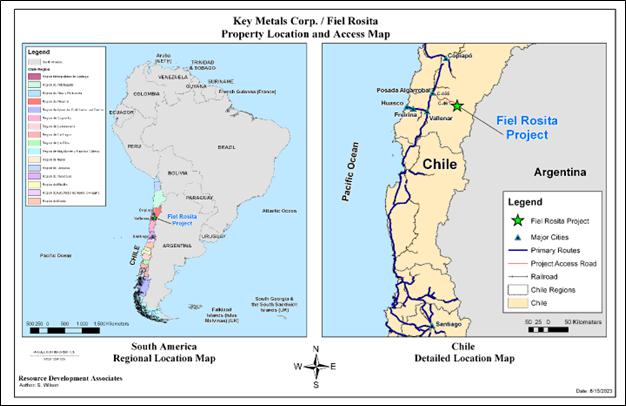
Figure 3-1 Location of the Fiel Rosita Project
This study discusses four initially discovered polymetallic mineralization deposits and leaves additional exploration targets still to be explored.
| 3. | La Viejita Porphyry, and |
| | | |
| 4. | El Chiflón Mineralized Breccia |
Key Metals Corporation Chile SpA (“KM Chile”) is a wholly owned subsidiary of KM US. KM Chile has an exclusive option to acquire an 80% stake in the Concessions, for a total of 158 concessions (all mining), covering a total of 37,755 hectares, and including the proposed project site. As part of the process, the concessions have been inspected by a government-authorized surveyor and are protected by Chilean law through the payment of annual mining license fees.
| 3.5.1 | Mineral Exploration and Joint Venture Agreement |
| 3.5.1.1 | Terms and Conditions |
On August 30th, 2021, KM Chile entered into a Mineral Exploration and Joint Venture Agreement with SQM, by which KM Chile has the exclusive option to acquire up to 80% of the Fiel Rosita Project (the remaining 20% will be held by SQM), by entering into a Joint Venture company with SQM, for and in consideration of the payment of the sum of USD 10,000,000 to SQM, and fulfill exploration expenditures on the Fiel Rosita Project for at least USD 20,000,000, both by December 31st, 2027, as follows:
| a) | On the Effective Date of the agreement (August 30, 2021), after of the signing and delivery of the Mineral Exploration and Joint Venture Agreement by the parties thereto (such event being the “Closing”): |
| i. | an initial payment of USD 75,000, which has been paid on time; and, |
| Key Mining Corp. | |
| S-K 1300 - Technical Report Summary – Fiel Rosita | Page 21 |
| | |
| ii. | the reimbursement of the annual license payments made by SQM on March, 2021, in proportion to the period from the Effective Date until February 28, 2022. |
| b) | On or before August 30th, 2022: |
| i. | a further payment of USD 125,000, which has been paid on time; and, |
| ii. | fulfill exploration expenditures on the Fiel Rosita Project for at least USD 500,000. |
| c) | On or before August 30th, 2023: |
| i. | a further payment of USD 175,000; and, |
| ii. | fulfill exploration expenditures on the Fiel Rosita Project for at least USD 2,000,000. (no later than December 31, 2023). |
| d) | On or before August 30th, 2024: |
| i. | a further payment of USD 500,000; and, |
| ii. | fulfill exploration expenditures on the Fiel Rosita Project for at least USD 3,000,000 (no later than December 31, 2024). |
| e) | On or before August 30th, 2025: |
| i. | a further payment of USD 1,000,000; and, |
| ii. | fulfill exploration expenditures on the Fiel Rosita Project for at least USD 4,000,000. (no later than December 31, 2025). |
| f) | On or before August 30th, 2026: |
| i. | a further payment of USD 2,000,000; and, |
| ii. | fulfill exploration expenditures on the Fiel Rosita Project for at least USD 5,000,000. (no later than December 31, 2026). |
| g) | On or before December 31st, 2027: |
| i. | a further payment of USD 6,125,000; and, |
| ii. | fulfill exploration expenditures on the Fiel Rosita Project for at least USD 5,500,000. |
Except for the payment set forth in subparagraph a) above, all of the foregoing payments and exploration expenditures are optional and KM Chile will not be obligated to make any such payments or expenditures. However, if KM Chile fails to do so as required, the Mineral Exploration and Joint Venture Agreement will terminate upon notice to SQM and KM Chile will not retain any interest in the Concessions. If KM Chile decides to terminate the Mineral Exploration and Joint Venture Agreement within the first 12 months after the Effective Date, it is obliged to pay the complete amount of exploration expenditures to be fulfilled on or before August 30th, 2022. KM Chile has made the August 30, 2022 payment on time.
| Key Mining Corp. | |
| S-K 1300 - Technical Report Summary – Fiel Rosita | Page 22 |
| | |
During the Mineral Exploration and Joint Venture Agreement, KM Chile will be responsible for maintaining the Concessions in good standing, and paying all fees and assessments, and taking such other steps, required in order to do so. Other than the aforesaid maintenance, payments and exploration expenditures obligations, there will be no other mandatory work or expenditure commitments, and any work carried out and expenditures on the Concessions will be at the sole discretion of KM Chile.
Upon the completion of all payments and exploration expenditures described herein, KM Chile and SQM will be deemed to form a joint venture (the “Joint Venture”) for the continued exploration and development of the Fiel Rosita Project and will form a Joint Venture company, in which the initial participating interests of the parties will be 80% for KM Chile and 20% for SQM. Once the Joint Venture company is incorporated, KM Chile shall become the Project operator.
As an element of the essence of Mineral Exploration and Joint Venture Agreement, SQM reserves and will reserve for itself and does not assign, delegate, grant or confer by this agreement - and that it will not contribute, assign, delegate, grant or confer, not even when the Joint Venture company is constituted, authorization, right or expectation of right of any kind or kind whatsoever in favor of KM Chile or the Joint Venture company, as the case may be, or of any person, with respect to the discovery, exploration, exploitation, and control, in part or in full, of one or more Non-Metallic Substances found in the Concessions, hereinafter the “Reserve”.
The Reserve corresponds to an absolute prohibition to explore, exploit, benefit or appropriate all or part of the existing and underlying Non-Metallic Substances in the Concessions, declaring KM Chile, to be sure, that neither the Joint Venture company nor the Joint Venture company may, ever or under any circumstances, extract, in the terms of the second paragraph of article one hundred and sixteen of the Chilean Mining Code, use, enjoy, take advantage of or dispose directly or indirectly or through third parties of the Non-Metallic Substances contained in the Concessions.
As consideration for the contribution in-kind of the Concessions, the Reserve indicated in point 3.5.1.1 and in addition to the 20% participation received by SQM in the Joint Venture company, the Joint Venture company is irrevocably obliged to pay a production royalty to SQM each year.
| Key Mining Corp. | |
| S-K 1300 - Technical Report Summary – Fiel Rosita | Page 23 |
| | |
The royalty will be determined annually, both with respect to the Net Return on Smelting of Precious Metals and with respect to the Net Return on Smelting of Non-Precious Metals for said year, using the “NSR Percentage” indicated for each case:
Table 3-1 NSR Based Royalty
Average Spot Price of Precious Metals | Average Spot Price of Non-Precious Metals | NSR Percentage |
| From US$/oz-Gold | Up to US$/oz-Gold | From US$/lb-Copper | Up to US$/lb-Copper |
| | | | | |
| 0 | 500 | 0 | 1.5 | 1.00% |
| 500 | 700 | 1.50 | 2.00 | 1.00% |
| 700 | 900 | 2.0 | 2.50 | 1.00% |
| 900 | 1,100 | 2.50 | 3.00 | 1.25% |
| 1,100 | 1,300 | 3.00 | 3.50 | 1.50 % |
| 1,300 | 1,500 | 3.50 | 4.00 | 2.00% |
| 1,500 | 1,700 | 4.00 | 4.50 | 2.50% |
| 1,700 | 1,900 | 4.50 | 5.00 | 3.00% |
| 1,900 | 2,000 | 5.00 | 5.50 | 3.00% |
| 2,000 | 2,400 | 5.5 | 6.00 | 3.50% |
| 2,400 | 2,600 | 6.00 | 7.00 | 4.00% |
| 2,600 | 2,800 | 7.00 | 8.00 | 4.50% |
| 2,800 | 3,000 | 8.00 | 9.00 | 5.00% |
| 3,000 | 3,200 | 9.00 | 10.00 | 6.00% |
| > 3,200 | > 10 | 10.00% |
KM Chile holds an exclusive option to acquire, by means of the Joint Venture, an 80% interest on the Concessions, totaling 158 claims, all fully constituted exploitation concessions, which cover a total of 37,755 hectares and include the proposed project site. Concessions are held in the name of SQM.
As part of the grant process, the concessions have been surveyed by a government- licensed surveyor. Concessions are protected under Chilean law by payment of the annual mining license fees. KM Chile advised RDA that all concession fees were current as of June 30, 2023, and will continue to be paid on a regular basis as due, using a formal status tracking system.
A summary of the mineral tenure is provided in Table 3-2 for the Concessions. Figure 3-2 shows the layout and location of the Concessions in Table 3-2. In Table 3-2, “Constituted” means that the concession completed its constitution process, has been fully awarded to the holder (having a final award granted by the Civil Court) which has been registered at the corresponding Mines Registrar and published in the Official Gazette.
| Key Mining Corp. | |
| S-K 1300 - Technical Report Summary – Fiel Rosita | Page 24 |
| | |
Table 3-2 Summary of Mineral Tenure for the Fiel Rosita Concessions
| | | | | | | | | | REGISTRATION DETAILS | |
| | NAME | TYPE | HOLDER | REGION | PROVINCE | COMMUNE | NATIONAL ROLE | STATUS | PAGE | NUMBER | YEAR | REGISTER | REGISTRAR | HA |
| 1 | REINALDO 7 I, 1 AL 30 | EXPLOITATION | SQM S.A. | ATACAMA | HUASCO | VALLENAR | 0330155825 | CONSTITUTED | 534 | 112 | 2017 | PROPERTY | VALLENAR | 300 |
| 2 | OTILIO 1, 1 AL 30 | EXPLOITATION | SQM S.A. | ATACAMA | HUASCO | VALLENAR | 0330156848 | CONSTITUTED | 319 | 100 | 2018 | PROPERTY | VALLENAR | 300 |
| 3 | OTILIO 10, 1 AL 25 | EXPLOITATION | SQM S.A. | ATACAMA | HUASCO | VALLENAR | 0330156880 | CONSTITUTED | 133 | 47 | 2018 | PROPERTY | VALLENAR | 250 |
| 4 | OTILIO 11, 1 AL 30 | EXPLOITATION | SQM S.A. | ATACAMA | HUASCO | VALLENAR | 0330156899 | CONSTITUTED | 137v | 48 | 2018 | PROPERTY | VALLENAR | 241 |
| 5 | OTILIO 14, 1 AL 20 | EXPLOITATION | SQM S.A. | ATACAMA | HUASCO | VALLENAR | 0330156902 | CONSTITUTED | 414 | 128 | 2018 | PROPERTY | VALLENAR | 200 |
| 6 | OTILIO 15, 1 AL 30 | EXPLOITATION | SQM S.A. | ATACAMA | HUASCO | VALLENAR | 0330156910 | CONSTITUTED | 323v | 101 | 2018 | PROPERTY | VALLENAR | 300 |
| 7 | OTILIO 16, 1 AL 30 | EXPLOITATION | SQM S.A. | ATACAMA | HUASCO | VALLENAR | 0330156929 | CONSTITUTED | 150 | 50 | 2018 | PROPERTY | VALLENAR | 300 |
| 8 | OTILIO 20, 1 AL 20 | EXPLOITATION | SQM S.A. | ATACAMA | HUASCO | VALLENAR | 0330156937 | CONSTITUTED | 165 | 53 | 2018 | PROPERTY | VALLENAR | 128 |
| 9 | OTILIO 21, 1 AL 20 | EXPLOITATION | SQM S.A. | ATACAMA | HUASCO | VALLENAR | 0330156945 | CONSTITUTED | 223v | 82 | 2018 | PROPERTY | VALLENAR | 200 |
| 10 | OTILIO 24, 1 AL 37 | EXPLOITATION | SQM S.A. | ATACAMA | HUASCO | VALLENAR | 0330156953 | CONSTITUTED | 365 | 109 | 2018 | PROPERTY | VALLENAR | 310 |
| 11 | OTILIO 25, 1 AL 20 | EXPLOITATION | SQM S.A. | ATACAMA | HUASCO | VALLENAR | 0330156961 | CONSTITUTED | 171 | 54 | 2018 | PROPERTY | VALLENAR | 162 |
| 12 | OTILIO 4, 1 AL 30 | EXPLOITATION | SQM S.A. | ATACAMA | HUASCO | VALLENAR | 0330156856 | CONSTITUTED | 194v | 77 | 2018 | PROPERTY | VALLENAR | 260 |
| 13 | OTILIO 5, 1 AL 30 | EXPLOITATION | SQM S.A. | ATACAMA | HUASCO | VALLENAR | 0330156864 | CONSTITUTED | 201v | 78 | 2018 | PROPERTY | VALLENAR | 300 |
| 14 | OTILIO 6, 1 AL 30 | EXPLOITATION | SQM S.A. | ATACAMA | HUASCO | VALLENAR | 0330156872 | CONSTITUTED | 121 | 45 | 2018 | PROPERTY | VALLENAR | 275 |
| 15 | OTILIO 12, 1 AL 30 | EXPLOITATION | SQM S.A. | ATACAMA | HUASCO | VALLENAR | 0330157046 | CONSTITUTED | 144v | 49 | 2018 | PROPERTY | VALLENAR | 220 |
| 16 | OTILIO 13, 1 AL 30 | EXPLOITATION | SQM S.A. | ATACAMA | HUASCO | VALLENAR | 0330157054 | CONSTITUTED | 212v | 80 | 2018 | PROPERTY | VALLENAR | 300 |
| 17 | OTILIO 17, 1 AL 30 | EXPLOITATION | SQM S.A. | ATACAMA | HUASCO | VALLENAR | 0330157062 | CONSTITUTED | 218v | 81 | 2018 | PROPERTY | VALLENAR | 300 |
| 18 | OTILIO 18, 1 AL 40 | EXPLOITATION | SQM S.A. | ATACAMA | HUASCO | VALLENAR | 0330157070 | CONSTITUTED | 154v | 51 | 2018 | PROPERTY | VALLENAR | 400 |
| 19 | OTILIO 19, 1 AL 30 | EXPLOITATION | SQM S.A. | ATACAMA | HUASCO | VALLENAR | 0330157089 | CONSTITUTED | 160 | 52 | 2018 | PROPERTY | VALLENAR | 250 |
| Key Mining Corp. | |
| S-K 1300 - Technical Report Summary – Fiel Rosita | Page 25 |
| | |
| | | | | | | | | | REGISTRATION DETAILS | |
| | NAME | TYPE | HOLDER | REGION | PROVINCE | COMMUNE | NATIONAL ROLE | STATUS | PAGE | NUMBER | YEAR | REGISTER | REGISTRAR | HA |
| 20 | OTILIO 2, 1 AL 35 | EXPLOITATION | SQM S.A. | ATACAMA | HUASCO | VALLENAR | 0330157011 | CONSTITUTED | 115 | 44 | 2018 | PROPERTY | VALLENAR | 345 |
| 21 | OTILIO 22, 1 AL 20 | EXPLOITATION | SQM S.A. | ATACAMA | HUASCO | VALLENAR | 0330157097 | CONSTITUTED | 228v | 83 | 2018 | PROPERTY | VALLENAR | 200 |
| 22 | OTILIO 23, 1 AL 18 | EXPLOITATION | SQM S.A. | ATACAMA | HUASCO | VALLENAR | 0330157100 | CONSTITUTED | 360 | 108 | 2018 | PROPERTY | VALLENAR | 152 |
| 23 | OTILIO 7, 1 AL 30 | EXPLOITATION | SQM S.A. | ATACAMA | HUASCO | VALLENAR | 033015702K | CONSTITUTED | 206v | 79 | 2018 | PROPERTY | VALLENAR | 300 |
| 24 | OTILIO 9, 1 AL 30 | EXPLOITATION | SQM S.A. | ATACAMA | HUASCO | VALLENAR | 0330157038 | CONSTITUTED | 353v | 107 | 2018 | PROPERTY | VALLENAR | 193 |
| 25 | OTILIO 8, 1 AL 30 | EXPLOITATION | SQM S.A. | ATACAMA | HUASCO | VALLENAR | 0330157143 | CONSTITUTED | 128 | 46 | 2018 | PROPERTY | VALLENAR | 300 |
| 26 | MARISELA II, 1 AL 5 | EXPLOITATION | SQM S.A. | ATACAMA | HUASCO | VALLENAR | 0330152818 | CONSTITUTED | 1694v | 396 | 2015 | PROPERTY | VALLENAR | 30 |
| 27 | BOMBILLA 5 I, 1 AL 40 | EXPLOITATION | SQM S.A. | ATACAMA | HUASCO | VALLENAR | 0330152303 | CONSTITUTED | 247v | 65 | 2016 | PROPERTY | VALLENAR | 400 |
| 28 | BOMBILLA 6 I, 1 AL 80 | EXPLOITATION | SQM S.A. | ATACAMA | HUASCO | VALLENAR | 0330152311 | CONSTITUTED | 254v | 66 | 2016 | PROPERTY | VALLENAR | 80 |
| 29 | REINALDO 14, 1 AL 20 | EXPLOITATION | SQM S.A. | ATACAMA | HUASCO | VALLENAR | 0330155493 | CONSTITUTED | 484v | 103 | 2017 | PROPERTY | VALLENAR | 200 |
| 30 | REINALDO 15, 1 AL 30 | EXPLOITATION | SQM S.A. | ATACAMA | HUASCO | VALLENAR | 0330155485 | CONSTITUTED | 473 | 101 | 2017 | PROPERTY | VALLENAR | 300 |
| 31 | REINALDO 16, 1 AL 30 | EXPLOITATION | SQM S.A. | ATACAMA | HUASCO | VALLENAR | 0330155477 | CONSTITUTED | 490 | 104 | 2017 | PROPERTY | VALLENAR | 300 |
| 32 | REINALDO 17, 1 AL 30 | EXPLOITATION | SQM S.A. | ATACAMA | HUASCO | VALLENAR | 0330155469 | CONSTITUTED | 395 | 87 | 2017 | PROPERTY | VALLENAR | 300 |
| 33 | REINALDO 18, 1 AL 30 | EXPLOITATION | SQM S.A. | ATACAMA | HUASCO | VALLENAR | 0330155264 | CONSTITUTED | 429v | 93 | 2017 | PROPERTY | VALLENAR | 300 |
| 34 | REINALDO 19, 1 AL 30 | EXPLOITATION | SQM S.A. | ATACAMA | HUASCO | VALLENAR | 0330155450 | CONSTITUTED | 440v | 95 | 2017 | PROPERTY | VALLENAR | 300 |
| 35 | REINALDO 20, 1 AL 30 | EXPLOITATION | SQM S.A. | ATACAMA | HUASCO | VALLENAR | 0330155442 | CONSTITUTED | 446 | 96 | 2017 | PROPERTY | VALLENAR | 300 |
| 36 | REINALDO 21, 1 AL 30 | EXPLOITATION | SQM S.A. | ATACAMA | HUASCO | VALLENAR | 0330155434 | CONSTITUTED | 496 | 105 | 2017 | PROPERTY | VALLENAR | 300 |
| 37 | REINALDO 22, 1 AL 30 | EXPLOITATION | SQM S.A. | ATACAMA | HUASCO | VALLENAR | 0330155426 | CONSTITUTED | 851 | 185 | 2017 | PROPERTY | VALLENAR | 300 |
| 38 | REINALDO 23, 1 AL 30 | EXPLOITATION | SQM S.A. | ATACAMA | HUASCO | VALLENAR | 0330155418 | CONSTITUTED | 435 | 94 | 2017 | PROPERTY | VALLENAR | 300 |
| Key Mining Corp. | |
| S-K 1300 - Technical Report Summary – Fiel Rosita | Page 26 |
| | |
| | | | | | | | | | REGISTRATION DETAILS | |
| | NAME | TYPE | HOLDER | REGION | PROVINCE | COMMUNE | NATIONAL ROLE | STATUS | PAGE | NUMBER | YEAR | REGISTER | REGISTRAR | HA |
| 39 | REINALDO 24, 1 AL 30 | EXPLOITATION | SQM S.A. | ATACAMA | HUASCO | VALLENAR | 033015540K | CONSTITUTED | 501v | 106 | 2017 | PROPERTY | VALLENAR | 300 |
| 40 | REINALDO 25, 1 AL 30 | EXPLOITATION | SQM S.A. | ATACAMA | HUASCO | VALLENAR | 0330155396 | CONSTITUTED | 856v | 186 | 2017 | PROPERTY | VALLENAR | 300 |
| 41 | REINALDO 26, 1 AL 30 | EXPLOITATION | SQM S.A. | ATACAMA | HUASCO | VALLENAR | 0330155272 | CONSTITUTED | 862 | 187 | 2017 | PROPERTY | VALLENAR | 300 |
| 42 | REINALDO 28, 1 AL 30 | EXPLOITATION | SQM S.A. | ATACAMA | HUASCO | VALLENAR | 0330155280 | CONSTITUTED | 389 | 86 | 2017 | PROPERTY | VALLENAR | 300 |
| 43 | REINALDO 29, 1 AL 30 | EXPLOITATION | SQM S.A. | ATACAMA | HUASCO | VALLENAR | 033015554K | CONSTITUTED | 383 | 85 | 2017 | PROPERTY | VALLENAR | 300 |
| 44 | REINALDO 30, 1 AL 30 | EXPLOITATION | SQM S.A. | ATACAMA | HUASCO | VALLENAR | 0330155299 | CONSTITUTED | 377 | 84 | 2017 | PROPERTY | VALLENAR | 300 |
| 45 | REINALDO 31, 1 AL 26 | EXPLOITATION | SQM S.A. | ATACAMA | HUASCO | VALLENAR | 0330155388 | CONSTITUTED | 423v | 92 | 2017 | PROPERTY | VALLENAR | 236 |
| 46 | REINALDO 32, 1 AL 30 | EXPLOITATION | SQM S.A. | ATACAMA | HUASCO | VALLENAR | 0330155302 | CONSTITUTED | 371 | 83 | 2017 | PROPERTY | VALLENAR | 300 |
| 47 | REINALDO 33, 1 AL 30 | EXPLOITATION | SQM S.A. | ATACAMA | HUASCO | VALLENAR | 0330155310 | CONSTITUTED | 418 | 91 | 2017 | PROPERTY | VALLENAR | 300 |
| 48 | REINALDO 34, 1 AL 30 | EXPLOITATION | SQM S.A. | ATACAMA | HUASCO | VALLENAR | 0330155329 | CONSTITUTED | 412v | 90 | 2017 | PROPERTY | VALLENAR | 300 |
| 49 | REINALDO 35, 1 AL 29 | EXPLOITATION | SQM S.A. | ATACAMA | HUASCO | VALLENAR | 033015537K | CONSTITUTED | 512 | 108 | 2017 | PROPERTY | VALLENAR | 265 |
| 50 | REINALDO 36, 1 AL 12 | EXPLOITATION | SQM S.A. | ATACAMA | HUASCO | VALLENAR | 0330155361 | CONSTITUTED | 407 | 89 | 2017 | PROPERTY | VALLENAR | 120 |
| 51 | REINALDO 37, 1 AL 9 | EXPLOITATION | SQM S.A. | ATACAMA | HUASCO | VALLENAR | 0330155353 | CONSTITUTED | 451 | 97 | 2017 | PROPERTY | VALLENAR | 44 |
| 52 | REINALDO 37, 10 AL 18 | EXPLOITATION | SQM S.A. | ATACAMA | HUASCO | VALLENAR | 0330155345 | CONSTITUTED | 457 | 98 | 2017 | PROPERTY | VALLENAR | 45 |
| 53 | REINALDO 38, 1 AL 5 | EXPLOITATION | SQM S.A. | ATACAMA | HUASCO | VALLENAR | 0330155337 | CONSTITUTED | 462 | 99 | 2017 | PROPERTY | VALLENAR | 25 |
| 54 | REINALDO 6, 1 AL 40 | EXPLOITATION | SQM S.A. | ATACAMA | HUASCO | VALLENAR | 0330155523 | CONSTITUTED | 401 | 88 | 2017 | PROPERTY | VALLENAR | 400 |
| 55 | REINALDO 7, 1 AL 20 | EXPLOITATION | SQM S.A. | ATACAMA | HUASCO | VALLENAR | 0330155515 | CONSTITUTED | 479 | 102 | 2017 | PROPERTY | VALLENAR | 200 |
| 56 | REINALDO 8, 1 AL 30 | EXPLOITATION | SQM S.A. | ATACAMA | HUASCO | VALLENAR | 0330155507 | CONSTITUTED | 467v | 100 | 2017 | PROPERTY | VALLENAR | 300 |
| Key Mining Corp. | |
| S-K 1300 - Technical Report Summary – Fiel Rosita | Page 27 |
| | |
| | | | | | | | | | REGISTRATION DETAILS | |
| | NAME | TYPE | HOLDER | REGION | PROVINCE | COMMUNE | NATIONAL ROLE | STATUS | PAGE | NUMBER | YEAR | REGISTER | REGISTRAR | HA |
| 57 | REINALDO 27, 1 AL 40 | EXPLOITATION | SQM S.A. | ATACAMA | HUASCO | VALLENAR | 0330155833 | CONSTITUTED | 507 | 107 | 2017 | PROPERTY | VALLENAR | 400 |
| 58 | REINALDO 10, 1 AL 40 | EXPLOITATION | SQM S.A. | ATACAMA | HUASCO | VALLENAR | 0330156058 | CONSTITUTED | 544 | 114 | 2017 | PROPERTY | VALLENAR | 400 |
| 59 | REINALDO 11, 1 AL 30 | EXPLOITATION | SQM S.A. | ATACAMA | HUASCO | VALLENAR | 0330156066 | CONSTITUTED | 548v | 115 | 2017 | PROPERTY | VALLENAR | 200 |
| 60 | REINALDO 13, 1 AL 30 | EXPLOITATION | SQM S.A. | ATACAMA | HUASCO | VALLENAR | 0330156074 | CONSTITUTED | 558 | 117 | 2017 | PROPERTY | VALLENAR | 300 |
| 61 | REINALDO 12, 1 AL 20 | EXPLOITATION | SQM S.A. | ATACAMA | HUASCO | VALLENAR | 0330156201 | CONSTITUTED | 553 | 116 | 2017 | PROPERTY | VALLENAR | 200 |
| 62 | REINALDO 9, 1 AL 10 | EXPLOITATION | SQM S.A. | ATACAMA | HUASCO | VALLENAR | 0330156198 | CONSTITUTED | 539 | 113 | 2017 | PROPERTY | VALLENAR | 100 |
| 63 | ROSITA 44, 1 AL 18 | EXPLOITATION | SQM S.A. | ATACAMA | HUASCO | VALLENAR | 0330151501 | CONSTITUTED | 902 | 198 | 2015 | PROPERTY | VALLENAR | 172 |
| 64 | ROSITA 45, 1 AL 20 | EXPLOITATION | SQM S.A. | ATACAMA | HUASCO | VALLENAR | 0330152540 | CONSTITUTED | 907 | 199 | 2015 | PROPERTY | VALLENAR | 160 |
| 65 | ROSITA 46, 1 AL 10 | EXPLOITATION | SQM S.A. | ATACAMA | HUASCO | VALLENAR | 033015151K | CONSTITUTED | 913 | 200 | 2015 | PROPERTY | VALLENAR | 100 |
| 66 | ROSITA 47, 1 AL 10 | EXPLOITATION | SQM S.A. | ATACAMA | HUASCO | VALLENAR | 0330151641 | CONSTITUTED | 917v | 201 | 2015 | PROPERTY | VALLENAR | 100 |
| 67 | ROSITA 48, 1 AL 30 | EXPLOITATION | SQM S.A. | ATACAMA | HUASCO | VALLENAR | 0330151528 | CONSTITUTED | 922 | 202 | 2015 | PROPERTY | VALLENAR | 300 |
| 68 | ROSITA 49, 1 AL 30 | EXPLOITATION | SQM S.A. | ATACAMA | HUASCO | VALLENAR | 0330151536 | CONSTITUTED | 927 | 203 | 2015 | PROPERTY | VALLENAR | 300 |
| 69 | ROSITA 50, 1 AL 10 | EXPLOITATION | SQM S.A. | ATACAMA | HUASCO | VALLENAR | 0330151544 | CONSTITUTED | 932 | 204 | 2015 | PROPERTY | VALLENAR | 100 |
| 70 | ROSITA 51, 1 AL 10 | EXPLOITATION | SQM S.A. | ATACAMA | HUASCO | VALLENAR | 0330151552 | CONSTITUTED | 936v | 205 | 2015 | PROPERTY | VALLENAR | 100 |
| 71 | ROSITA 52, 1 AL 20 | EXPLOITATION | SQM S.A. | ATACAMA | HUASCO | VALLENAR | 0330151560 | CONSTITUTED | 941 | 206 | 2015 | PROPERTY | VALLENAR | 172 |
| 72 | ROSITA 53, 1 AL 30 | EXPLOITATION | SQM S.A. | ATACAMA | HUASCO | VALLENAR | 0330151579 | CONSTITUTED | 946 | 207 | 2015 | PROPERTY | VALLENAR | 300 |
| 73 | ROSITA 54, 1 AL 20 | EXPLOITATION | SQM S.A. | ATACAMA | HUASCO | VALLENAR | 0330151587 | CONSTITUTED | 951v | 208 | 2015 | PROPERTY | VALLENAR | 200 |
| 74 | ROSITA 55, 1 AL 20 | EXPLOITATION | SQM S.A. | ATACAMA | HUASCO | VALLENAR | 0330151595 | CONSTITUTED | 955v | 209 | 2015 | PROPERTY | VALLENAR | 200 |
| Key Mining Corp. | |
| S-K 1300 - Technical Report Summary – Fiel Rosita | Page 28 |
| | |
| | | | | | | | | | REGISTRATION DETAILS | |
| | NAME | TYPE | HOLDER | REGION | PROVINCE | COMMUNE | NATIONAL ROLE | STATUS | PAGE | NUMBER | YEAR | REGISTER | REGISTRAR | HA |
| 75 | ROSITA 56, 1 AL 6 | EXPLOITATION | SQM S.A. | ATACAMA | HUASCO | VALLENAR | 0330151609 | CONSTITUTED | 960 | 210 | 2015 | PROPERTY | VALLENAR | 50 |
| 76 | ROSITA 57, 1 AL 30 | EXPLOITATION | SQM S.A. | ATACAMA | HUASCO | VALLENAR | 0330151617 | CONSTITUTED | 965 | 211 | 2015 | PROPERTY | VALLENAR | 284 |
| 77 | ROSITA 58, 1 AL 20 | EXPLOITATION | SQM S.A. | ATACAMA | HUASCO | VALLENAR | 0330151625 | CONSTITUTED | 971 | 212 | 2015 | PROPERTY | VALLENAR | 200 |
| 78 | ROSITA 59, 1 AL 20 | EXPLOITATION | SQM S.A. | ATACAMA | HUASCO | VALLENAR | 0330151633 | CONSTITUTED | 976 | 213 | 2015 | PROPERTY | VALLENAR | 200 |
| 79 | BOMBILLA 3, 1 AL 30 | EXPLOITATION | SQM S.A. | ATACAMA | HUASCO | VALLENAR | 0330150203 | CONSTITUTED | 1361v | 305 | 2014 | PROPERTY | VALLENAR | 300 |
| 80 | BOMBILLA 5, 1 AL 30 | EXPLOITATION | SQM S.A. | ATACAMA | HUASCO | VALLENAR | 0330150211 | CONSTITUTED | 304 | 67 | 2015 | PROPERTY | VALLENAR | 300 |
| 81 | BOMBILLA 10, 1 AL 30 | EXPLOITATION | SQM S.A. | ATACAMA | HUASCO | VALLENAR | 0330150297 | CONSTITUTED | 1371v | 307 | 2014 | PROPERTY | VALLENAR | 300 |
| 82 | BOMBILLA 11, 1 AL 16 | EXPLOITATION | SQM S.A. | ATACAMA | HUASCO | VALLENAR | 0330150300 | CONSTITUTED | 536 | 132 | 2015 | PROPERTY | VALLENAR | 148 |
| 83 | BOMBILLA 4, 1 AL 30 | EXPLOITATION | SQM S.A. | ATACAMA | HUASCO | VALLENAR | 0330150262 | CONSTITUTED | 1366v | 306 | 2014 | PROPERTY | VALLENAR | 300 |
| 84 | BOMBILLA 6, 1 AL 30 | EXPLOITATION | SQM S.A. | ATACAMA | HUASCO | VALLENAR | 0330150270 | CONSTITUTED | 310 | 68 | 2015 | PROPERTY | VALLENAR | 300 |
| 85 | BOMBILLA 8, 1 AL 30 | EXPLOITATION | SQM S.A. | ATACAMA | HUASCO | VALLENAR | 0330150289 | CONSTITUTED | 317 | 69 | 2015 | PROPERTY | VALLENAR | 300 |
| 86 | CHIFLON 5, 1 AL 14 | EXPLOITATION | SQM S.A. | ATACAMA | HUASCO | VALLENAR | 0330144114 | CONSTITUTED | 136 | 38 | 2013 | PROPERTY | VALLENAR | 140 |
| 87 | CHIFLON 1, 1 AL 30 | EXPLOITATION | SQM S.A. | ATACAMA | HUASCO | VALLENAR | 0330149701 | CONSTITUTED | 1222 | 267 | 2014 | PROPERTY | VALLENAR | 300 |
| 88 | CHIFLON 2, 1 AL 30 | EXPLOITATION | SQM S.A. | ATACAMA | HUASCO | VALLENAR | 033014971K | CONSTITUTED | 886 | 192 | 2014 | PROPERTY | VALLENAR | 300 |
| 89 | CHIFLON 3, 1 AL 17 | EXPLOITATION | SQM S.A. | ATACAMA | HUASCO | VALLENAR | 0330149728 | CONSTITUTED | 1227 | 268 | 2014 | PROPERTY | VALLENAR | 170 |
| 90 | BOMBILLA 1, 1 AL 20 | EXPLOITATION | SQM S.A. | ATACAMA | HUASCO | VALLENAR | 0330148993 | CONSTITUTED | 669 | 131 | 2014 | PROPERTY | VALLENAR | 200 |
| 91 | BOMBILLA 2, 1 AL 10 | EXPLOITATION | SQM S.A. | ATACAMA | HUASCO | VALLENAR | 0330149000 | CONSTITUTED | 674 | 132 | 2014 | PROPERTY | VALLENAR | 100 |
| 92 | PORTEZUELO II, 1 AL 10 | EXPLOITATION | SQM S.A. | ATACAMA | HUASCO | VALLENAR | 033013464K | CONSTITUTED | 70 | 12 | 2004 | PROPERTY | VALLENAR | 100 |
| Key Mining Corp. | |
| S-K 1300 - Technical Report Summary – Fiel Rosita | Page 29 |
| | |
| | | | | | | | | | REGISTRATION DETAILS | |
| | NAME | TYPE | HOLDER | REGION | PROVINCE | COMMUNE | NATIONAL ROLE | STATUS | PAGE | NUMBER | YEAR | REGISTER | REGISTRAR | HA |
| 93 | MARISELA, 1 AL 5 | EXPLOITATION | SQM S.A. | ATACAMA | HUASCO | VALLENAR | 0330134569 | CONSTITUTED | 1216 | 266 | 2014 | PROPERTY | VALLENAR | 10 |
| 94 | TACO, 1 AL 62 | EXPLOITATION | SQM S.A. | ATACAMA | HUASCO | VALLENAR | 0330129875 | CONSTITUTED | 24 | 5 | 2000 | PROPERTY | VALLENAR | 596 |
| 95 | PIRCA 6, 1 AL 5 | EXPLOITATION | SQM S.A. | ATACAMA | HUASCO | VALLENAR | 033012914K | CONSTITUTED | 1038v | 195 | 1999 | PROPERTY | VALLENAR | 50 |
| 96 | CALVO, 11 AL 48 | EXPLOITATION | SQM S.A. | ATACAMA | HUASCO | VALLENAR | 0330128976 | CONSTITUTED | 213v | 50 | 2001 | PROPERTY | VALLENAR | 356 |
| 97 | PIRCA 8 II, 1 AL 20 | EXPLOITATION | SQM S.A. | ATACAMA | HUASCO | VALLENAR | 0330128968 | CONSTITUTED | 777v | 144 | 1999 | PROPERTY | VALLENAR | 200 |
| 98 | PIRCA 5 II, 1 AL 10 | EXPLOITATION | SQM S.A. | ATACAMA | HUASCO | VALLENAR | 0330127996 | CONSTITUTED | 724v | 128 | 1999 | PROPERTY | VALLENAR | 100 |
| 99 | PIRCA 4 II, 1 AL 30 | EXPLOITATION | SQM S.A. | ATACAMA | HUASCO | VALLENAR | 0330127988 | CONSTITUTED | 719v | 127 | 1999 | PROPERTY | VALLENAR | 300 |
| 100 | PELADO 19 II, 1 AL 40 | EXPLOITATION | SQM S.A. | ATACAMA | HUASCO | VALLENAR | 0330128003 | CONSTITUTED | 468v | 85 | 2000 | PROPERTY | VALLENAR | 400 |
| 101 | ERIKA 3, 1 AL 20 | EXPLOITATION | SQM S.A. | ATACAMA | HUASCO | VALLENAR | 0330126558 | CONSTITUTED | 310v | 65 | 1997 | PROPERTY | VALLENAR | 200 |
| 102 | ERIKA 4, 1 AL 20 | EXPLOITATION | SQM S.A. | ATACAMA | HUASCO | VALLENAR | 0330126566 | CONSTITUTED | 316 | 66 | 1997 | PROPERTY | VALLENAR | 200 |
| 103 | GALLO I, 1 AL 30 | EXPLOITATION | SQM S.A. | ATACAMA | HUASCO | VALLENAR | 0330125977 | CONSTITUTED | 321v | 67 | 1997 | PROPERTY | VALLENAR | 300 |
| 104 | INGENIO, 1 AL 16 | EXPLOITATION | SQM S.A. | ATACAMA | HUASCO | VALLENAR | 0330125918 | CONSTITUTED | 1190 | 253 | 2013 | PROPERTY | VALLENAR | 96 |
| 105 | PIRCA 7, 1 AL 20 | EXPLOITATION | SQM S.A. | ATACAMA | HUASCO | VALLENAR | 0330125837 | CONSTITUTED | 121v | 17 | 1997 | PROPERTY | VALLENAR | 200 |
| 106 | ERIKA 10, 1 AL 10 | EXPLOITATION | SQM S.A. | ATACAMA | HUASCO | VALLENAR | 0330125551 | CONSTITUTED | 267v | 49 | 1997 | PROPERTY | VALLENAR | 100 |
| 107 | ERIKA 11, 1 AL 10 | EXPLOITATION | SQM S.A. | ATACAMA | HUASCO | VALLENAR | 033012556K | CONSTITUTED | 273 | 50 | 1997 | PROPERTY | VALLENAR | 100 |
| 108 | SUERTE 1, 1 AL 10 | EXPLOITATION | SQM S.A. | ATACAMA | HUASCO | VALLENAR | 0330125543 | CONSTITUTED | 262 | 48 | 1997 | PROPERTY | VALLENAR | 100 |
| 109 | ERIZO 3, 1 AL 20 | EXPLOITATION | SQM S.A. | ATACAMA | HUASCO | VALLENAR | 0330125284 | CONSTITUTED | 342v | 89 | 1995 | PROPERTY | VALLENAR | 200 |
| 110 | ERIZO 4, 1 AL 20 | EXPLOITATION | SQM S.A. | ATACAMA | HUASCO | VALLENAR | 0330125292 | CONSTITUTED | 156v | 41 | 1996 | PROPERTY | VALLENAR | 200 |
| 111 | FORTUNA 1, 1 AL 10 | EXPLOITATION | SQM S.A. | ATACAMA | HUASCO | VALLENAR | 0330125020 | CONSTITUTED | 299 | 78 | 1995 | PROPERTY | VALLENAR | 100 |
| 112 | ERIZO 10, 1 AL 10 | EXPLOITATION | SQM S.A. | ATACAMA | HUASCO | VALLENAR | 0330125039 | CONSTITUTED | 274v | 72 | 1995 | PROPERTY | VALLENAR | 100 |
| Key Mining Corp. | |
| S-K 1300 - Technical Report Summary – Fiel Rosita | Page 30 |
| | |
| | | | | | | | | | REGISTRATION DETAILS | |
| | NAME | TYPE | HOLDER | REGION | PROVINCE | COMMUNE | NATIONAL ROLE | STATUS | PAGE | NUMBER | YEAR | REGISTER | REGISTRAR | HA |
| 113 | ERIZO 11, 1 AL 10 | EXPLOITATION | SQM S.A. | ATACAMA | HUASCO | VALLENAR | 0330125047 | CONSTITUTED | 279v | 73 | 1995 | PROPERTY | VALLENAR | 100 |
| 114 | PELADO, 41 AL 60 | EXPLOITATION | SQM S.A. | ATACAMA | HUASCO | VALLENAR | 0330124776 | CONSTITUTED | 91v | 27 | 1995 | PROPERTY | VALLENAR | 200 |
| 115 | PELADO, 61 AL 80 | EXPLOITATION | SQM S.A. | ATACAMA | HUASCO | VALLENAR | 0330124784 | CONSTITUTED | 96v | 28 | 1995 | PROPERTY | VALLENAR | 200 |
| 116 | ERIZO, 71 AL 80 | EXPLOITATION | SQM S.A. | ATACAMA | HUASCO | VALLENAR | 0330124830 | CONSTITUTED | 250 | 68 | 1995 | PROPERTY | VALLENAR | 100 |
| 117 | ERIZO, 81 AL 110 | EXPLOITATION | SQM S.A. | ATACAMA | HUASCO | VALLENAR | 0330124849 | CONSTITUTED | 107v | 30 | 1995 | PROPERTY | VALLENAR | 300 |
| 118 | ERIZO, 31 AL 50 | EXPLOITATION | SQM S.A. | ATACAMA | HUASCO | VALLENAR | 0330124822 | CONSTITUTED | 101v | 29 | 1995 | PROPERTY | VALLENAR | 200 |
| 119 | ERIZO, 11 AL 30 | EXPLOITATION | SQM S.A. | ATACAMA | HUASCO | VALLENAR | 0330124814 | CONSTITUTED | 86v | 26 | 1995 | PROPERTY | VALLENAR | 200 |
| 120 | PELADO, 121 AL 150 | EXPLOITATION | SQM S.A. | ATACAMA | HUASCO | VALLENAR | 0330124792 | CONSTITUTED | 207 | 53 | 1995 | PROPERTY | VALLENAR | 300 |
| 121 | PELADO, 151 AL 180 | EXPLOITATION | SQM S.A. | ATACAMA | HUASCO | VALLENAR | 0330124806 | CONSTITUTED | 192 | 46 | 1995 | PROPERTY | VALLENAR | 300 |
| 122 | PELADO, 51 AL 90 | EXPLOITATION | SQM S.A. | ATACAMA | HUASCO | VALLENAR | 033012458K | CONSTITUTED | 201 | 52 | 1995 | PROPERTY | VALLENAR | 400 |
| 123 | PELADO, 1 AL 10 | EXPLOITATION | SQM S.A. | ATACAMA | HUASCO | VALLENAR | 0330124563 | CONSTITUTED | 135v | 35 | 1995 | PROPERTY | VALLENAR | 100 |
| 124 | PELADO, 11 AL 50 | EXPLOITATION | SQM S.A. | ATACAMA | HUASCO | VALLENAR | 0330124571 | CONSTITUTED | 332 | 63 | 2000 | PROPERTY | VALLENAR | 356 |
| 125 | FELISA, 31 AL 70 | EXPLOITATION | SQM S.A. | ATACAMA | HUASCO | VALLENAR | 0330124601 | CONSTITUTED | 314v | 81 | 1995 | PROPERTY | VALLENAR | 400 |
| 126 | FELISA, 1 AL 30 | EXPLOITATION | SQM S.A. | ATACAMA | HUASCO | VALLENAR | 0330124598 | CONSTITUTED | 309 | 80 | 1995 | PROPERTY | VALLENAR | 300 |
| 127 | KIKE, 101 AL 160 | EXPLOITATION | SQM S.A. | ATACAMA | HUASCO | VALLENAR | 033012444K | CONSTITUTED | 31 | 6 | 1997 | PROPERTY | VALLENAR | 600 |
| 128 | REEMPLAZO, 201 AL 260 | EXPLOITATION | SQM S.A. | ATACAMA | HUASCO | VALLENAR | 0330124466 | CONSTITUTED | 81 | 25 | 1995 | PROPERTY | VALLENAR | 500 |
| 129 | ESTER I, 1 AL 13 | EXPLOITATION | SQM S.A. | ATACAMA | HUASCO | VALLENAR | 0330123192 | CONSTITUTED | 320v | 82 | 1995 | PROPERTY | VALLENAR | 104 |
| 130 | ESTER II, 1 AL 24 | EXPLOITATION | SQM S.A. | ATACAMA | HUASCO | VALLENAR | 0330123206 | CONSTITUTED | 294 | 77 | 1995 | PROPERTY | VALLENAR | 240 |
| 131 | FORTUNA 2, 1 AL 40 | EXPLOITATION | SQM S.A. | ATACAMA | HUASCO | VALLENAR | 0330123001 | CONSTITUTED | 304 | 79 | 1995 | PROPERTY | VALLENAR | 400 |
| 132 | GALLO II, 1 AL 30 | EXPLOITATION | SQM S.A. | ATACAMA | HUASCO | VALLENAR | 0330125985 | CONSTITUTED | 43v | 8 | 1997 | PROPERTY | VALLENAR | 300 |
| Key Mining Corp. | |
| S-K 1300 - Technical Report Summary – Fiel Rosita | Page 31 |
| | |
| | | | | | | | | | REGISTRATION DETAILS | |
| | NAME | TYPE | HOLDER | REGION | PROVINCE | COMMUNE | NATIONAL ROLE | STATUS | PAGE | NUMBER | YEAR | REGISTER | REGISTRAR | HA |
| 133 | CAROLA, 1 AL 10 | EXPLOITATION | SQM S.A. | ATACAMA | HUASCO | VALLENAR | 0330123214 | CONSTITUTED | 348 | 90 | 1995 | PROPERTY | VALLENAR | 100 |
| 134 | PELADO 5, 1 AL 10 | EXPLOITATION | SQM S.A. | ATACAMA | HUASCO | VALLENAR | 0330122919 | CONSTITUTED | 285v | 112 | 1992 | PROPERTY | VALLENAR | 100 |
| 135 | PELADO 4, 1 AL 10 | EXPLOITATION | SQM S.A. | ATACAMA | HUASCO | VALLENAR | 0330121971 | CONSTITUTED | 280v | 111 | 1992 | PROPERTY | VALLENAR | 100 |
| 136 | CABELLOS 6, 1 AL 30 | EXPLOITATION | SQM S.A. | ATACAMA | HUASCO | VALLENAR | 0330121874 | CONSTITUTED | 151 | 39 | 1992 | PROPERTY | VALLENAR | 300 |
| 137 | CABELLOS 7, 1 AL 30 | EXPLOITATION | SQM S.A. | ATACAMA | HUASCO | VALLENAR | 0330121882 | CONSTITUTED | 156 | 40 | 1992 | PROPERTY | VALLENAR | 300 |
| 138 | REINALDO 1, 1 AL 20 | EXPLOITATION | SQM S.A. | ATACAMA | COPIAPO | TIERRA AMARILLA | 0320372372 | CONSTITUTED | 1252 | 393 | 2017 | PROPERTY | COPIAPO | 200 |
| 139 | REINALDO 2, 1 AL 30 | EXPLOITATION | SQM S.A. | ATACAMA | COPIAPO | TIERRA AMARILLA | 0320372364 | CONSTITUTED | 1257v | 394 | 2017 | PROPERTY | COPIAPO | 300 |
| 140 | REINALDO 3, 1 AL 30 | EXPLOITATION | SQM S.A. | ATACAMA | COPIAPO | TIERRA AMARILLA | 0320372356 | CONSTITUTED | 1263v | 395 | 2017 | PROPERTY | COPIAPO | 300 |
| 141 | REINALDO 4, 1 AL 30 | EXPLOITATION | SQM S.A. | ATACAMA | COPIAPO | TIERRA AMARILLA | 0320372348 | CONSTITUTED | 1269v | 396 | 2017 | PROPERTY | COPIAPO | 300 |
| 142 | CHIFLON NORTE 1, 1 AL 40 | EXPLOITATION | SQM S.A. | ATACAMA | COPIAPO | TIERRA AMARILLA | 0320370159 | CONSTITUTED | 1677v | 322 | 2015 | PROPERTY | COPIAPO | 400 |
| 143 | PAPELA 11, 1 AL 20 | EXPLOITATION | SQM S.A. | ATACAMA | COPIAPO | TIERRA AMARILLA | 032036910K | CONSTITUTED | 3298v | 792 | 2014 | PROPERTY | COPIAPO | 200 |
| 144 | GIPSY 10, 1 AL 30 | EXPLOITATION | SQM S.A. | ATACAMA | COPIAPO | TIERRA AMARILLA | 0320342244 | CONSTITUTED | 3884v | 977 | 2014 | PROPERTY | COPIAPO | 300 |
| 145 | GIPSY 7, 1 AL 30 | EXPLOITATION | SQM S.A. | ATACAMA | COPIAPO | TIERRA AMARILLA | 0320342228 | CONSTITUTED | 3870 | 975 | 2014 | PROPERTY | COPIAPO | 300 |
| 146 | GIPSY 8, 1 AL 35 | EXPLOITATION | SQM S.A. | ATACAMA | COPIAPO | TIERRA AMARILLA | 0320342236 | CONSTITUTED | 3877 | 976 | 2014 | PROPERTY | COPIAPO | 320 |
| 147 | GITANA 2, 1 AL 20 | EXPLOITATION | SQM S.A. | ATACAMA | COPIAPO | TIERRA AMARILLA | 0320342252 | CONSTITUTED | 3891v | 978 | 2014 | PROPERTY | COPIAPO | 200 |
| 148 | GITANA 20, 1 AL 40 | EXPLOITATION | SQM S.A. | ATACAMA | COPIAPO | TIERRA AMARILLA | 0320342287 | CONSTITUTED | 3911v | 981 | 2014 | PROPERTY | COPIAPO | 400 |
| 149 | GITANA 3, 1 AL 20 | EXPLOITATION | SQM S.A. | ATACAMA | COPIAPO | TIERRA AMARILLA | 0320342260 | CONSTITUTED | 3898 | 979 | 2014 | PROPERTY | COPIAPO | 200 |
| 150 | GITANA 4, 1 AL 10 | EXPLOITATION | SQM S.A. | ATACAMA | COPIAPO | TIERRA AMARILLA | 0320342279 | CONSTITUTED | 3905 | 980 | 2014 | PROPERTY | COPIAPO | 100 |
| Key Mining Corp. | |
| S-K 1300 - Technical Report Summary – Fiel Rosita | Page 32 |
| | |
| | | | | | | | | | REGISTRATION DETAILS | |
| | NAME | TYPE | HOLDER | REGION | PROVINCE | COMMUNE | NATIONAL ROLE | STATUS | PAGE | NUMBER | YEAR | REGISTER | REGISTRAR | HA |
| 151 | BOLSICO 3 III, 1 AL 30 | EXPLOITATION | SQM S.A. | ATACAMA | COPIAPO | TIERRA AMARILLA | 0320339871 | CONSTITUTED | 344v | 91 | 2000 | PROPERTY | COPIAPO | 300 |
| 152 | BOLSICO 1 III, 1 AL 30 | EXPLOITATION | SQM S.A. | ATACAMA | COPIAPO | TIERRA AMARILLA | 0320339855 | CONSTITUTED | 333v | 89 | 2000 | PROPERTY | COPIAPO | 300 |
| 153 | BOLSICO 2 III, 1 AL 30 | EXPLOITATION | SQM S.A. | ATACAMA | COPIAPO | TIERRA AMARILLA | 0320339863 | CONSTITUTED | 339 | 90 | 2000 | PROPERTY | COPIAPO | 300 |
| 154 | CABELLOS 6, 1 AL 30 | EXPLOITATION | SQM S.A. | ATACAMA | COPIAPO | TIERRA AMARILLA | 0320322871 | CONSTITUTED | 716 | 115 | 1992 | PROPERTY | COPIAPO | 300 |
| 155 | CABELLOS 3, 1 AL 20 | EXPLOITATION | SQM S.A. | ATACAMA | COPIAPO | TIERRA AMARILLA | 0320322847 | CONSTITUTED | 694v | 112 | 1992 | PROPERTY | COPIAPO | 200 |
| 156 | CABELLOS 4, 1 AL 20 | EXPLOITATION | SQM S.A. | ATACAMA | COPIAPO | TIERRA AMARILLA | 0320322855 | CONSTITUTED | 701v | 113 | 1992 | PROPERTY | COPIAPO | 200 |
| 157 | CABELLOS 1, 1 AL 10 | EXPLOITATION | SQM S.A. | ATACAMA | COPIAPO | TIERRA AMARILLA | 0320322820 | CONSTITUTED | 680v | 110 | 1992 | PROPERTY | COPIAPO | 100 |
| 158 | CABELLOS 2, 1 AL 10 | EXPLOITATION | SQM S.A. | ATACAMA | COPIAPO | TIERRA AMARILLA | 0320322839 | CONSTITUTED | 687v | 111 | 1992 | PROPERTY | COPIAPO | 100 |
| | | | | | | | | | | | | | TOTAL | 37,755 |
| Key Mining Corp. | |
| S-K 1300 - Technical Report Summary – Fiel Rosita | Page 33 |
| | |
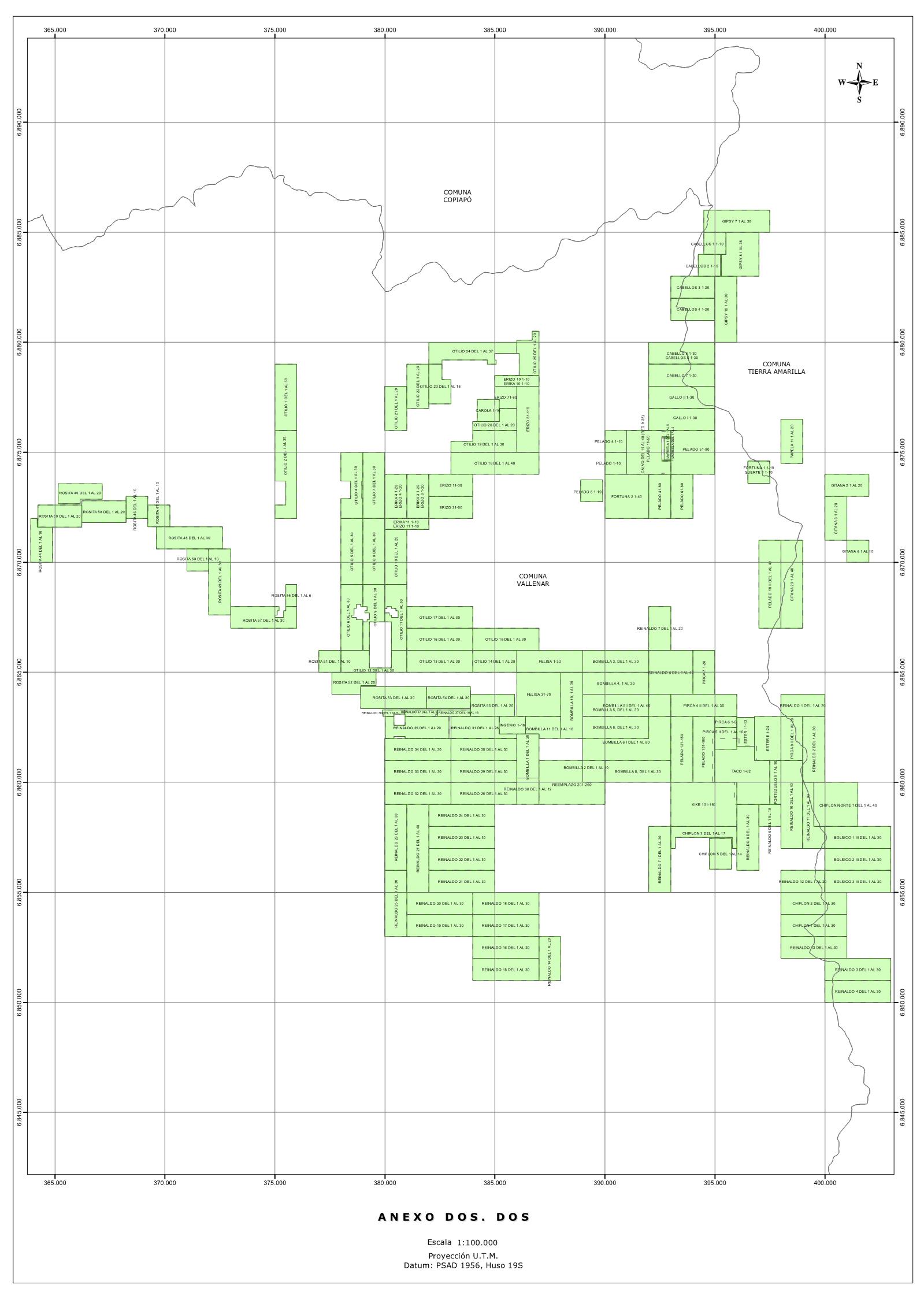
Figure 3-2 Layout and Location of the Concessions
| Key Mining Corp. | |
| S-K 1300 - Technical Report Summary – Fiel Rosita | Page 34 |
| | |
Based on the current state of development of the Project, the existing legislation in Chile, and the legal assurances necessary and required to safeguard the areas impacted by the Project, a strategy has been developed for acquisition of surface lands sufficient to support the Project operation.
The surface lands in the Communities of Vallenar and Tierra Amarilla where the Project is located are part of a larger lot that is owned by the State, and is managed and represented by the Ministerio de Bienes Nacionales. The State is also the owner and the Ministerio de Bienes Nacionales also manages and represents the land in the districts of Huasco and Copiapó where the Project is located.
KM Chile has developed a legal strategy to obtain the necessary surface rights to cover mine, plant, camps, tailings storage facilities, pipelines, port, and transmission lines.
KM Chile will apply for definitive surface rights within the area of interest. These shall cover surface rights for facilities and infrastructure. All these surface rights will be contracts between KM Chile and the Chilean Treasury.
The Project will not require an application for water rights. The water for operations will consist solely of desalinated sea water. Water for construction will be obtained from Aguas Chañar S.A.or (CMP), an authorized third-party provider.
| Key Mining Corp. | |
| S-K 1300 - Technical Report Summary – Fiel Rosita | Page 35 |
| | |
| 4 | Accessibility, Climate, Local Resources, Infrastructure and Physiography |
| 4.1 | Access and Infrastructure |
The Fiel Rosita district is located Chile Region III, Atacama, northeast of Vallenar and southeast Copiapó, west of the Manflas River. and more specifically, from 28°21’ to 28°22’ south latitude, and from 70°02’ to 70°04’ west longitude. Access to the district is by Route 5 north of Vallenar, turning east on C-455. Route C-455 forks at C-461. Fiel Rosita is located at the terminus of C-461 near the El Donkey station and the El Bolsico mining area.
The Atacama Region has well established infrastructure (energy, water, transportation, and labor) to serve the mining industry. However, there is currently no infrastructure at the Project site.
Hills of gentle to moderate relief have been cut by deep gullies and are flanked by gravel-filled valleys and alluvial fans. Vegetation is sparse. In the valleys, plant life consists of small widely-spaced bushes a few centimetres high. Hillsides and peaks are generally devoid of vegetation. The coastline in the port area is aligned along a west–southwest–east–northeast direction.
The Property is of a gentle relief of hills and wide large valleys, some places incised by ancient drainages and/or fault scarps. The Property is at an elevation ranging from 3,000 to 4,800 meters. The area is characterized by arid high-altitude desert conditions in which exploration may be carried out all year around.
The large land package of Fiel Rosita in terms of surface area, could host dozens of potential mining operations, tailings storage areas, waste disposal areas, heap leach pads, and potential processing plants.
The Project is located in an area that is one of the driest places on Earth, with high solar radiation, high evaporation rates and high salt concentrations in the soil. Rainfall is occasional and irregular. There is only sporadic surface run-off during rain events.
Geomorphologically, there are two types of desert regions in this area:
| ● | Normal desert: This extends from the south of the Copiapó Valley to the southern boundary of the Region and is characterized by low annual rainfall, increasing towards the south. The average annual temperature is 15°C. The main feature in the valleys of the Region is frost-free conditions for 11 months (from August to June). Minimum temperatures occur in July and reach 5°C; maximum temperatures occur in January and reach 28°C. There is seasonal precipitation in the area concentrated in the period from May to August, during which more than 80% of the total annual precipitation falls. |
| | | |
| ● | Coastal desert: This is present in all the coastal sectors of the Region to the north. Topographic relief does not present barriers to marine influences. Cloud densities depend on the presence of the Pacific Anticyclone, a high-pressure system that generates dry air masses. This climate is characterized by abundant and dense cloud cover which appears during the night, dissipating through the morning; sometimes accompanied by heavy fog and drizzle. The ocean influence produces a moderate thermal regime with a small temperature range, both daily and annually. Precipitation is mostly associated with fronts and increases from north to south, occurring almost exclusively in winter. The Project receives an average of 12 mm per year. |
The morpho-structural units recognized in the Central Andes, in the Atacama Region, from west to east are: Cordillera de la Costa (Coastal Range), Intermediate Depression, Foothills, Pre-Andean Depression, Western Range, and Altiplano. Figure 4-1 shows distribution of these units in cross-section and overhead view through the district. Fiel Rosita is located in the Foothills of the Andes.
| Key Mining Corp. | |
| S-K 1300 - Technical Report Summary – Fiel Rosita | Page 36 |
| | |

Figure 4-1 Overview and cross section showing the morpho-structural units and topography in the Atacama Region in relation to Fiel Rosita
The climate affecting the Atacama region shows great contrasts through its length. The coastal sector is affected by a desert climate with abundant cloudiness, high relative humidity, rainfall deficit, homogeneous thermal regimes and fog. Towards the interior, a transitional desert climate dominates with scarce and variable winter precipitation. Towards the Andes Mountain range, the altitude generates a cold desert climate, controlled by the foothills which form a geographical boundary that prevents access of eastern climatic influences to the west (Figure 4-2).
| Key Mining Corp. | |
| S-K 1300 - Technical Report Summary – Fiel Rosita | Page 37 |
| | |

Figure 4-2 Climate zones of the Atacama region with Koppen Climate Classification scheme.
The Project climate falls under the so-called normal desert with precipitation preferably occurring between June and September, controlled by small periods of intense rains (30-40 mm/month), with an event frequency of 5-7 years. A record of the rainfall between January 2013 and September 2022 is presented in Figure 4-3.
| Key Mining Corp. | |
| S-K 1300 - Technical Report Summary – Fiel Rosita | Page 38 |
| | |

Figure 4-3 Monthly precipitation in the Tierra Amarilla Sector Years 2013-2022
| Key Mining Corp. | |
| S-K 1300 - Technical Report Summary – Fiel Rosita | Page 39 |
| | |
SQM Minerals acquired mining concessions for the Project in 1990 and 1991. Through 1997 surface mapping and soil sampling programs were carried out.
In 2007 SQM initiated further geological investigations, completing magnetometry and drilling twelve exploration holes.
During the period 2010 to 2013, SQM drilled 175 additional holes totaling over 52,000 meters of drilling. An in-house mineral resource estimate was completed on the project as well as an internal scoping study to evaluate the economic viability of the Project.
In 2014 SQM completed IP geophysical testing and some further district scale exploration.
HudBay Minerals completed 8 additional drill holes under an exploration option during 2015 through 2018.
There are no historical estimates on the Property. There has been small scale mining from an area known as Papela. Production records from Papela are not known.
| Key Mining Corp. | |
| S-K 1300 - Technical Report Summary – Fiel Rosita | Page 40 |
| | |
| 6 | Geological Setting, Mineralization and Deposit |
The Fiel Rosita district is located between the Lower Cretaceous to Paleocene metallogenic belt to the west and that of the Eocene- Miocene to the east. The primary geologic feature recognized in the area is formed by the contact between the Manflas pluton, on the east, and the stratified sequences of the Lautaro Formation. (Lower-Middle Jurassic) and the Picudo Formation (Upper Jurassic) on the west. This contact runs in a north-south direction.
The area is made of grayish limestones and whitish calcareous sandstones, attributed to the middle member of the Lautaro Formation. The sequence has skarn alteration and mineralization in the Fiel Rosita area, with high contents of metamorphic minerals, such as coarse-grained wollastonite and garnet. The calcareous layers have a 70° W dip near the contact with the Manflas pluton, though quickly diminishing westward, and dips are recognizable to the east, showing the existence of a small syncline that does not continue further north. To the west, 45° W dips can be observed, consistent with the monocline folds seen throughout the sedimentary belt.
This formation is conformable over the Lautaro Formation, although the upper member of the Lautaro Formation has not been recognized, which could indicate an unconformity between the formations. The base of the Picudo Formation is made of volcanic-sedimentary conglomerates, gradually interlaced by tuffs and andesitic lavas. The lavas form one-meter-thick strata with grading upwards to more porphyritic textures. The strata dips change orientation to each side of the ravine located in the center of the Fiel Rosita district, with a 45° W dip on the north side and a 30° W dip on the south side. Further west, dips increase up to 80° W in the uppermost parts of the sequence, becoming the same on both sides of the ravine.
The Manflas Pluton has a granodiorite composition to the north and tonalitic to the south. The contact with the Lautaro Formation rocks, and northward (outside the district), with the Ternera Formation lavas is regular and has a north-south orientation. The pluton shows local composition variations and is intruded by andesitic, dacitic and granitic porphyries.
| Key Mining Corp. | |
| S-K 1300 - Technical Report Summary – Fiel Rosita | Page 41 |
| | |
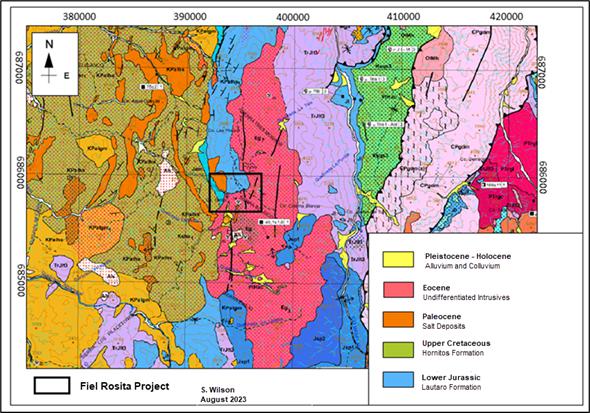
Figure 6-1 Geologic Map showing the regional geology of the Fiel Rosita Project
| 6.1.2 | Local/Property Geology |
The district includes the Fiel Rosita skarn and porphyry deposits and the La Viejita and El Chiflón deposits.
The Feil Rosita skarn and porphyry deposits are located in the contact of a volcanic-sedimentary series with the Manflas pluton. In the middle part of the pluton, there is a metamorphic unit called hornfels, home to the majority of a series of sub-vertical porphyry bodies, interpreted as the channels where mineralization took place, and having clasts that form a group of breccia.
In La Viejita and El Chiflón, the deposits are sub-vertical porphyries located in the Manflas pluton and forming some breccia bodies. A thin overburden partly covers the various deposits.
The following summary describes each of these units:
| ● | Skarn: Belonging to the Lautaro Formation (Mortimer, 1973), this is a calc-silicate marine sequence with presence of granites pyroxenoids calcite and silica, and interlaced volcanic and siltstones, that is strongly affected by the regional metamorphism and folding. |
| ● | Hornfels: A fine-grained rock with presence of quartz, recrystallized albite and low-temperature biotite, showing contact metamorphism, and possibly containing a Triassic metamorphosed unit. |
| ● | Manflas: This is the Manflas pluton, with a composition varying from the edges to the center, from granodiorite to tonalitic respectively. |
| ● | Mineral Porphyry: It comprises andesite and granodiorite porphyries, both with a porphyry texture and plenty of plagioclase and biotite phenocrysts, their number indicating which is which, and with color changes according to their composition and number of xenocrysts. |
| ● | Dacitic Porphyry: This is a porphyry-texturized rock, with plagioclase phenocrysts and a few quartz eyes immersed in a mass of quartz-feldspar aggregate. |
| Key Mining Corp. | |
| S-K 1300 - Technical Report Summary – Fiel Rosita | Page 42 |
| | |
| ● | Hydrothermal Breccia: Made of monomythic and polymythic breccia, the first within a matrix of quartz-sericite-chlorite, in areas with tourmaline and dacitic porphyry clasts, and the quartz-sericite-chlorite matrix of the polymyths found in areas with tourmaline and clasts of primarily andesite, skarn, dacitic porphyry and hornfels. |
| ● | Tourmaline Breccia: This is an aggregate of sub-angular, millimetric-to-centimetric, dacitic and andesitic porphyry clasts with a strong quartz-sericite alteration. The matrix is made of rock powder cemented by calcite-quartz-chlorite and sulphides, such as pyrite, chalcopyrite, blende and galena, forming areas with high grades. |
| ● | Overburden: Slightly consolidated deposits formed by rain and gravitation. |
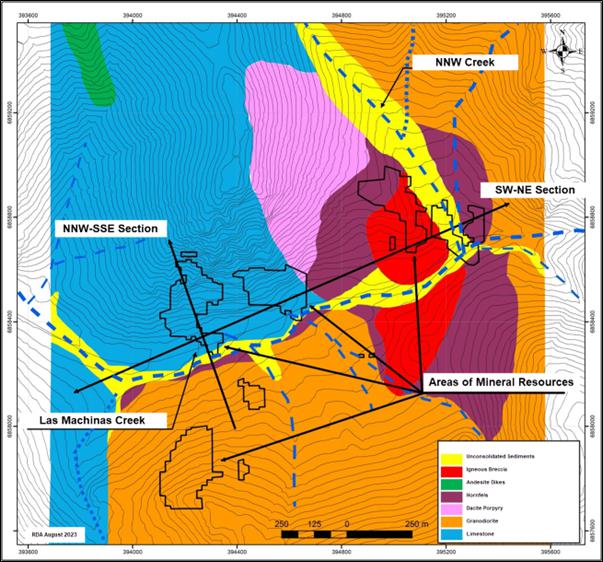
Figure 6-2 Lithologic map of the Fiel Rosita Project
| Key Mining Corp. | |
| S-K 1300 - Technical Report Summary – Fiel Rosita | Page 43 |
| | |
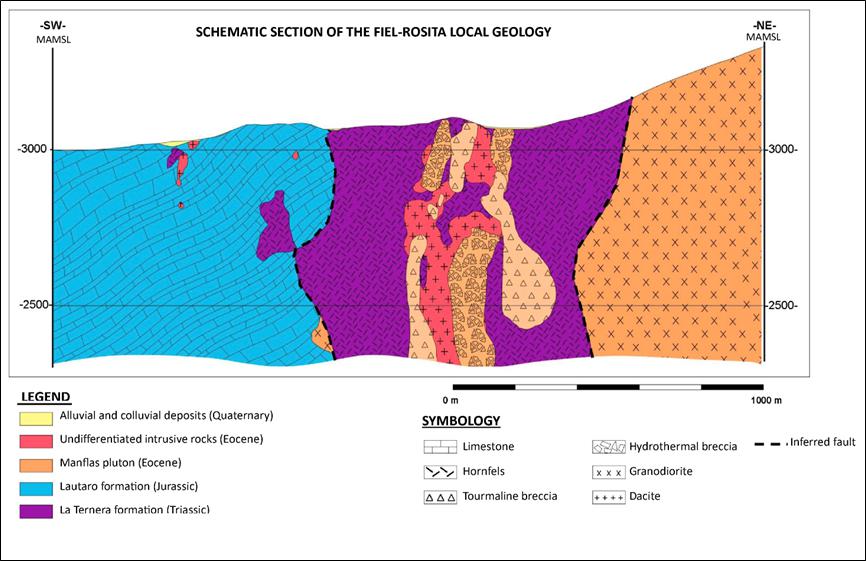
Figure 6-3 Fiel-Rosita Cross Section
| Key Mining Corp. | |
| S-K 1300 - Technical Report Summary – Fiel Rosita | Page 44 |
| | |
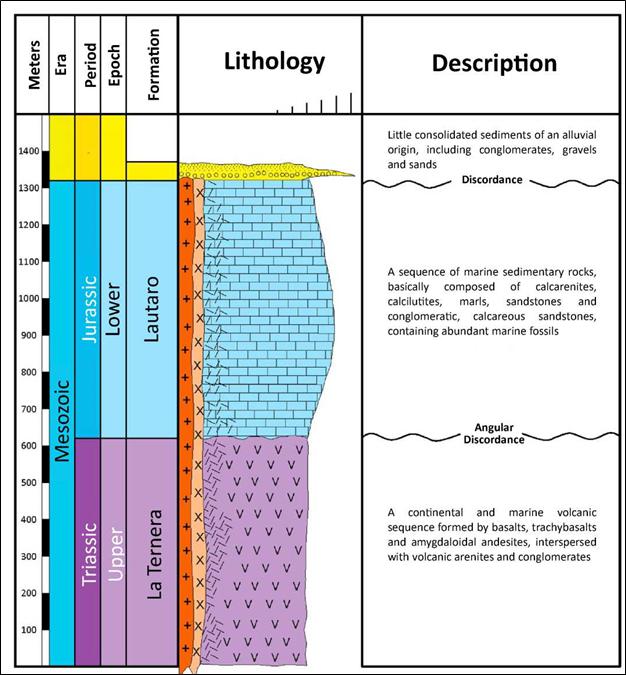
Figure 6-4 Stratigraphic Section for Fiel Rosita
The structures present in the sector are divided into faults, intermediate joints, and minor Joints. Major discontinuities are faults that have an important continuity on a district scale. Intermediate discontinuities are faults and/or dykes that can be associated with a fault pattern or system with a preferential orientation. Minor discontinuities are joints or fracturing of the rock mass with preferential orientations.
The major faults are two main guidelines interpreted from the geophysical, geological, topographic information, and the drainage network. These are structures with an N60-70°E dipping N30°W orientation, and subvertical bedding (80-90°) (see Figure 6-5), which contain up to 5m of fault breccias with fracture halos between 15-20 m (estimated from boreholes)
| Key Mining Corp. | |
| S-K 1300 - Technical Report Summary – Fiel Rosita | Page 45 |
| | |
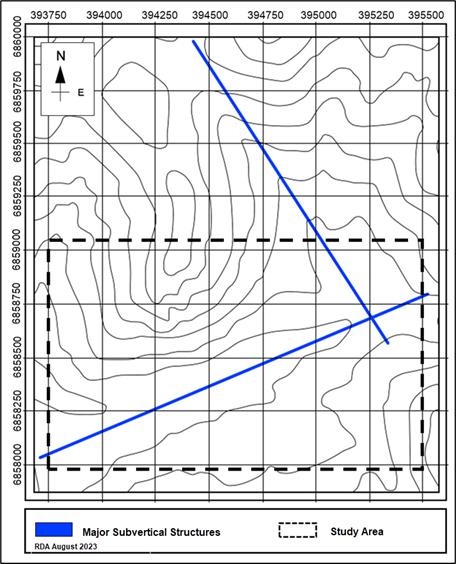
Figure 6-5 Major fault structures of the deposit
| 6.1.2.2.1 | Structural Domains |
Structural domains are defined as rock mass sectors where there is a recognizable structural fabric that can be differentiated from the surrounding sectors. This fabric is expressed through the preferred orientations of the minor and intermediate joints defining discontinuity patterns through geological, geophysical, and topographic interpretation.
The interpreted guidelines were grouped and classified according to the Riedel shear model (1929). In general, the guidelines are adjusted to the elements formed in brittle deformation, where each color represents a different structural system (See Figure 6-5). The main structural patterns recognized in the area are NE (Az: 60-70°), NW (Az: 120-140°), NS (Az: 350-10°), EW (Az: 80-110°), and NNE (Az: 5-10°) orientations.
| Key Mining Corp. | |
| S-K 1300 - Technical Report Summary – Fiel Rosita | Page 46 |
| | |
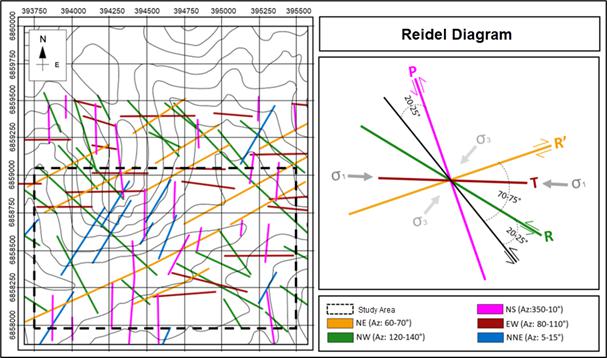
Figure 6-6 Left: Aerial interpretation of structural domains. Right: Interpretations of the structures using the Riedel model.
Six systems have been identified using the mapping of joints in the Reemplazo Hill (Cerro Reemplazo) sector, obtained from the “Geology, alteration, and mineralization of the Cerro Reemplazo Prospect” project, and the minor joints recognized onsite during the visit of EMT’s professionals.
Figure 6-7 shows a stereographic projection of the six minor joints systems, and Table 6-1 shows the orientation of each system.
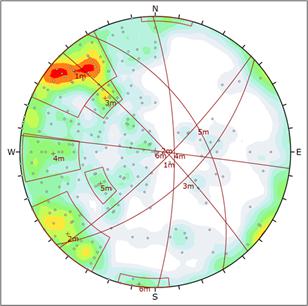
Figure 6-7 Minor joint systems
| Key Mining Corp. | |
| S-K 1300 - Technical Report Summary – Fiel Rosita | Page 47 |
| | |
Table 6-1 Minor joint system orientations
| Set | Dip | Dip direction |
| Mean (*) | Dev. (°) | Min. (°) | Max. (°) | Mean (*) | Dev. (°) | Min. (°) | Max. (°) |
| JS1 | 80 | 7 | 66 | 90 | 135 | 11 | 115 | 150 |
| JS2 | 83 | 6 | 72 | 90 | 47 | 11 | 30 | 65 |
| JS3 | 57 | 4 | 51 | 62 | 137 | 7 | 125 | 145 |
| JS4 | 74 | 8 | 62 | 85 | 89 | 6 | 80 | 95 |
| JS5 | 50 | 3 | 46 | 54 | 60 | 8 | 50 | 70 |
| JS6 | 90 | 1 | 87 | 90 | 37 | 70 | 0 | 180 |
At the Project six predominant types of alteration have been recognized. Each alteration type affects quality of the rock masses in different ways. The following alteration types are identified for the Project:
| ● | Potassic Alteration: This is an alteration associated with the emplacement of the porphyry. It is found predominantly in the Hornfels and a presence of potassium feldspar disseminated in the limestones is observed. |
| ● | Propylitic Alteration: This develops outside the hydrothermal influence of porphyry and is characterized by the presence of disseminated chlorite and epidote, and occasionally albite and calcite. |
| ● | Phyllic Alteration: This is characterized by the presence of quartz and sericite. Sericitization affects the Dacitic Porphyry units intensely and, to a lesser extent, the Breccias Unit. While the Hornfels, Granodioritic Porphyry, and Breccia units are highly silicified. |
| ● | Skarn Alteration: Associated contact zone between carbonate rocks and igneous intrusion, where the replacement of chalcosilicate minerals occurs. This alteration is characterized by the presence of minerals such as epidote, garnet, pyroxene, wollastonite, actinolite, and magnetite. The skarn zone has significant silicification that manifests itself in quartz veins and veinlets; it also presents disseminated arsenopyrite and a limited presence of pyrite and chalcopyrite. |
| ● | Argillic Alteration: This is characterized by the presence of kaolinite, illite, alunite, and quartz, in addition to hematite and limonite scattered in veinlets. Present in all lithological units with a slight intensity. |
| ● | Advanced Argillic Alteration: mainly associated with the hydrothermal breccias, south of the propylitic alteration. |
Figure 6-6 shows a plan with the distribution of the types of alteration recognized in the study area.
| Key Mining Corp. | |
| S-K 1300 - Technical Report Summary – Fiel Rosita | Page 48 |
| | |

Figure 6-8 Fiel Rosita Prospect Alteration Map
| 6.1.2.4 | Hydrological and Hydrogeological Model |
Fiel Rosita is located in a large exoreic basin (Figure 6 9), where there is a main recharge through precipitation which mobilizes waters through ephemeral ravines and rivers. This information helps understand infiltration into the rock mass of the mineral deposit. The phreatic level (PL) or water table measurements record in boreholes indicates a depth of 18-20 m in the central part of the Project area. This hydrological and geological information allows the definition of three conceptual hydro-stratigraphic units:
| ● | Quaternary deposits: Little to moderately consolidated sediments (conglomerates, gravel, and sand) that fill hillsides with a slight slope and ravines. They are classified as permeable strata, with high porosity and permeability that allow rainwater infiltration. |
| ● | Sedimentary rocks: These are limestone, marl, calcarenite, and conglomerates present in the area. They are classified as rocks with porosity and variable permeability. Secondary structures such as fractures and faults allow water infiltration. |
| Key Mining Corp. | |
| S-K 1300 - Technical Report Summary – Fiel Rosita | Page 49 |
| | |
| ● | Intrusive Rocks: Rocks of dacitic and granitic composition, and breccias; with very low porosity and permeability. They are rocks with very low storage capacity, but their permeability can vary in areas of intense and highly altered fracturing. |
Figure 6-7 shows an aerial view of the hydrogeological basin, while Figure 6-10 presents the location of the (dendritic) drainage patterns within the project area.
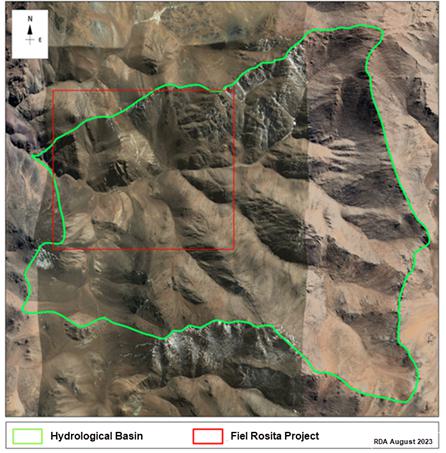
Figure 6-9 Fiel Rosita hydrogeological basin
| Key Mining Corp. | |
| S-K 1300 - Technical Report Summary – Fiel Rosita | Page 50 |
| | |
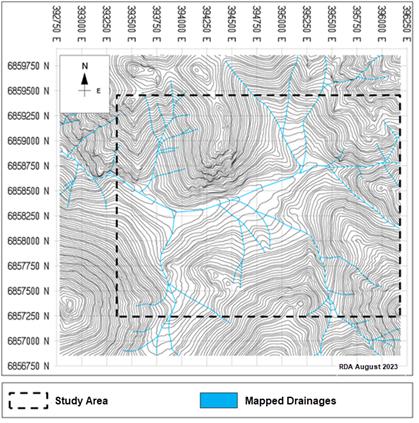
Figure 6-10 Drainage network of the Project area
The deposits are generally characterized by a nucleus of primary mineralization, which has been divided into a primary with measurable Cu grades, and another primary deposit that is rather sterile and contains mostly pyrite (Py). Oxidized and secondary-enrichment nuclei are scarce or non-existent.
| ● | Primary Pyrite (Py): This area is characterized by the presence of hypogenous sulphides, essentially Py, Aspy and Pirr with scarce Cpy, which makes it of little economic interest. |
| ● | Primary Chalcopyrite (Cpy): This is in an area of hypogenous sulphides more plentiful in Cpy, accompanied by Py, which has the most economic interest. |
| ● | Primary Molybdenite-Chalcopyrite (Mo-Cpy): As the primary Cpy, this unit is made of primary copper and molybdenum sulphides. It is localized in the most central and deep areas, with limited continuity. |
| ● | Primary Blende – Galena (Bl- Ga): These are smalls nuclei, generally located in the high parts of the system, with little continuity and more dominant presence of zinc and lead sulphides than copper sulphides. As the primary Mo-Cpy, it does not continue throughout the district, thus restricting the areas of interest to only two. |
| ● | Oxides: These are a series of green and black oxides, accompanied by iron oxides, such as limonite and jarosite. Chrysocolla, atacamite and black oxides, such as tenorite and manganese are among the copper oxides of greater interest. Their presence represents just a small volume, and their control is apparently structural. |
| ● | Leached: Located under the overburden, this unit presents a moderate cover, since it primarily contains iron oxides, such as hematite, jarosite and remnant sulphides from leaching. |
| Key Mining Corp. | |
| S-K 1300 - Technical Report Summary – Fiel Rosita | Page 51 |
| | |
Fiel Rosita mineralization is hosted in two distinct and widely recognized deposit types; porphyry and skarn deposits. Porphyry copper deposits are large-tonnage, low-grade, hydrothermal copper sulfide occurrences distinguished by very large volumes of altered rock and temporally and spatially associated porphyritic intrusions and breccia formation. Copper in porphyry copper systems may occur in stockworks, disseminated, or as contact replacement bodies and may be found in wall rocks and/or in genetically related intrusions. Pyrite chalcopyrite-bornite often dominates the sulfide mineralogy. In deep zones or in calcareous rocks, pyrrhotite may be present instead of pyrite. Alteration types are typically zoned around a central core and, although they may vary depending on several factors, can include potassic (biotite and potassium feldspar), phyllic (sericite, quartz, pyrite), propylitic (chlorite, epidote, albite, calcite, sericite), and argillic (chlorite, montmorillonite) alteration.
The dimensions and geometries of porphyry copper deposits vary widely, due in part to post-mineralization intrusions, the varied types of host rocks that influence deposit morphology, the relative amounts of supergene and hypogene mineralization, each of which has different configurations, and especially erosion and post-mineralization deformation including faulting. Porphyry copper deposits commonly are centered around small cylindrical porphyry stocks or swarms of dikes that in some cases are demonstrably cupolas of larger underlying plutons or batholiths. Aerial extents of porphyry-related intrusions typically range from 0.2 to 0.5 km2. Undeformed deposits commonly have circular or elliptical shapes in plan-view, with diameters that typically range from 0.1 to 1.0 km and have vertical dimensions similar to and greater than their horizontal dimensions.
Skarns are coarse-grained metamorphic rocks composed of calcium-iron-magnesium-manganese-aluminum silicate minerals that form by replacement of carbonate-bearing rocks (in most cases) during contact or regional metamorphism and metasomatism. Skarn deposits are relatively high-temperature mineral deposits related to magmatic hydrothermal activity associated with granitoid plutons in orogenic tectonic settings; skarns generally form where a granitoid pluton has intruded sedimentary strata that include limestone or other carbonate-rich rocks. The processes that lead to formation of all types of skarn deposits include: (1) isochemical contact metamorphism during pluton emplacement, (2) prograde metasomatic skarn formation as the pluton cools and a metal bearing fluid develops, and (3) retrograde alteration of earlier-formed mineral assemblages. Deposition of metallic minerals accompanies stages 2 and 3.
Skarn deposits are typically zoned mineralogically with respect to pluton contacts, original lithology of host rocks, and (or) fluid pathways. Later petrogenetic stages may partly or completely obliterate earlier stages of skarn development. Skarn deposits commonly are also associated with many other types of magmatic-hydrothermal deposits in mineral districts. In fact, distinction between skarn and other deposit types is not always apparent, and in many districts, skarns form an intermediate “zone” between porphyry deposits in the center of mining districts and peripheral zones of polymetallic vein and replacement and distal disseminated deposits.
| Key Mining Corp. | |
| S-K 1300 - Technical Report Summary – Fiel Rosita | Page 52 |
| | |
Exploration at the Fiel Rosita Project is based on the two deposit-model types that have been identified within the Project area: porphyry and skarn.
To date, exploration has been essentially limited to the areas with identified surface mineralization, i.e., the Fiel Rosita Porphyry, Fiel Rosita Skarn, La Viejita and El Chiflón, including geological mapping, limited geochemical sampling campaigns in the district, a ground magnetometer survey over parts of the project area and an induced-potential geophysical study of a part of the mineralized skarn.
The borehole database “sqm_rda210816.dhd.isis” retrieved from KM Chile’s database contains 201 boreholes, with a total of 63,706.84 m drilled, 119 of which are within Fiel Rosita, 22 are within El Chiflon and 50 are within La Viejita. Ten drill holes are drilled elsewhere on the Property (Table 7-1). Most of this available information includes an analysis of % Total Cu, Mo ppm, Au ppm and % Zn. Tables 7-1 and 7-2 total assayed intervals and intervals with measurable mineralization respectively. Of the total drilling, there are 43,780 nominal 1m length assays defining 51,713.36m of drilled mineralization (Table 7-2). Drill hole locations are shown in Figure 7-1.
Table 7-1 Total Drill Hole Database
| Variable | 2013 Database |
| Number of Boreholes | Number of Intervals | Meters |
| TCu | 201 | 50,808 | 63,706.84 |
| Mo | 201 | 50,808 | 63,706.84 |
| Au | 201 | 50,808 | 63,706.84 |
| Ag | 201 | 50,808 | 63,706.84 |
| Zn | 201 | 50,808 | 63,706.84 |
Table 7-2 Drilling Assays with Mineralization Above Detection
| Variable | 2013 Database |
| Number of Boreholes | Analyzed Samples | Meters |
| TCu | 201 | 49,780 | 51,713.36 |
| Mo | 201 | 49,780 | 51,713.36 |
| Au | 201 | 49,780 | 51,713.36 |
| Ag | 201 | 49,780 | 51,713.36 |
| Zn | 201 | 49,780 | 51,713.36 |
| Key Mining Corp. | |
| S-K 1300 - Technical Report Summary – Fiel Rosita | Page 53 |
| | |
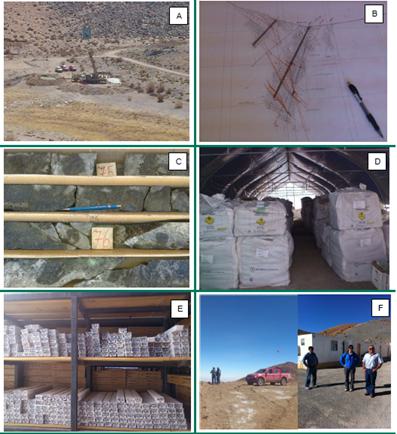
Figure 7-1 A) Drill Platform; B) Interpretation Section; C) Detail of a Mineralized Nucleus; D) Reject Storage; E) RC-DDH Core-Sample Storage, and F) El Chiflón and Camp. Storage facilities and Camp have been dismantled and no longer exist at the Project site.
| Key Mining Corp. | |
| S-K 1300 - Technical Report Summary – Fiel Rosita | Page 54 |
| | |
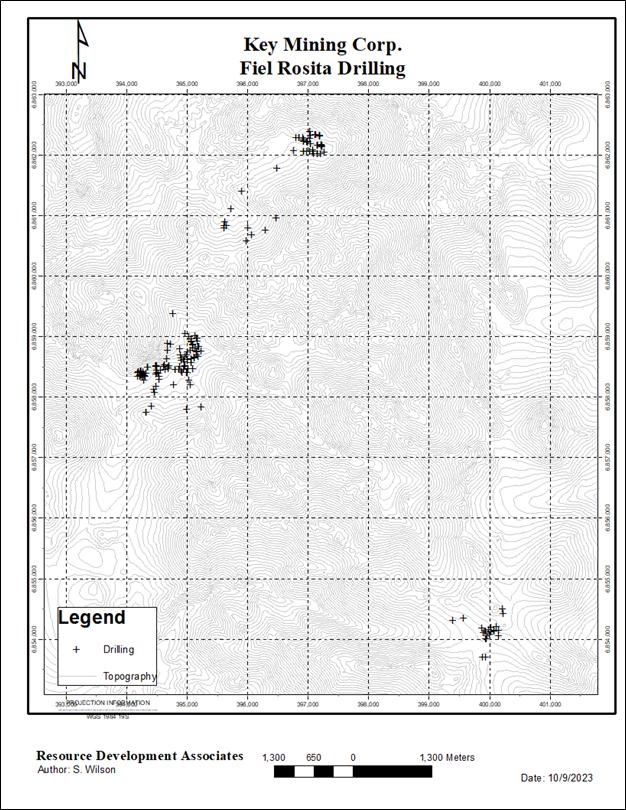
Figure 7-2 Fiel Rosita Drilling Plan Map
| Key Mining Corp. | |
| S-K 1300 - Technical Report Summary – Fiel Rosita | Page 55 |
| | |
| 8 | Sample Preparation, Analyses and Security |
A comparison between the SQM database, including up to the 2013 campaign, and the database of certified grades, yields the following results at the level of samples.
Table 8-1 Comparison of database entries versus assay certificates
| Item | % Cu | Au ppm | Ag ppm | % Zn | Mo ppm |
| Population | 39,484 | 38,984 | 39,479 | 26,917 | 26,784 |
| Dif. = 0 | 37,009 | 36,101 | 37,939 | 24,262 | 24,415 |
| Dif. < 0.01 | 39,008 | 37,602 | 37,939 | 26,478 | 24,415 |
| % Dif. > 0 | 6.27% | 7.40% | 3.90% | 9.86% | 8.84% |
| % Dif. >= 0.01 | 1.21% | 3.55% | 3.90% | 1.63% | 8.84% |
Less than 5% of the data population showed greater differences than to the third decimal. The following sections detail the results of a Golder review (2014) of the Quality Assurance Quality Control (QAQC) program implemented by SQM for the sampling and chemical analysis processes of its Fiel Rosita project.
Quality Assurance (QA) is the system and set of procedures used to ensure the quality of sampling and test results. Quality Control (QC) is the data used to verify that the sample-preparation and chemical-analysis processes yield proper results.
The QA program designed and implemented by SQM for the Fiel Rosita Project (FRP) includes the following controls:
| ● | Coarse Blanks (CB) - Sterile material placed in the mechanical preparation batches to determine if there was any contamination during the process; |
| ● | Standards (CRM) - Pulp envelopes with known grades of the elements to be controlled; and |
| o | Fine (FD) – A second measurement of the same pulp envelopes originally sent for analysis; |
| o | Coarse (CD) - A second sample taken immediately after size reduction and particle-size distribution; and |
| o | Laboratory (LD) - A set of pulp envelopes selected and forwarded for measurement by a second laboratory. |
Presently, the QAQC program is stored in a series of Excel® files for controlling implementation and supervision. Work has been done by dividing into five separate areas: El Chiflón (CHF), Fiel Rosita Porphyry (FRP), La-Viejita Porphyry (LVP), Skarn (SKN) and Portezuelo (PTZ).
The observed coverage percentages are generally close to the norm. A slight noted change in coverage percentages among the campaigns conducted before and after 2013, increasing during the 2014 campaign. Table 8-2.
Table 8-2 Number of coarse blanks submitted for QAQC
| | Au | Ag | As | Cu | Mo | Pb | Zn | Total Records | Percentage |
| El Chiflón | 91 | 119 | 119 | 119 | 108 | 118 | 119 | 2,518 | 5% |
| Fiel Rosita Porphyry | 632 | 632 | 632 | 632 | 621 | 573 | 630 | 18,144 | 3% |
| La Viejita Porphyry | 664 | 664 | 664 | 664 | 664 | 664 | 664 | 16,937 | 4% |
| Portezuelo | 33 | 22 | 20 | 22 | 22 | 20 | 20 | 456 | 5% |
| Skarn | 271 | 282 | 282 | 282 | 278 | 282 | 282 | 10,252 | 3% |
| Total | 1,691 | 1,719 | 1,717 | 1,719 | 1,693 | 1,657 | 1,715 | 48,307 | 4% |
Although the CB results exceeded the defined acceptable limits (2014 Golder QA&QC Report), they were still low. A few excessively anomalous values may be associated with potential contaminations or sample confusions and must be reviewed to determine their origin.
| Key Mining Corp. | |
| S-K 1300 - Technical Report Summary – Fiel Rosita | Page 56 |
| | |
Table 8-3 details the samples with CB results showing the greatest differences in respect of the acceptable limits. We recommend assessing these results, so as to determine if there were any potential label or sample confusion problems.
Generally, the FR-project CB results did not indicate any generalized process contamination. However, some isolated records were over the acceptable limits and must be reviewed to determine if there were any potential label or sample confusion problems.
Table 8-3 Samples beyond acceptable limits
| Area | Sample ID | Element |
| EL CHIFLÓN | FR-18360 | Mo |
| FIEL_ROSITA_NORTH_PORPHYRY | FR-14540 | Au_Mo_Pb_Zn |
| FIEL_ROSITA_NORTH_PORPHYRY | FR-11200 | Zn |
| FIEL_ROSITA_NORTH_PORPHYRY | FR-20600 | Zn |
| FIEL_ROSITA_NORTH_PORPHYRY | FR-11760 | Zn |
| FIEL_ROSITA_NORTH_PORPHYRY | 8235 | Zn |
| FIEL_ROSITA_NORTH_PORPHYRY | 4557 | Zn |
| FIEL_ROSITA_NORTH_PORPHYRY | FR-23000 | Cu_Au |
| FIEL_ROSITA_NORTH_PORPHYRY | FR-12880 | Cu_Au_Ag |
| FIEL_ROSITA_NORTH_PORPHYRY | FR-14500 | Au |
| FIEL_ROSITA_SOUTH_PORPHYRY | FR-19320 | Pb |
| FIEL_ROSITA_SKARN | FR-42780 | Pb |
| FIEL_ROSITA_SKARN | FR-50520 | Au |
| FIEL_ROSITA_SKARN | FR-50580 | Au |
| FIEL_ROSITA_SKARN | FR-50560 | Au |
Standards are reference materials prepared and certified by Ore Research & Exploration Pty Ltd., Geostats PTY LTD. and Verilab. As indicated, we did not use any project materials to prepare them, and they are external reference materials (2012-2013 period), bought abroad through Ribba Ingenieros. In general, the values match the important grades and variables present in the Fiel Rosita project. We used nine standards, which are summarized in Table 8-4.
| Key Mining Corp. | |
| S-K 1300 - Technical Report Summary – Fiel Rosita | Page 57 |
| | |
Table 8-4 TCu, Mo, Au & Zn Standards, from the Laboratories of Ore Research & Exploration (OREAS), Geostats Pty Ltd. and Verilab
| | Number of | | Expected | Standard | Lower Limit | Upper Limit |
| Standard | Records | Element | Mean | Deviation | -3 DS | +3 DS |
OREAS 15h | 114 | Au ppm | 1.019 | 0.025 | 0.944 | 1.094 |
OREAS 502 Ag | 651 | Au ppm | 0.491 | 0.020 | 0.431 | 0.551 |
| % TCu | 0.755 | 0.020 | 0.695 | 0.815 |
| ppm Mo | 274 | 12.5 | 236.5 | 311.5 |
OREAS 504 Ag | 294 | ppm Au | 1.48 | 0.04 | 1.360 | 1.600 |
| % TCu | 1.137 | 0.032 | 1.041 | 1.233 |
| ppm Mo | 643.0 | 37.1 | 531.7 | 754.3 |
OREAS 904 | 300 | ppm Au | 45 | 4.3 | 32.1 | 57.9 |
| % TCu | 0.612 | 0.021 | 0.549 | 0.675 |
| ppm Mo | 2.1 | 0.2 | 1.6 | 2.7 |
| ppm Zn | 26.3 | 3.5 | 15.8 | 36.8 |
GMO-07 Pb Ag | 9 | ppm Cu | 14 | 3 | 5 | 23 |
| ppm Mo | 44.7 | 1.7 | 39.8 | 49.7 |
| ppm Zn | 11 | 3.0 | 2.0 | 20.0 |
| CU184 | 159 | g/t Au | 0.19 | 0.0147 | 0.148 | 0.232 |
| g/t Ag | 13 | 0.7649 | 10.7053 | 15.2947 |
| % Cu | 0.192 | 0.0004 | 0.1908 | 0.1923 |
| % Mo | 0.04 | 0.002 | 0.034 | 0.046 |
| 214269 | 146 | % TCu | 0.129 | 0.001 | 0.125 | 0.133 |
| % Zn | 1.442 | 0.018 | 1.388 | 1.496 |
| 214270 | 376 | % TCu | 1.772 | 0.015 | 1.728 | 1.816 |
| % Zn | 0.367 | 0.007 | 0.346 | 0.388 |
| 214271 | 184 | % TCu | 1.869 | 0.034 | 1.767 | 1.971 |
| % Zn | 3.600 | 0.026 | 3.523 | 3.677 |
| Key Mining Corp. | |
| S-K 1300 - Technical Report Summary – Fiel Rosita | Page 58 |
| | |
Table 8-5 Summary of results from standards by element
| Standard | Au | Cu | Mo | Zn |
| | % Bias | % Error | % Bias | % Error | % Bias | % Error | % Bias | % Error |
| 15-H | -6.28 | 3.65 | | | | | | |
| 502 | -4.49 | 2.42 | -1.91 | 0.698 | -3.1 | 1.76 | | |
| 504 | -2.39 | 1.46 | -3.37 | 1.72 | -8.29 | 4.34 | | |
| 904 | 15.75 | 7.26 | 0.91 | 0.59 | | | | |
| CU184 | 2.34 | 1.47 | 1.52 | 0.89 | | | | |
| 214269 | | | 6.38 | 3.11 | | | 1.42 | 1.05 |
| 214270 | | | 2.27 | 1.16 | | | 9.48 | 4.52 |
| 214271 | | | 0.30 | 0.73 | | | -4.21 | 2.37 |
The QAQC program considers inserting three types of duplicates: Fine Duplicates (FD), Coarse Duplicates (CD) and Laboratory Duplicates (LD). The purpose of these samples is to have proper accuracy controls at the various sample preparation stages.
| 8.4.1 | Coarse Duplicates (CD) |
The QA program considers that the CDs be made using material smaller than a 10 mesh, recovered from the lab as reject samples from Reverse Air (RA) drilling, and smaller than a 24 mesh in the case of Diamond Drill Holes (DDH). The mesh-size difference is given by the volume of samples: 30 to 40 kg for RA and 3 to 5 kg for DDH.
Since 2013, the insertion frequency was every fifty samples (2%) for the FRP, LVP and PTZ areas, and every thirty samples (3%) for SKN and CHF.
All values below the detection limit have been ignored for this analysis. The following table summarizes the number of available analyses for the various project areas. For the purposes of this analysis, we have also discarded all results below the detection limits.
Table 8-6 Number of CD Analyses by Element and Area
| Area | Analysis | Au | Ag | Cu | Mo | Pb | Zn |
| CHF | Assessed | 21 | 89 | 79 | 51 | 89 | 21 |
| Conducted | 49 | 89 | 89 | 89 | 89 | 49 |
| FRP | Assessed | 890 | 946 | 763 | 752 | 949 | 890 |
| Conducted | 950 | 950 | 950 | 950 | 950 | 950 |
| LVP | Assessed | 842 | 859 | 641 | 561 | 859 | 842 |
| Conducted | 857 | 859 | 859 | 859 | 859 | 857 |
| SKN | Assessed | 26 | 28 | 12 | 19 | 24 | 26 |
| Conducted | 28 | 28 | 28 | 28 | 24 | 28 |
| PTZ | Assessed | 250 | 496 | 370 | 445 | 506 | 250 |
| Conducted | 497 | 506 | 506 | 506 | 506 | 497 |
| Total | Assessed | 2,029 | 2,418 | 1,865 | 1,828 | 2,427 | 2,029 |
| Conducted | 2,381 | 2,432 | 2,432 | 2,432 | 2,428 | 2,381 |
Generally, the results showed high relative errors, although those from the main element samples, TCu, were within the expected range. The largest errors observed were associated with Pb, Mo and Au, which would also be related to the low grades present in the selected duplicates.
| Key Mining Corp. | |
| S-K 1300 - Technical Report Summary – Fiel Rosita | Page 59 |
| | |
Table 8-7 Number of CD Analyses by Element and Area
| Element | % Bias | % Relative Error | | Element | % Bias | % Relative Error |
| ppm_Au | -2.91 | 15.62 | | ppm_Mo | -8.42 | 17.04 |
| ppm_Ag | -2.50 | 13.53 | | %_Pb | -7.60 | 20.08 |
| %_Cu | -2.10 | 7.73 | | % Zn | -8.09 | 12.65 |
The QA program considers that the FDs be prepared using fines smaller than a 150 mesh, recovered from the pulp envelopes B or C. For the purposes of this analysis, we have discarded all results below the detection limits, which notably reduces the number of available records, particularly in the case of Ag. The following table summarizes the number of available records for the various project areas.
Table 8-8 Number of FD Analyses Assessed and Conducted by Element and Area
| Area | Analysis | Au | Ag | Cu | Mo | Pb | Zn |
| CHF | Assessed | 11 | 16 | 60 | 53 | 35 | 60 |
| Conducted | 60 | 60 | 60 | 60 | 60 | 60 |
| FRP | Assessed | 379 | 149 | 393 | 307 | 350 | 393 |
| Conducted | 394 | 394 | 394 | 394 | 394 | 394 |
| LVP | Assessed | 362 | 57 | 364 | 293 | 264 | 364 |
| Conducted | 364 | 364 | 364 | 364 | 364 | 364 |
| SKN | Assessed | 13 | 4 | 13 | 8 | 11 | 12 |
| Conducted | 13 | 13 | 13 | 13 | 13 | 13 |
| PTZ | Assessed | 180 | 102 | 320 | 248 | 298 | 326 |
| Conducted | 327 | 327 | 327 | 327 | 327 | 327 |
| Total | Assessed | 945 | 328 | 1,150 | 909 | 958 | 1,155 |
| Conducted | 1,158 | 1,158 | 1,158 | 1,158 | 1,158 | 1,158 |
However, we can conclude that there were potential accuracy deviations in the case of other elements, such as Mo, Pb and Ag, which may be partly due to the low grades present in the selected duplicates.
Table 8-9 Summary of FD by Variable
| Element | % Bias | % Relative Error | | Element | % Bias | % Relative Error |
| Au | -0.03 | 9.70 | | Mo | -8.28 | 15.29 |
| Ag | -0.98 | 14.64 | | Pb | -4.13 | 16.99 |
| Cu | 0.11 | 3.89 | | Zn | -3.46 | 8.03 |
| 8.4.3 | Laboratory Duplicates |
The QA program considers that the LDs in envelopes A containing fine pulps with a particle size smaller than a 150 mesh be forwarded to a second laboratory for a complete chemical analysis, of one every twenty samples (5%), together with testing the particle size of pulps A. The following table summarizes the number of available analyses for the various project areas. For the purposes of this analysis, we have discarded all results below the detection limits.
| Key Mining Corp. | |
| S-K 1300 - Technical Report Summary – Fiel Rosita | Page 60 |
| | |
Table 8-10 Number of LD Analyses and Element by Area
| Area | Analysis | Au | Ag | Cu | Mo | Pb | Zn |
| CHF | Assessed | 21 | 24 | 89 | 79 | 51 | 89 |
| Conducted | 49 | 89 | 89 | 89 | 89 | 89 |
| FRP | Assessed | 890 | 349 | 946 | 763 | 752 | 949 |
| Conducted | 950 | 950 | 950 | 950 | 950 | 950 |
| LVP | Assessed | 842 | 120 | 859 | 641 | 561 | 859 |
| Conducted | 857 | 859 | 859 | 859 | 859 | 859 |
| SKN | Assessed | 26 | 7 | 28 | 12 | 19 | 24 |
| Conducted | 28 | 28 | 28 | 28 | 24 | 24 |
| PTZ | Assessed | 250 | 167 | 496 | 370 | 445 | 506 |
| Conducted | 497 | 506 | 506 | 506 | 506 | 506 |
| Total | Assessed | 2,029 | 667 | 2,418 | 1,865 | 1,828 | 2,427 |
| Conducted | 2,381 | 2,432 | 2,432 | 2,432 | 2,428 | 2,428 |
In summary, the results generally showed a negative bias and a relative error ranging from 4.1 to 17.2%, with a negative bias and low accuracy in the cases of Mo and Pb, as well as marginal levels of accuracy for Au and Ag, which is more evident in the case of Au, due to the very low values.
Table 8-11 Number of LD Analyses by Element and Area
| Element | % Bias | % Relative Error | | Element | % Bias | % Relative Error |
| Au | -11.61 | 19.02 | | Mo | 10.72 | 15.54 |
| Ag | 3.06 | 14.86 | | Pb | 13.28 | 20.84 |
| Cu | 0.67 | 6.46 | | Zn | 10.00 | 13.19 |
| 8.5 | Sufficiency of Procedures |
The attention to detail related to sample preparation analysis and security, by the various operators at Fiel Rosita, were done using best practices. Biases in the sampling are understood and are within acceptable levels of accuracy. In the opinion of the qualified person, the assay information is adequate for the intended use of mineral resource estimation at Fiel Rosita.
| Key Mining Corp. | |
| S-K 1300 - Technical Report Summary – Fiel Rosita | Page 61 |
| | |
This item covers the data verification completed by RDA. The data verification included a site visit and a review of the new drill hole geological descriptions. The steps taken by RDA to verify the data in the technical report, included the following:
| 9.2 | Data Verification Procedures |
A total of 1720 drill core samples from a 2016 – 2017 drilling campaign were selected from the Fiel Rosita project. The samples were obtained from 8 drill holes in two distinct geographic areas of the project. Four drill holes (FRSHBM 01 to 04) are from the Portezuelo (POR) block to the NE of the project. The objective of this campaign was to characterize down hole litho-geochemical units, alteration and metal distribution of the above-referenced drill cores, and to consolidate the results of a previous reconnaissance multi-element geochemical study based on surface grab samples.
All samples were analyzed following standard analytical protocols at Bureau Veritas Mineral Laboratories in Vancouver, BC.
The historical exploration data was obtained through documented procedures and involved verification and validation of exploration and production data, prior to consideration of geological modelling or mineral resource estimation.
The exploratory geochemical dataset comprises a suite of major elements, minor elements, trace elements, base and precious metals (including Cu, Mo, Ag), analyzed by a combination of Inductively Coupled Plasma Optical Emission Spectroscopy (ICP-OES) after 4 acid digestion (Method MA200). A selected number of samples (n=64) were analyzed for major oxides, minor and trace elements by Lithium Fusion ICP-MS (Method FA200) to achieve optimum digestion quality of refractory elements, in order to validate the results of the exploratory multi acid digestion dataset. Gold was analyzed in all samples by lead collection fire assay fusion, for total sample decomposition, and ICP-MS instrumental finish (Method FA130).
No limitations were placed on the QP to conduct data verification.
In the opinion of the QP the adequacy of the data is suitable for the estimation of Mineral Resources at Fiel Rosita.
| Key Mining Corp. | |
| S-K 1300 - Technical Report Summary – Fiel Rosita | Page 62 |
| | |
| 10 | Mineral Processing and Metallurgy |
Metallurgical tests were developed with the goal of designing mineral process plant. This was done in two phases that are described below and summarized in Figure 10-1.
Phase 1 of the conceptual study consisted of comminution and flotation metallurgical tests, respectively conducted by SGS Minerals Services (Santiago, Chile) and ALS Metallurgy (Kamloops, Canada), plus the design of a copper concentrator, a copper-molybdenum separator and Zinc concentrator plants, and finally, the delivery of the project operational and capital costs (Promet101, 2013). Phase 1 lasted from the second quarter of 2012 to the first quarter of 2013.
Phase 2 of the conceptual study lasted from the second quarter of 2013 and the first quarter of 2014. The work was a continuation of Phase 1, which had been mainly oriented to the specific area of the Fiel Rosita breccia, due to sample availability at the time. However, this phase placed an emphasis on a slightly more extensive metallurgical program compared to that of Phase 1.
Covering the entire Fiel Rosita district, because there was a larger number of samples available and more extensively distributed at that time, the Phase 2 metallurgical program consisted in a comminution-testing program that included twenty (20) variability composites and a flotation program of fifteen (15) variability composites. The flotation tests comprised both rougher and cleaner in an open circuit with fresh water from the Metropolitan Region of Chile, while the comminution tests included Ai (abrasion index), SVT (SAG Variability Test) and SAG Design (Promet101, 2014).
The geology of the project presents the following main lithologies hornfels, skarn, breccias (Polymictic, Monomictic and Tourmaline), dacitic porphyry, andesite, among others. The zones mineralized are defined as leachates, oxides, primary Py (pyrite), primary Cp (chalcopyrite), primary Mo-Cp (molybdenite-chalcopyrite), primary As (arsenopyrite), primary Pirr (pyrrhotite), blende and Galena. It should be noted that in the selection of samples only mineralized zones were considered that are associated with copper sulfides. The main alterations present in the project are biotite, potassium, calcsilicates, chloritic, tourmaline, quartz-sericitic, among others.
The material selected for the comminution tests presented a distribution by location of 45% belonging to the Fiel Rosita Porphyry, 10% to Fiel Rosita Skarn, 40% to the La Viejita and 5% to El Chiflón. For the mineralized zone 65% belongs to the primary As or Pirr, 30% to the primary Mo-Cp and 5% to the primary Py, for lithologies 15% is Skarn, 10% Hornfels, 30% Dacitic Porphyry, 40% is Breccia and 5% to the Tourmaline Gap.
The material selected for flotation tests presented average grades for copper of 0.59%, oxidized copper was 0.043%, molybdenum 0.020%, gold 0.22 ppm, silver 8.04 ppm, zinc 0.10%, lead 0.02%, iron 4.41%, sulfur 1.32%, carbon 0.71% and an average specific gravity of 2.76 (g/cm3).
The material selected for the comminution tests presented average grades for copper of 0.30%, for molybdenum an average of 88 ppm, gold with an average of 0.11 ppm, silver with an average of 6.61 ppm, zinc an average of 0.61% and lead an average of 0.11% and an average specific gravity of 2.71 (g/cm3).
The differences between the average grades of the variability materials intended for flotation and comminution tests were due to the scarcity of drilling intended for metallurgical testing. It should be noted that samples intended for flotation and comminution tests were obtained from drilling intended for resource estimation. It should also be kept in mind that these are average values, which present great fluctuation due to the small set of elements (15 for the case of flotation and 20 for the case of comminution).
Prior to the flotation tests, the respective grinding calibrations and the Bulk Mineral Analysis (BMA) were performed using QEMSCAN to determine the mineralogy and degree of release of the variability materials. The characterization of the compositions of variability for flotation, was carried out through a mineralogical analysis, which was developed for an average value of primary grinding of 152 um and that delivered the following average results for the main mineralogical species present, quartz 29.1%, feldspars 27.2%, micas 18.9%, garnet 6.6%, chlorite 5.5%, carbonates 3.9%, copper sulfides 1.8% and iron oxides 0.8%.
| Key Mining Corp. | |
| S-K 1300 - Technical Report Summary – Fiel Rosita | Page 63 |
| | |

Figure 10-1 Average mineralogy of variability compounds for flotation
For the average copper sulfides, these were found to be 97.9% as chalcopyrite (CuFeS2), 1.3% as the sum of covelin (CuS) and chalcosin (Cu2S), 0.7% tenantite (Cu3AsS3.5) and 0.1% bornite (Cu5FeS4).

Figure 10-2 Average distribution of copper sulfides of variability compounds for flotation.
The average release analysis for copper sulfides considering an average primary grinding size of 152 um, recorded that they were at 70.5% recovered. For copper sulfides in the samples of variability associated with Fiel Rosita Porphyry recovery was 67.9%, for the case of La Viejita 71.2%, for Fiel Rosita Skarn 69.4% and for El Chiflon 84.6%.
The average conditions of the rougher tests were, a primary grind of 15 minutes that resulted in a P80 of 153 um, a pH of 10, a conditioning time of 4.3 minutes and a float time of 9.1 minutes. The reagents used (average dosages) were a pH modifier such as lime with an average dose of 1.015 (g/t), an agent for molybdenum such as phosphoric acid with an average dose of 13.6 (g/t), a multi-metallic collector such as SIPX (Sodium Isopropyl Xanthate) with an average dose of 2.3 (g/t) and another collector such as MIBC (Methyl Isobutyl Carbinol) with an average dose of 20.8 (g/t).
| Key Mining Corp. | |
| S-K 1300 - Technical Report Summary – Fiel Rosita | Page 64 |
| | |
The most relevant results, for the rougher tests, were a mass recovery of 8.9%, with an average copper recovery of 85.9% associated with an average grade of the rougher concentrate of 4.6% copper. For the Fiel Rosita Porphyry sample, considering the rougher concentrate, the average mass recovery was 10.4% with average grades of 3.6% for copper, 8.9% for Iron and 6.7% for sulfur, associated with recoveries of 88.7%, 23.7% and 56.0% respectively. For the Fiel Rosita Skarn sample, considering the rougher concentrate, the average mass recovery was 10.8% with average grades of 16.9% for copper, 24.0% for Iron and 26.0% for Sulfur, associated with recoveries of 91.7%, 38.7% and 59.7% respectively. For the sample La Viejita, considering the rougher concentrate, the average mass recovery was 7.2% with average grades of 2.1% for copper, 6.8% for Iron and 4.6% for Sulfur, associated with recoveries of 82.3%, 15.8% and 73.8% respectively. For the El Chiflón sample, considering the rougher concentrate, the average mass recovery was 6.3% with average grades of 1.2% for copper, 5.0% for Iron and 2.4% for Sulfur, associated with recoveries of 79.8%, 11.1% and 97.6% respectively.
The average conditions of the rougher stages, of the cleaner tests were, a primary grind of 14.8 minutes, which is equivalent to a P80 of 152 um, a pH of 10.1, a conditioning time of 2 minutes and a float time of 8 minutes. With respect to the flotation reagents used (average dosages), a pH modifier such as lime at 1.079 (g/t), an agent for molybdenum such as Fuel Oil with an average dose of 13.5 (g/t), a multi-metallic collector such as SIPX (Sodium Isopropyl Xanthate) with an average dose of 1.4 (g/t) and another collector such as MIBC (Methyl Isobutyl Carbinol) with an average dose of 21.7 (g/t) were used. The average conditions of the cleaner stage, were, a swirl of 8.3 minutes equivalent to P80 of 28.8 um, a pH of 11, a conditioning time of 2.9 minutes and a float time of 12 minutes. With regard to the flotation reagents used (average dosages), a pH modifier such as lime at 787 (g/t), an agent for Molybdenum such as oil fuel with an average dose of 13.5 (g/t), a multi-metallic collector as in SIPX (Sodium Isopropyl Xanthate) with an average dose of 1 (g/t), was dealt with, a collector such as MIBC (Methyl Isobutyl Carbinol) with an average dose of 25.5 (g/t) and a foaming agent such as W55, with a dose of 10 (g/t). Below are the most relevant results for the cleaner tests:
Table 10-1 Recoveries and grades of the rougher concentrate by sample.

| ● | The average of the previous table considers fifteen (15) variability composites, 2 composites of Fiel Rosita Skarn, 6 composites of the Porphyry Fiel Rosita, 1 composite of the Chiflon and 6 composites of the La Viejita. |
Table 10-2 Recoveries and grades of the rougher concentrate by sample.

| ● | The average of the previous table considers fifteen (15) variability composites, 2 composites of Fiel Rosita Skarn, 6 composites of the Porphyry Fiel Rosita, 1 composite of the Chiflon and 6 composites of the La Viejita. |
| Key Mining Corp. | |
| S-K 1300 - Technical Report Summary – Fiel Rosita | Page 65 |
| | |
The most relevant results of the rougher stages of the cleaner tests were an average mass recovery of 8.9%, an average recovery for copper of 86.0%, with an average grade of 4.6%, In the case of iron the average recovery was 9.8%, with an average grade of 21.7% and for sulfur the average recovery was 66.3% associated with an average grade of 8.2%. The two rougher stages, both for the rougher and cleaner tests presented similar values for both recoveries and grades, under similar conditions of primary grinding and dosing of reagents.
The most important results of the cleaner stages were an average mass recovery of 1.7%, an average recovery for copper of 68%, with an average grade of 24.4%, In the case of iron the average recovery was 8.3%, with an average grade of 23.3% and for sulfur the average recovery was 36.8% associated with an average grade of 30.8%.
Recall the results obtained in the first stage of the conceptual study, for the rougher stage, a mass recovery that varied between 8-12% and metallurgical recoveries of copper that bordered on 90%. The mass recovery of the cleaner stage was 2.5%, with a copper recovery of 80% with grades of the copper concentrates obtained varied between 17-29%.
The values in both studies presented similarities, so that the copper grade in the cleaner concentrate, for the first study is between 17-29%, for the second study edge 24.5%, with recoveries that border 90% and 68% respectively. This last recovery value (68%) allows to ensure that there is a wide range to improve this recovery.
For the minor elements (As, Au, Ag, Mo, Pb and Zn) were obtained, for the cleaner concentrate, a silver recovery of 37%, for gold of 56%, for molybdenum of 22%, for As of 25%, for lead of 19% and for zinc was 16%, with associated grades for silver of 229 ppm, for gold 9 ppm, for molybdenum 0.7%, for arsenic 1.158 ppm, for lead 0.5% and for zinc 1.6%.
When considering the plant with a copper concentrator the As, Pb and Zn should be considered as contaminants, while Au, Ag and Mo should be considered as commodities. Average arsenic grades are under the maximum allowable value, lead and zinc grades are above allowable levels. The grades of molybdenum, silver and gold are within the typical range of a copper concentrator plant, for a concentrate cleaner.
Table 10-3 Feed grade, by sample and average.

Table 10-4 Grade of the final concentrate, by sample and average

| Key Mining Corp. | |
| S-K 1300 - Technical Report Summary – Fiel Rosita | Page 66 |
| | |
Table 10-5 Recoveries in the final concentrate, by sample and average

When considering the weighting of samples according to SQM’s 2013 resource model, the weighted average recoveries and grades are:
Table 10-6 Grade of the weighted final concentrate, by sample and average

Table 10-7 Weighted recoveries in the final concentrate, by sample and average

The most relevant results of the abrasion tests carried out were an average value for the project of 0.1619, for the abrasion index (Ai) and for the four samples obtained the following average values the Porphyry Fiel Rosita was 0.1414, for the La Viejita a 0.1392, the Chiflón with a 0.3608 and 0.1341 for the Fiel Rosita Skarn.
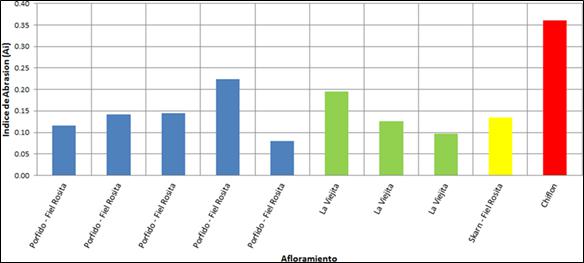
Figure 10-3 Abrasion Index, Ai, by sample.
An average abrasion index of 0.1619 for the mineralization of the Fiel Rosita project is considered as slightly abrasive, this classification of the Ai comprises the interval between (0.1, 0.4) therefore the four samples should be considered as slightly abrasive.
| Key Mining Corp. | |
| S-K 1300 - Technical Report Summary – Fiel Rosita | Page 67 |
| | |
The most relevant average results of the SAG Design, SAG Variability Test (SVT) and Bond Variability Test (BVT) tests for the variability compounds were an average Wsvt value of 12.1 (KWh/t) and Sv-BVT of 14.4 (KWh/t) and a specific gravity of 2.7 (gr/cc) values similar to those obtained in the first phase of the conceptual stage. Considering the information provided by Starkey & Associates (S&A) the average value of Wsvt, for the Fiel Rosita project, 12.1 (KWh / t) is within the trend of the S & A database and does not present deviation, finding the value under 80% (hardness) of the projects analyzed.
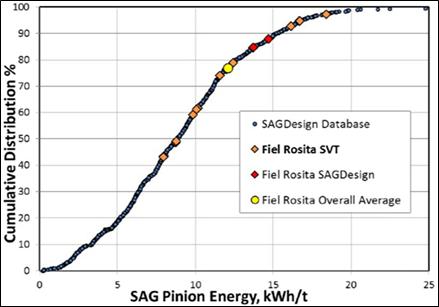
Figure 10-4 SAG Design results, for Fiel Rosita, compared to the S&A database
Regarding the average value of the SVT (14.40 (KWh/t)), it is under the 50th percentile (hardness) of the projects analyzed.
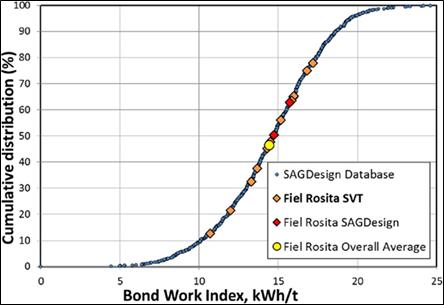
Figure 10-5 SVT results, for Fiel Rosita, compared to the S&A database
| Key Mining Corp. | |
| S-K 1300 - Technical Report Summary – Fiel Rosita | Page 68 |
| | |
This analysis agrees with what was reported by S&A, in the first phase of the conceptual study of the project, for the comminution circuit and considering the design for 80% hardness of the minerals analyzed, which was constituted by 1 SAG mill of diameter 36 ft and with an EGL distance of 16.64 ft with a power of 11,167 KW, which involved an installed power of 12,300 KW, in addition to a ball mill of 25 ft in diameter and an EGL distance of 37.51 ft, with a power of 12,929 KW, which became an installed power of 13,600 KW. Both synchronous motors, in the case of the SAG variable speed mill and with a utilization of 81.5%, in the case of the ball mill a variable speed and a utilization of 95.1%.
In addition, a cone crusher for pebbles, model MP800, with an installed power of 600 KW was included. This comminution system allows a feed of 1,489 (t/h) or 32,877 (t/d) for a 150 mm F80, a 3,350 um T80 and 150 um P80.
This comparison allowed us to affirm that for the conceptual stage of the Fiel Rosita project, the comminution circuit described above, can be used in the design phase of this conceptual study.
Now with respect to the flotation circuit this was defined, for this conceptual stage by a first rougher stage, comprised of a line of 5 cells of 300 m3, a first stage cleaner composed of a line of 6 cells of 70 m3, followed by a Scavenger stage (one line) of 6 cells of 70 m3, a second stage cleaner, consisting of a line of 6 cells of 50 m3 and a last stage cleaner (one line) of 6 cells of 30 m3.
The Phase 1 and Phase 2 tests covered the entire range of mineralization for the Fiel Rosita deposit. The results derived are descriptive of the mineral deposit as a whole. In the opinion of the qualified person, the results are adequate for the purposes of the technical report summary.
| Key Mining Corp. | |
| S-K 1300 - Technical Report Summary – Fiel Rosita | Page 69 |
| | |
| 11 | Mineral Resource Estimation |
Estimating the resources involved an interpolation of total copper (TCu), molybdenum (Mo), gold (Au), silver (Ag) and zinc (Zn) grades, as well as density (Dens), apart from calculating the copper equivalent with an equation and parameters provided by SQM for the Project.
| 11.1 | Copper Equivalent Formula |

The prices used to determine the copper equivalent were as follows:
| ● | PriceCu = 3.50 [USD/pound] |
| ● | PriceMo = 14 [USD/pound] |
| ● | PriceAu = 1,750 [USD/ounce] |
| ● | PriceAg = 23 [USD/ounce] |
| ● | PriceZn = 1.10 [USD/pound] |
| 11.2.1 | Exploratory Data Analysis |
Table 11-1 lists the geological domains statistics used for total copper in Fiel Rosita. Additionally, Figures 11-1 through 11-6 summarize the lognormal distribution of the Cu within lithology domains. Grades are capped at 99.9 percentile prior to compositing.
| Key Mining Corp. | |
| S-K 1300 - Technical Report Summary – Fiel Rosita | Page 70 |
| | |
Table 11-1 Cu General Statistics
| Domain | Assays | Minimum (%) | Maximum (%) | Mean (%) | Variance | Std. Dev. | C.V. |
| Breccia | 12,392 | 0.001 | 23.29 | 0.143 | 0.161 | 0.40 | 2.81 |
| Skarn | 7,096 | 0.001 | 14.39 | 0.196 | 0.586 | 0.76 | 3.90 |
| Hornfels | 7,177 | 0.001 | 17.57 | 0.097 | 0.143 | 0.37 | 3.91 |
| Dacite Porphyry | 11,810 | 0.001 | 10.51 | 0.087 | 0.021 | 0.14 | 1.65 |
| Mineral Porphyry | 6,704 | 0.001 | 1.28 | 0.089 | 0.005 | 0.07 | 0.78 |
| Intrusive | 1,603 | 0.001 | 1.00 | 0.047 | 0.006 | 0.08 | 1.68 |
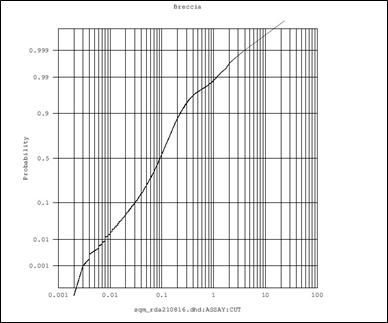
Figure 11-1 Breccia Log Prob Plot
| Key Mining Corp. | |
| S-K 1300 - Technical Report Summary – Fiel Rosita | Page 71 |
| | |
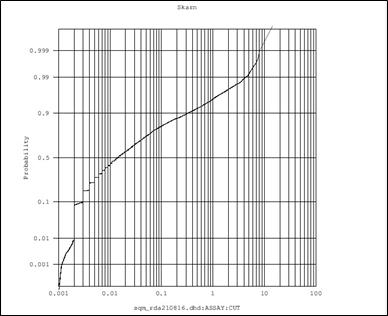
Figure 11-2 Skarn Log Prob Plot

Figure 11-3 Hornfels Log Prob Plot
| Key Mining Corp. | |
| S-K 1300 - Technical Report Summary – Fiel Rosita | Page 72 |
| | |
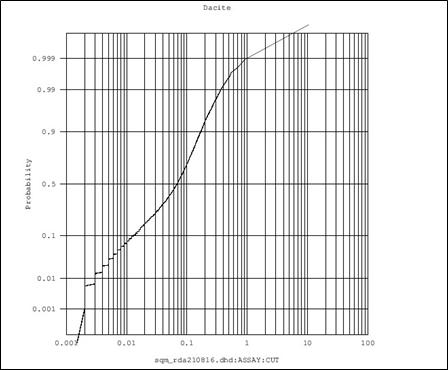
Figure 11-4 Dacite Log Prob Plot
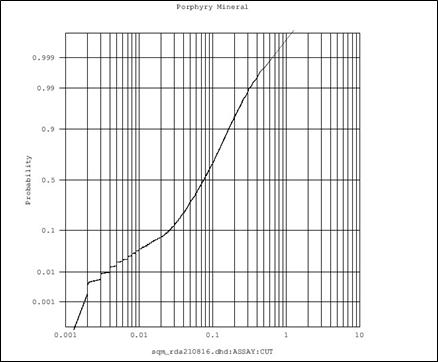
Figure 11-5 Porphyry Log Plot
| Key Mining Corp. | |
| S-K 1300 - Technical Report Summary – Fiel Rosita | Page 73 |
| | |
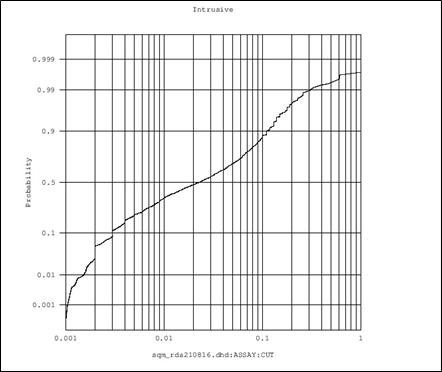
Figure 11-6 Intrusive Log Plot
Defining and controlling anomalous samples in the various populations is an industry-accepted practice, and is both necessary and useful to prevent potential grade or volume overestimations.
In general, copper outliers were defined at the top 99% percentile of the cumulative distribution of each estimation unit. Table11-2 lists the thresholds found for each estimation domain.
The defined outliers were controlled during the estimation process using two methodologies, i.e., restricted scope and capping.
Table 11-2 Cu Outliers
| Cu_Env | % Cu Threshold |
| Breccia | 4.0 |
| Skarn | 8.0 |
| Hornfels | 2.0 |
| Dacite | 1.0 |
| Porphyry | 0.8 |
| Intrusive | Not Capped |
Figure 11-7 shows the mean and standard deviation of each of the estimation domains, each domain demonstrates a differentiated behavior, both in terms of mean and variability, and the number of samples used for grade interpolation.
| Key Mining Corp. | |
| S-K 1300 - Technical Report Summary – Fiel Rosita | Page 74 |
| | |

Figure 11-7 Distribution of Cu Estimation Domains
The estimate used inverse distance estimation techniques for each of the elements Cu, Mo, Au, Ag and Zn. The search radiuses were defined based on the modelled variogram of each lithologic domain units. Ellipsoid dimensions were based on sill ranges from the variogram models maintaining the anisotropy for estimated mineralization characteristics.
Table 11-3 shows the search radiuses used for copper estimates in Vulcan format.
Table 11-3 Search Radii for Mineralization
| Cu_Env | Orientation | Fiel Rosita Ranges | La Viejita Ranges | El Chiflon Ranges |
| Ɵ1/Ɵ2/Ɵ31 | Major | Semi | Minor | Major | Semi | Minor | Major | Semi | Minor |
| Breccia | 10/-75/0 | 200 | 200 | 100 | | | | | | |
| Skarn | 170/75/0 | 200 | 200 | 100 | | | | | | |
| Background | 120/45/0 | 200 | 200 | 100 | 230 | 150 | 150 | 150 | 60 | 70 |
| 11.3.1 | Mineral Classification |
The resource classification is based on the linear distance from drilling and number of drill holes used for the resource grade estimates. Mineral resources for all three deposits are classified as Indicated Mineral Resources and Inferred Mineral Resources. Indicated Mineral Resources are defined as being within 100 meters of a hole and the block grades have been estimated with composites from at least two drill holes. All other mineralization has been classified as Inferred Mineral Resources.
| 11.3.2 | Grade Estimates and Sensitivity to Cut Off Grade |
In order to verify the validity of the Fiel Rosita resource model, a validation of the block model was performed to assess the kriging-method performance and input-data consistency. The validation included only actually estimated bocks used in the estimation. Validations included:
| ● | Comparing composite and block statistics; |
| ● | Visually validating estimated versus composite grades, and |
| ● | Preparing derivative graphs comparing block and composite grades. |
| Key Mining Corp. | |
| S-K 1300 - Technical Report Summary – Fiel Rosita | Page 75 |
| | |
Mineral resources at Fiel Rosita are sensitive to the selection of the reporting cutoff grade. To illustrate this sensitivity, the block model quantities and grade estimates are presented in the following tables at linear increases in the cutoff grades for Indicated and Inferred Mineral Resources at each of the three deposits and as a whole. The same results are presented graphically in the charts that follow each table. These tonnes and grades should not be misconstrued with a mineral resource statement. The tables and figures are only presented to show the sensitivity of block model estimates to the selection of a cutoff grade. Mineral resources are not mineral reserves and do not meet the threshold for reserve modifying factors, such as economic viability, that would allow for conversion to mineral reserves. There is no certainty that any part of the Mineral Resources estimated will be converted to mineral reserves.
Table 11-4 Grade / Tonnage Relationship of Fiel Rosita Deposit
| CuEq Cog | K mt | Cu Eq | TCu | Mo | Au | Ag | Zn | K mt Fine Cu |
| 0.10 | 686,382 | 0.25 | 0.12 | 102.94 | 0.06 | 2.01 | 0.08 | 824 |
| 0.15 | 408,531 | 0.34 | 0.15 | 151.24 | 0.08 | 2.71 | 0.11 | 613 |
| 0.20 | 254,705 | 0.44 | 0.19 | 216.59 | 0.10 | 3.58 | 0.15 | 484 |
| 0.25 | 170,522 | 0.55 | 0.23 | 289.34 | 0.12 | 4.48 | 0.19 | 392 |
| 0.30 | 127,516 | 0.64 | 0.26 | 352.33 | 0.14 | 5.21 | 0.22 | 332 |
| 0.35 | 99,650 | 0.73 | 0.30 | 413.79 | 0.15 | 5.88 | 0.24 | 299 |
| 0.40 | 79,134 | 0.82 | 0.33 | 473.58 | 0.17 | 6.54 | 0.26 | 261 |
| 0.45 | 65,068 | 0.90 | 0.37 | 527.83 | 0.19 | 7.15 | 0.28 | 241 |
| 0.50 | 54,054 | 0.99 | 0.41 | 581.85 | 0.21 | 7.79 | 0.29 | 222 |
| 0.55 | 46,274 | 1.07 | 0.44 | 626.12 | 0.23 | 8.39 | 0.31 | 204 |
| 0.60 | 39,827 | 1.15 | 0.48 | 668.59 | 0.25 | 8.97 | 0.33 | 191 |
| 0.65 | 34,710 | 1.23 | 0.51 | 706.98 | 0.27 | 9.54 | 0.35 | 177 |
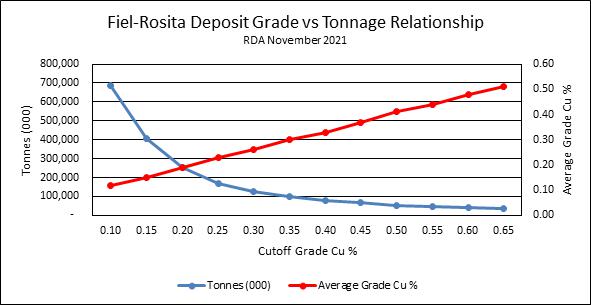
Figure 11-8 Fiel Rosita Grade Tonnage Relationship
| Key Mining Corp. | |
| S-K 1300 - Technical Report Summary – Fiel Rosita | Page 76 |
| | |
Table 11-5 Grade Tonnage Relationship of La Viejita Deposit
| Cu-Eq Cog | K mt | Cu Eq | TCu | Mo | Au | Ag | Zn | K mt Fine Cu |
| 0.10 | 184,533 | 0.23 | 0.10 | 26.76 | 0.15 | 0.93 | 0.02 | 185 |
| 0.15 | 146,339 | 0.26 | 0.11 | 28.27 | 0.17 | 1.00 | 0.02 | 161 |
| 0.20 | 101,399 | 0.30 | 0.12 | 29.89 | 0.19 | 1.10 | 0.02 | 122 |
| 0.25 | 61,962 | 0.34 | 0.14 | 31.09 | 0.23 | 1.21 | 0.02 | 87 |
| 0.30 | 34,406 | 0.40 | 0.15 | 31.87 | 0.28 | 1.33 | 0.02 | 52 |
| 0.35 | 19,117 | 0.46 | 0.17 | 31.80 | 0.34 | 1.42 | 0.02 | 32 |
| 0.40 | 10,422 | 0.53 | 0.19 | 30.42 | 0.42 | 1.59 | 0.03 | 20 |
| 0.45 | 6,070 | 0.61 | 0.20 | 29.94 | 0.50 | 1.71 | 0.03 | 12 |
| 0.50 | 3,777 | 0.69 | 0.21 | 29.26 | 0.60 | 1.86 | 0.03 | 8 |
| 0.55 | 2,595 | 0.77 | 0.22 | 29.20 | 0.69 | 1.93 | 0.04 | 6 |
| 0.60 | 1,778 | 0.86 | 0.23 | 28.73 | 0.80 | 2.04 | 0.04 | 4 |
| 0.65 | 1,237 | 0.96 | 0.24 | 28.57 | 0.92 | 2.20 | 0.04 | 3 |
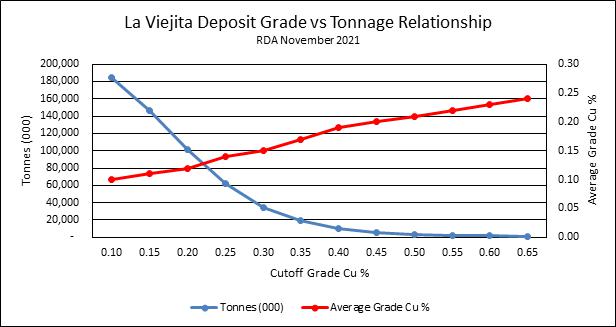
| Key Mining Corp. | |
| S-K 1300 - Technical Report Summary – Fiel Rosita | Page 77 |
| | |
Table 11-6 Grade / Tonnage Relationship for El Chiflon Deposit
| Cu-Eq Cog | K mt | Cu Eq | TCu | Mo | Au | Ag | Zn | K mt Fine Cu |
| 0.10 | 14,829 | 0.29 | 0.13 | 325.87 | 0.01 | 0.70 | 0.01 | 19 |
| 0.15 | 8,810 | 0.40 | 0.16 | 506.18 | 0.01 | 0.82 | 0.01 | 14 |
| 0.20 | 6,674 | 0.47 | 0.18 | 630.41 | 0.01 | 0.88 | 0.01 | 12 |
| 0.25 | 5,183 | 0.54 | 0.19 | 754.01 | 0.02 | 0.92 | 0.01 | 10 |
| 0.30 | 3,685 | 0.65 | 0.21 | 955.55 | 0.02 | 0.96 | 0.01 | 8 |
| 0.35 | 2,724 | 0.77 | 0.23 | 1,181.92 | 0.01 | 0.93 | 0.01 | 6 |
| 0.40 | 2,251 | 0.85 | 0.25 | 1,344.45 | 0.01 | 0.91 | 0.01 | 6 |
| 0.45 | 1,913 | 0.93 | 0.26 | 1,486.25 | 0.01 | 0.93 | 0.01 | 5 |
| 0.50 | 1,676 | 0.99 | 0.28 | 1,594.41 | 0.01 | 0.95 | 0.01 | 5 |
| 0.55 | 1,439 | 1.07 | 0.29 | 1,733.92 | 0.02 | 0.98 | 0.01 | 4 |
| 0.60 | 1,198 | 1.17 | 0.30 | 1,936.38 | 0.02 | 1.01 | 0.01 | 4 |
| 0.65 | 1,061 | 1.24 | 0.31 | 2,073.57 | 0.02 | 1.05 | 0.01 | 3 |

Figure 11-9 Cu-Equivalent Tonne/Grade Curve El Chiflon
| Key Mining Corp. | |
| S-K 1300 - Technical Report Summary – Fiel Rosita | Page 78 |
| | |
Table 11-7 Fiel Rosita Project Grade Tonnage Relationship
| Cu-Eq Cog | K mt | Cu Eq | TCu | Mo | Au | Ag | Zn | K mt Fine Cu |
| 0.10 | 885,744 | 0.25 | 0.12 | 90.80 | 0.08 | 1.76 | 0.07 | 1,027 |
| 0.15 | 563,680 | 0.32 | 0.14 | 124.86 | 0.10 | 2.24 | 0.09 | 788 |
| 0.20 | 362,778 | 0.40 | 0.17 | 172.02 | 0.12 | 2.84 | 0.11 | 618 |
| 0.25 | 237,667 | 0.49 | 0.21 | 232.15 | 0.15 | 3.55 | 0.14 | 489 |
| 0.30 | 165,607 | 0.59 | 0.24 | 299.17 | 0.17 | 4.31 | 0.17 | 391 |
| 0.35 | 121,491 | 0.69 | 0.28 | 370.91 | 0.18 | 5.07 | 0.20 | 338 |
| 0.40 | 91,807 | 0.79 | 0.31 | 444.62 | 0.19 | 5.84 | 0.23 | 287 |
| 0.45 | 73,051 | 0.88 | 0.35 | 511.56 | 0.21 | 6.54 | 0.25 | 258 |
| 0.50 | 59,507 | 0.97 | 0.39 | 575.29 | 0.23 | 7.22 | 0.27 | 234 |
| 0.55 | 50,308 | 1.05 | 0.42 | 627.02 | 0.25 | 7.84 | 0.29 | 213 |
| 0.60 | 42,803 | 1.14 | 0.46 | 677.49 | 0.27 | 8.46 | 0.31 | 199 |
| 0.65 | 37,008 | 1.22 | 0.50 | 723.48 | 0.28 | 9.05 | 0.33 | 183 |

Figure 11-10 Fiel Rosita Area Grade / Tonnage Relationship
| 11.4 | Mineral Resource Estimate |
Indicated Mineral Resources for each of the three mineral deposits of Fiel Rosita are reported in Table 11-8. Inferred Mineral Resources for the three deposits are summarized in Table 11-9. Tonnages and grades are rounded to reflect that these are estimated tonnages and grades. Totals may not add up due to rounding. Resources are reported at a 0.2% CuEq cutoff grade.
| Key Mining Corp. | |
| S-K 1300 - Technical Report Summary – Fiel Rosita | Page 79 |
| | |
Table 11-8 Fiel Rosita Project Indicated Mineral Resource
| Deposit | CuEq Cutoff | K mt | CuEq% | Cu % | Mo ppm | Au ppm | Ag ppm | Zn % |
| Fiel Rosita | 0.25% | 66,092 | 0.61 | 0.29 | 173 | 0.12 | 5.89 | 0.29 |
| La Viejita | 0.25% | 58,520 | 0.34 | 0.14 | 31 | 0.24 | 1.21 | 0.02 |
| El Chiflon | 0.25% | 5,039 | 0.55 | 0.19 | 765 | 0.02 | 0.92 | 0.01 |
| Total | | 129,651 | 0.49 | 0.22 | 132 | 0.17 | 3.58 | 0.16 |
| | | | Metal | Cu Kmt | Mo Klbs | Au Koz | Ag Koz | Zn Kmt |
| | | | Fiel Rosita | 192 | 25,168 | 255 | 12,517 | 192 |
| | | | La Viejita | 82 | 4,032 | 452 | 2,277 | 12 |
| | | | El Chiflon | 10 | 8,504 | 3 | 149 | 1 |
| | | | Total | 283 | 37,703 | 710 | 14,943 | 204 |
Table 11-9 Fiel Rosita Inferred Mineral Resources
| Deposit | CuEq Cutoff | K mt | CuEq% | Cu % | Mo ppm | Au ppm | Ag ppm | Zn % |
| Fiel Rosita | 0.25% | 104,429 | 0.51 | 0.19 | 363 | 0.12 | 3.59 | 0.12 |
| La Viejita | 0.25% | 3,442 | 0.32 | 0.19 | 28 | 0.21 | 1.20 | 0.02 |
| El Chiflon | 0.25% | 144 | 0.46 | 0.28 | 352 | 0.01 | 1.08 | 0.01 |
| Total | | 108,015 | 0.50 | 0.19 | 352 | 0.12 | 3.51 | 0.12 |
| | | | Metal | Cu Kmt | Mo Klbs | Au Koz | Ag Koz | Zn Kmt |
| | | | Fiel Rosita | 198 | 83,603 | 403 | 12,055 | 125 |
| | | | La Viejita | 5 | 216 | 23 | 133 | 1 |
| | | | El Chiflon | 1 | 112 | 0 | 5 | 0 |
| | | | Total | 203 | 83,930 | 426 | 12,192 | 126 |
The effective date of the mineral resource estimate is July 17, 2023.
The point of reference for the mineral resource estimate is in situ mineralization prior to extraction by open pit mining methods. The prices selected for the mineral resource estimate are based on the average metal spot prices at October 2021. The qualified person chose to use these conservative prices for this technical report summary. The cutoff grade of 0.25% considered mining costs of $1.85/tonne, metallurgical recoveries of 85% for each of the metals Cu, Mo, Au, Ag and Zn. A processing cost of $7.00/tonne was considered in the cutoff grade. Metal selling prices of 3.50 Cu/lb, 14.00 Mo/lb, $1,750 Au/oz, $23.00 Ag/oz and $1.10 Zn/lb were considered in the cutoff grade.
Mineral resources for the Project are enumerated as per §229.1302(d)(1)(iii)(A) (Item 1302(d)(1)(iii)(A) of Regulation S-K).
Mineral resources are not mineral reserves and do not meet the threshold for reserve modifying factors, such as economic viability, that would allow for conversion to mineral reserves. There is no certainty that any part of the Mineral Resources estimated will be converted to mineral reserves.
Numbers in the table have been rounded to reflect the accuracy of the estimate and may not sum due to rounding.
| Key Mining Corp. | |
| S-K 1300 - Technical Report Summary – Fiel Rosita | Page 80 |
| | |
Uncertainties exist in the spatial distribution on mineralization. The samples themselves have uncertainty related to sampling collection errors and the homogeneity of the deposit. The wider spaced drilling has more uncertainty that closely spaced drilling. Capping of high-grade outliers was used to endure that the mineral content of the deposit was not over stated. High grade outlier samples will tend to overestimate the metal content of the mineral deposit. The block model for the deposit was constructed using sufficient sized blocks to account for mining dilution and uncertainties related to the actual physical distribution of mineralization. Domains were utilized to minimize the estimation of mineralization into rick units that do not host mineralization. These underlying factors were considered in the final conclusion of the mineral resource estimate.
In the opinion of the qualified person all known issues relating to all relevant technical and economic factors have been considered for the Project at the point of reference. Further work such as infill drilling could convert inferred mineral resource to indicated mineral resources which would in turn influence the prospect of economic extraction.
| Key Mining Corp. | |
| S-K 1300 - Technical Report Summary – Fiel Rosita | Page 81 |
| | |
| 12 | Mineral Reserve Estimates |
No mineral reserve estimates are calculated for Fiel Rosita.
| Key Mining Corp. | |
| S-K 1300 - Technical Report Summary – Fiel Rosita | Page 82 |
| | |
| 13.1 | Selection of Mining Method |
The mining method chosen is the underground Sub Level Open Stopping (SLOS) method with subsequent backfilling to maximize the recovery of the deposit. This method was chosen based on the experience of the authors, complemented with the UBC methodology for mining method selection which classifies rock mechanics into two parameters, namely: Rock Mass Rating (RMR) and Rock Substance Strength (RSS). UBC methodology assigned a score of 1 through 4 based on the evaluation of geological, geotechnical, and morphological parameters of the deposit. The UBC evaluation suggests open pit mining for Fiel Rosita however that method was not evaluated for this analysis due to the amount of surface disturbance required for an open pit mining operation.
Only the Fiel Rosita deposit was evaluated for the mining analysis. La Viejita and El Chiflon were not considered in the economic analysis of the Project.
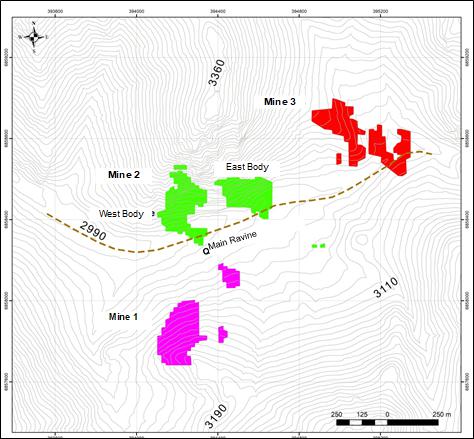
Figure 13-1 Mineralized Zones of the Fiel Rosita Deposit
The mineralization has an irregular, massive, and sub-vertical shape, forming bodies whose dimensions are summarized in Table 13-1. In general, there is a heterogeneous distribution of grades (copper equivalent), concentrating the highest grades in the central part and gradually decreasing towards the periphery. The mineralized bodies located in the Mine 1 and Mine 2 zones are located close to the surface, while the body located in the Mine 3 zone is about 100 m deep. In general, the geotechnical quality of the rock mass is rated as good, with indices of 60 to 70, according to the Rock Mass Rating (RMR).
| Key Mining Corp. | |
| S-K 1300 - Technical Report Summary – Fiel Rosita | Page 83 |
| | |
Table 13-1 Dimensions of Mineralized Zones
| Mine Deposit | Average height (m) | Medium length (m) | Medium width (m) |
| Mine 1 | 140 - 150 | 250 - 280 | 150 - 170 |
| Mine 2 (West Body) | 350 - 370 | 300 - 320 | 120 - 130 |
| Mine 2 (East Body) | 230 - 270 | 200 - 220 | 100 - 120 |
| Mine 3 | 350 - 380 | 320 - 350 | 100 - 120 |
The mining method defines operating units whose dimensions should not exceed the maximum stable hydraulic radius according to the qualification of rock mass. The estimated maximum hydraulic radii vary between 7 and 10 m; with heights between 25 m and 40 m; lengths between 20 and 40 m, and widths of 20 m. For the extraction of mineralization, two levels must be prepared for each mining unit: (a) an upper level or roof for terrace drilling and, (b) a lower level or base, to build the extraction trench or “undercut” to receive the blasted material. The construction of the trench is done by extracting slices that are drilled upwards. The free or open face of each unit is made by connecting the roof and base cutting galleries by building a cut-off shaft or chimney. The mining units are classified into primary and secondary depending on the extraction sequence and subsequent backfill as shown by the layout of Figure 13-2.
The backfill used is cemented hydraulic type (3% cement). The base material will be the tailings from the processing plant. The cement mixture will be deposited through a network of shafts and pipes that connect the backfill/concrete plant with the emptying points.
| Key Mining Corp. | |
| S-K 1300 - Technical Report Summary – Fiel Rosita | Page 84 |
| | |
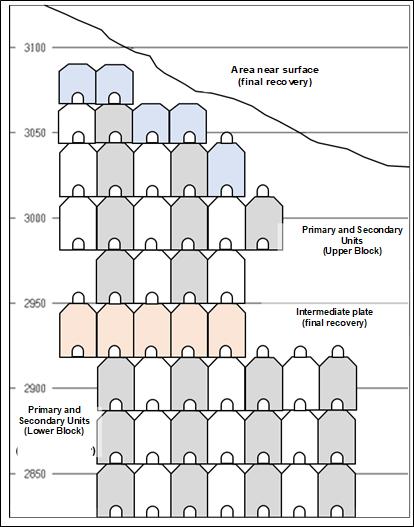
Figure 13-2 Mining Layout
| 13.2 | Rock Mass Quality Model |
Based on the integration of the geological model, available geological-geotechnical information, and the information collected by the authors, a total of six geotechnical units were defined. In Figure 13-3, a layout of the conceptualization of geotechnical units is shown, in terms of lithology and geological environment.
| Key Mining Corp. | |
| S-K 1300 - Technical Report Summary – Fiel Rosita | Page 85 |
| | |
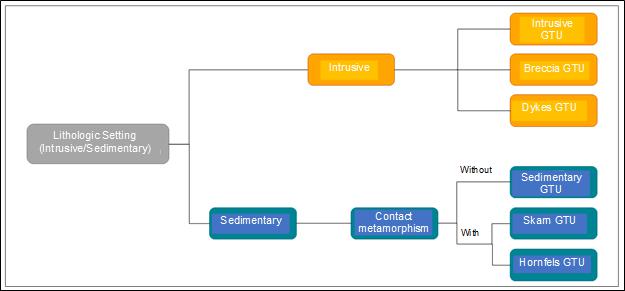
Figure 13-3 Geotechnical unit construction layout of the Project
The following is a brief description of each geotechnical unit (GTU), together with a summary of the quality indices and the shear properties as observed in Table 13-2.
| ● | Intrusive GTU (INT): Groups intrusive rocks, such as granodiorites and dacites with porphyry texture. It has a RQD of 60-90%, and a preliminary RMRB89 between 60-65, under dry mass conditions, being classified as a rock mass of good geotechnical quality. |
| | | |
| ● | Breccia GTU (BX): groups polymictic, monomictic, and tourmaline hydrothermal breccias. It has an RQD of 60-100%, and a preliminary RMRB89 value of between 55-60, under dry mass conditions, being classified as a rock mass of good geotechnical quality. |
| | | |
| ● | Hornfels GTU (HNF): corresponds to Cornean rocks associated with contact metamorphism. It has an RQD of 60-90%, a preliminary RMRB89 value of between 65-70, under dry mass conditions, being classified as a rock mass of good geotechnical quality. |
| | | |
| ● | Skarn GTU (RX-SK): corresponds to sedimentary rocks with calcareous-silicate alteration development (skarn). It has an RQD of 70-100%, and a preliminary RMRB89 value of between 70-75, under dry mass conditions, being classified as a rock mass of good geotechnical quality. |
| | | |
| ● | Dykes GTU (DQ): Andesite dykes, with an RQD of 65-90% and an RMRB89 of between 70-75, under dry mass conditions, being classified as a rock mass of good geotechnical quality. |
| | | |
| ● | Fractured Area GTU (ZF): Defined as fractured zones located in zones parallel to the axis of the structures. It has an RQD of 10-50%, and a preliminary RMRB89 value of between 60-65, under dry mass conditions, being classified as a rock mass of regular geotechnical quality. |
| | | |
| ● | Sedimentary Rocks GTU (RX-SED): groups sedimentary rocks such as calcareous sandstone, limestone, and marl. It has an RQD of 60-90%, and a preliminary RMRB89 value of between 60-65, under dry mass conditions, being classified as a rock mass of good geotechnical quality. |
| | | |
| ● | Weathered Zone: Perspective of the superficial rock mass up to 10 m. affected by weathering processes. It consists mainly of sedimentary and intrusive rocks, which are affected by argillization. |
| Key Mining Corp. | |
| S-K 1300 - Technical Report Summary – Fiel Rosita | Page 86 |
| | |
Table 13-2 Summary of Geotechnical Units
| ID Preliminary GTU | Setting | Description | IRS (**) | RQD (%) (*) | JC (**) | RMRB89(***) |
| INT | Intrusive | Intrusive | R5 | 60-90 | 16 | 60-65 |
| BX | Breccias | R4 | 60-100 | 12 | 55-60 |
| DQ | Dykes | R5 | 65-90 | 16 | 70-75 |
| HNF | Sedimentary | Hornfels | R5 | 60-90 | 16 | 65-70 |
| RX-SED | Sedimentary Rocks | R4 | 60-90 | 16 | 60-65 |
| RX-SK | Skarnified Rocks | R5 | 70-100 | 16 | 70-75 |
| ZF | Structural | Fractured zone | R3 | 10-50 | 16 | 40-45 |
(*) RQD and spacing estimated using the photographic record of boreholes.
(**) Estimated in the field and from the background information on other projects executed by EMT
(***) Considered dry water condition.
In Figure 13-4, a plan is shown with the location of the representative geotechnical sections of the Fiel Rosita district: transverse to the West Body (Figure 13-5), Central Body (Figure 13-6), and Northern Breccia (Figure 13-7) and general longitudinal that allows visualizing the intrusive and sedimentary environment (Figure 13-8).
| Key Mining Corp. | |
| S-K 1300 - Technical Report Summary – Fiel Rosita | Page 87 |
| | |
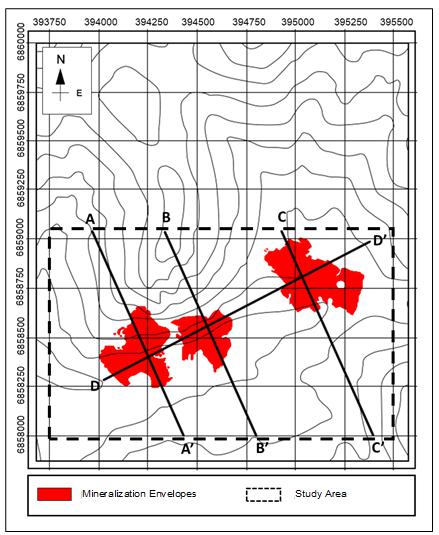
Figure 13-4 Overview showing geotechnical sections
| Key Mining Corp. | |
| S-K 1300 - Technical Report Summary – Fiel Rosita | Page 88 |
| | |
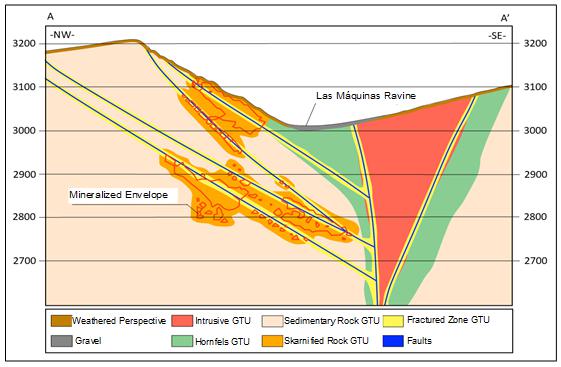
Figure 13-5 Representative section of the geotechnical units for the west mineral body
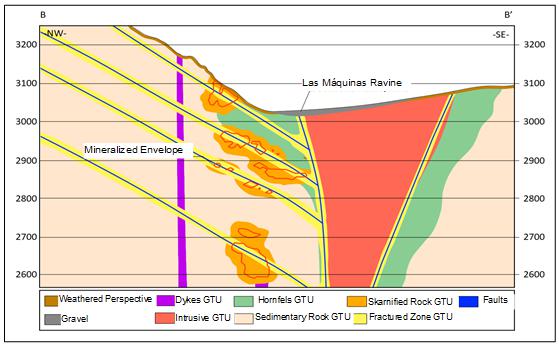
Figure 13-6 Representative section of the geotechnical units for the central mineral body
| Key Mining Corp. | |
| S-K 1300 - Technical Report Summary – Fiel Rosita | Page 89 |
| | |

Figure 13-7 Representative section of the geotechnical units for the central mineral body
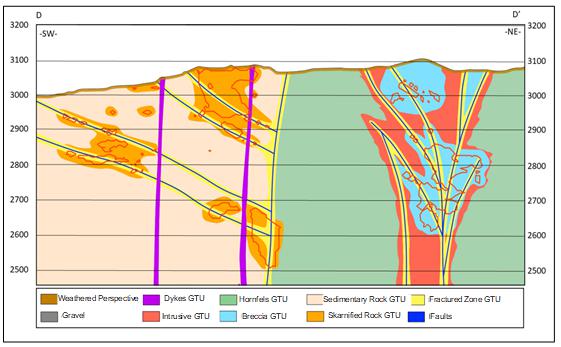
Figure 13-8 Representative section of the geotechnical units for the Fiel Rosita Project
| Key Mining Corp. | |
| S-K 1300 - Technical Report Summary – Fiel Rosita | Page 90 |
| | |
The district is located in a large exoreic basin (Figure 13-9), where there is a main recharge through precipitation that tends to mobilize waters through ephemeral ravines and rivers. This background information helps to consider contributions through runoff flows and water infiltration, through weathered limits of the rock units.
The phreatic level (PL) or water table measurement record in boreholes determines a depth of 18-20 m in the central part of the ravines (greater thickness of gravel/backfill). This hydrological and geological information allows defining three conceptual hydro-stratigraphic units:
| ● | Quaternary deposits: Little to moderately consolidated sediments (conglomerates, gravel, and sand) that fill hillsides with a slight slope and ravines. They are classified as permeable strata, with high porosity and permeability that allow rainwater infiltration. |
| | | |
| ● | Sedimentary rocks: These are limestone, marl, calcarenite, and conglomerates present in the area. They are classified as rocks with porosity and variable permeability. Secondary structures such as fractures and faults allow water infiltration. |
| | | |
| ● | Intrusive Rocks: Rocks of dacitic and granitic composition, and breccias; with very low porosity and permeability. They are rocks with very low storage capacity, but their permeability can vary in areas of intense and highly altered fracturing. |
Figure 13-9 shows an aerial view of the hydrogeological basin, while Figure 13.1shows the location of the (dendritic) drainage patterns in the project area.
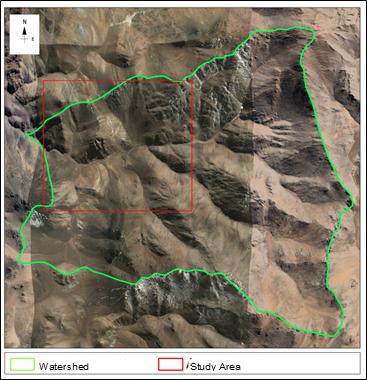
Figure 13-9 Fiel Rosita hydrogeological basin
| Key Mining Corp. | |
| S-K 1300 - Technical Report Summary – Fiel Rosita | Page 91 |
| | |
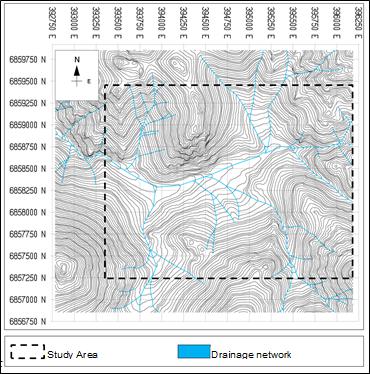
Figure 13-10 Drainage network of the Project
The main infrastructure proposed for the mine considers the construction of 3 access portals (one for each Mine) as shown in the overview of Figure 13-11.
| Key Mining Corp. | |
| S-K 1300 - Technical Report Summary – Fiel Rosita | Page 92 |
| | |

Figure 13-11 Overview of mining access and infrastructure
The main ramps (5 m x 5 m) will allow access to all the preparation and production levels (4.5 m x 4.5 m). Preliminarily, it was established that the metal extraction will be carried out essentially vertically inside the mine (Rock Pass 5 m in diameter) and with trucks to the treatment plant whose location is positioned in front of portal 2 of the underground mine. Two Rock Passes were established for Mines 2 and 3, while for Mine 1 only direct extraction by trucks is anticipated. Additionally, the vertical infrastructure for the backfill of reinforcements and ventilation was considered. Figure 13-12 schematically shows the proposed mine infrastructure for this initial assessment.
| Key Mining Corp. | |
| S-K 1300 - Technical Report Summary – Fiel Rosita | Page 93 |
| | |
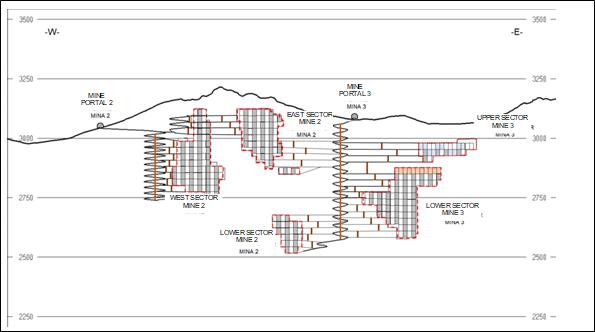
Figure 13-12 Underground Mining Layout
To determine the best extraction rates, capital and operating expenses, personnel, equipment and recovery factors, a general layout of the project was developed. Fleet estimates and operating costs are based on standard mining indicators which are publicly available. A summary of the infrastructure layout is shown in Table 13-3 and Table 13-4. The total of horizontal meters reach around 100,000 m distributed in main ramps, accesses, developments, and preparations. The ramps and accesses are investments to enable production in each mine system, while the developments and preparations are costs associated with the production of each unit.
Table 13-3 Summary of horizontal tasks
| Horizontal | Mine 1 (m) | Mine 2 (m) | Mine 3 (m) | Total (m) |
| Main ramp and accesses | 4,600 | 5,000 | 4,800 | 14,400 |
| Developments | 12,600 | 24,500 | 15,100 | 52,200 |
| Preparations | 8,800 | 11,000 | 10,500 | 30,300 |
| Total | 26,000 | 40,500 | 30,400 | 96,900 |
Table 13-4 Summary of vertical tasks
| Vertical | Total (m) |
| Ventilation shafts/backfill | 1,850 |
| Main Mine Shaft – Ore Pass | 850 |
Table 13-5 summarizes the fleet of main equipment required for mine development and production, based on which each mine has its own operating crew. The investment associated with the equipment was estimated based on quotes updated to 2022. Auxiliary mobile equipment is included.
| Key Mining Corp. | |
| S-K 1300 - Technical Report Summary – Fiel Rosita | Page 94 |
| | |
Table 13-5 Underground Mining Fleet
| Classification | Item | Model | Quantity |
| Development | Jumbo drill rig | DD422i | 3 |
| Development | LHD development | LH410 (toro) | 3 |
| Development | Bolter | DS411 | 3 |
| Development | Lifting Equipment | Manitou | 3 |
| Development | Scaler | Scaler | 2 |
| Development | Vertical Dev. | Boring Head V30 | 3 |
| Production | LHD production | LH410 (toro) | 4 |
| Production | Dump truck | TH545I | 4 |
| Production | Simba Production Drilling | DU411 | 3 |
| Production | DTH Production Drilling | DL311 | 3 |
A mining plan was generated delivering 2.4 Mt per year for a period of 14 years, leaving the zero year and the first semester of the first year for development and initial milling. The mill will produce Cu concentrates (including Au and Ag), Mo concentrate, and Zn concentrate.
The proposed production plan assumed 100% extraction and 5% dilution. The mine plan is summarized in figure 13-13. This plan feeds the mill with mineralization starting with mines 1 and 2 and ending with production from the deeper mine 3. Feed in years 1 and 2 exceed 1.0% CuEq with feed grades declining through the rest of the mine life.
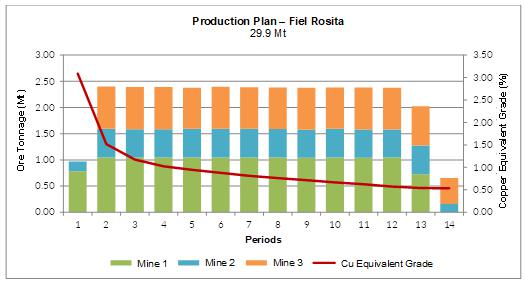
Figure 13-13 Fiel Rosita Mine Production Plan
| Key Mining Corp. | |
| S-K 1300 - Technical Report Summary – Fiel Rosita | Page 95 |
| | |
| 14 | Processing and Recovery Methods |
This section presents the process flow diagram and a description of the process facilities. The conceptual processing method for the mineralized materials of the Fiel Rosita project is a conventional mill with three-product flotation, delivering the following concentrates:
| ● | Copper concentrate (including Gold and Silver) |
| | | |
The metallurgical tests described in Section 10 support the choice of this process for the initial assessment.
The selected process plant unit components include:
| ● | Primary crushing and ore piling |
| | | |
| ● | Grinding and grading (SAG and Balls) |
| | | |
| ● | Rejection treatment (paste thickener, tailings dam, and backfill |
| | | |
| ● | Separation of concentrates |
| | | |
| ● | Reservoir (recovery of water from the last processes) |
Figure 14-1 shows the general flow sheet for the processing plant.
| Key Mining Corp. | |
| S-K 1300 - Technical Report Summary – Fiel Rosita | Page 96 |
| | |
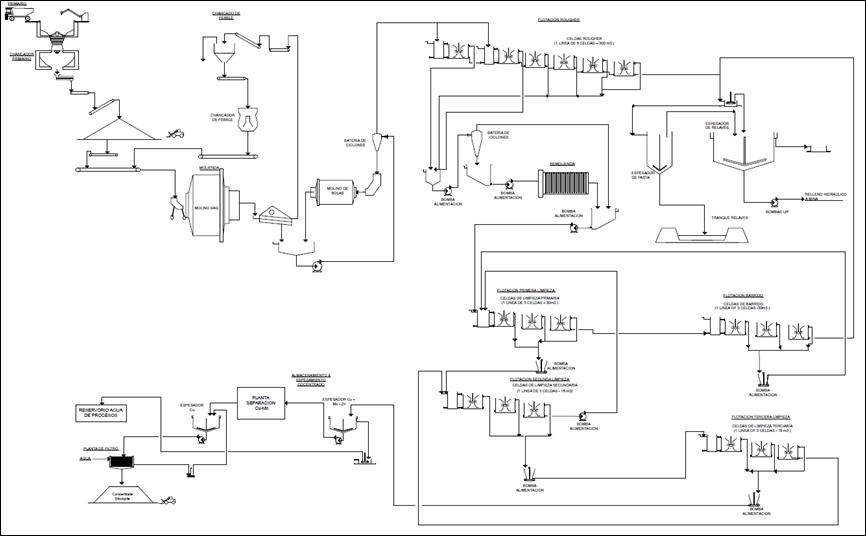
Figure 14-1 Processing Flow Diagram
| Key Mining Corp. | |
| S-K 1300 - Technical Report Summary – Fiel Rosita | Page 97 |
| | |
The infrastructure to support the Fiel Rosita Project will consist of civil works of the site, facilities, offices, and workshops, water management systems, tailings storage, waste material disposal, and electric power distribution. The mine and plant facilities will have potable water, compressed air, power, diesel, communication and sanitary systems, as required. The general “layout” of the Fiel Rosita Project is shown in Figure 15-1.
The processing plant will be located in the sector to the south of the ravine, to the east of Mine 1, while to the west, most of the project’s auxiliary infrastructure is projected. To the north is the tailings dam and the waste storage facilities. The infrastructure in the north corridor area will include:
| ● | Roads for light vehicles and heavy equipment from the west. |
| ● | Access road to the plant and the mines. |
| ● | Primary crusher and conveyor belt. |
| ● | Mining facilities platforms and process facilities platforms. |
| ● | Water management areas and collection ponds. |
| ● | Tailings dam (3,400,000 m3) |
| ● | Waste material dump (600,000 m3). |
| ● | Process plant, including crushing, piling, mill, and reagent storage buildings. The sub-processes for the different metals are included. |
| ● | Wastewater treatment plant. |
| ● | Desalinated water pumps and pipes. |
| ● | High voltage substation of incoming power and electrical distribution throughout the site (for plant and inside mine). |
| | | |
| ● | Office for equipment automation. |
| | | |
| ● | Mine and process administration offices, dressing rooms, and sanitary system. |
| | | |
| ● | Mobile equipment maintenance workshops. |
| | | |
| ● | Fuel station. |
| | | |
| ● | Workshop and warehouse facilities. |
| | | |
| ● | Project watchtower. |
| Key Mining Corp. | |
| S-K 1300 - Technical Report Summary – Fiel Rosita | Page 98 |
| | |
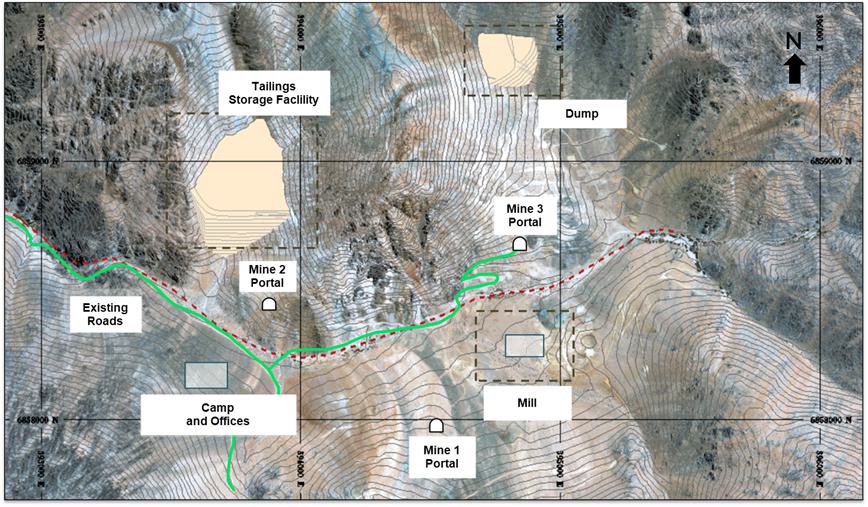
Figure 15-1 General layout of the Fiel Rosita Infrastructure
| Key Mining Corp. | |
| S-K 1300 - Technical Report Summary – Fiel Rosita | Page 99 |
| | |
KM Chile currently has no contract in place with any refineries or buyers of metals produced from the mine.
No market studies have been completed. Copper, gold, silver, molybdenum and zinc are freely traded commodities. For the purposes of this IA produced metals are considered readily marketable with no deleterious/penalty elements.
| Key Mining Corp. | |
| S-K 1300 - Technical Report Summary – Fiel Rosita | Page 100 |
| | |
| 17 | Environmental Studies, permitting and plans, negotiations, or agreements with local individuals or groups |
| Key Mining Corp. | |
| S-K 1300 - Technical Report Summary – Fiel Rosita | Page 101 |
| | |
| 18 | Capital and Operating Costs |
This section covers the estimation of the capital cost (CAPEX) to establish the mine and processing plant, as well as the infrastructures required for the Fiel Rosita Project. The following paragraphs describe the methodology used to estimate the project capital cost. The resulting estimate is based on the application of standard methods required to make an estimate with an accuracy range of -15% to +30%.
An estimate of the expenses needed to put the mine into operation was made to establish the mine’s implementation and operation costs, with a capacity of 2.4 Mt/year using the selective Sublevel Stopping method with cemented backfill. The estimates made by KM Chile and RDA personnel are based on scaling of projects of similar characteristics and unit costs updated at the date of the issuance of the report.
The capital cost estimate considers a distribution of costs for the following basic operations:
| ● | Construction of portals: the requirement of building portals with a regular to good geotechnical condition and with favorable slopes was estimated, considering that there is a temporary access where the portals are projected. |
| ● | Mine Infrastructure: this is the need to build tunnels to leave the 3 mines active. It includes the main ramps (described in Chapter 16), and the accesses to start the production of year 1. It includes the construction of ore pass shafts (by Raise Borer), with a diameter of 5 m; and shafts for ventilation, evacuation, and emergencies (by VCR), with smaller diameters of between 2.5 m and 3 m. |
| ● | Operation of material handling system (skip): mines 2 and 3 have a depth greater than 350 m, so they require a vertical material handling system, which includes the infrastructure of the skip. |
| ● | Acquisition of equipment: This involves the mobile equipment for the development and production of the 3 mines. |
| ● | Electrical System: This includes the acquisition and assembly of the electrical substations for the underground mines and the connection to the plant. |
| ● | Ventilation: This includes the acquisition, transfer, and installation of main and secondary fans; along with the operation of the forced ventilation system (covers, doors, surrounding works, etc.). Each mine will have its own independent ventilation system, where the greatest requirements will be in the deepest areas of mines 2 and 3, which will be reinforced by the main shafts. |
| ● | Refuge Station: This considers the acquisition of 7 mobile stations, which will be arranged by sector in operation, and where there is a constant flow of personnel. It should be considered that much of the operation will be located remotely. |
| ● | Mine Workshops: This includes the setting up of workshop areas (indoor and outdoor), which optimize the requirements of the unit processes. |
| ● | Civil Works and Other Services: This includes all the civil works (CW) required to install the backfill system and mine services, both inside and outside the 3 mines (platforms, pools, containers, etc.). The pumping network, pipes for compressed air and industrial water are included, along with the instrumentation and monitoring network. |
A summary of the mine investments is shown in Table 18-1. The total mine investment is estimated at US$96.6M considering a 25% contingency. This investment is made in the first 6 years with a strong component in the first two years.
| Key Mining Corp. | |
| S-K 1300 - Technical Report Summary – Fiel Rosita | Page 102 |
| | |
Table 18-1 Mining CAPEX
| Item | CAPEX (US$ millions) |
| Construction of Portals | $2.25 |
| Main ramps, accesses, and development | $17.05 |
| Main Mine Shafts – Ore Pass | $3.40 |
| Vertical shafts | $1.85 |
| Skip and operating system | $10.60 |
| Development Equipment | $10.41 |
| Production Equipment | $13.06 |
| Electrical System | $6.00 |
| Ventilation | $1.18 |
| Refuge stations | $0.54 |
| Mine workshops | $1.20 |
| CW and Services | $6.76 |
| Contingencies (25%) | $22.28 |
| Total | $96.56 |
| 18.1.2 | Process Plant CAPEX |
To establish the capital costs of a concentrator plant with a capacity to process 2.4 Mt/year, with collective flotation to produce Cu+Au+Ag concentrate and selective flotation of Mo and Zn; KM Chile hired the services of BIOS Mining & Infrastructure, who made capital and operating cost estimates based on the scaling up of concentrator plant projects of similar characteristics to treat a volume of 2.4 Mt/year. The terms and conditions of the estimates and the results reached by BIOS can be found in detail in the document “Preliminary report on investments and operating costs, Fiel Rosita project, case studies for PFS, BIOS Mining & Infrastructure, December 2022”. The estimated investments – generally conservative - are classified Class 5 according to the standard Practice #18R-97 Cost Estimate Classification System of the American Association of Cost Engineers or AACC.
The capital cost estimate considers a distribution of costs for the following basic operations:
Process Plant: the equipment sizes were estimated using scaling factors based on feed tonnages and residence time in the flotation and thickening system. The following unit operations have been considered:
| ● | Crushing and Wet Grinding |
| | | |
| ● | Collective and Selective Flotation (Mo and Zn) |
| | | |
| ● | Tailings thickening, tailings disposal, and recovered water management. |
| | | |
Infrastructure within the Site: this is for process services and facilities for people. These values were estimated taking as references the process capacities and the number of workers obtained from the definitions of operating costs. This value was estimated using 20 UF/m2 as a reference value.
Off-site Infrastructure: This is related to the energy and sea water supply. These values were estimated based on preliminary electrical and hydraulic sizing calculations.
| Key Mining Corp. | |
| S-K 1300 - Technical Report Summary – Fiel Rosita | Page 103 |
| | |
The plant and seawater supply investment costs are summarized in Table 18-2.
Table 18-2 Plant CAPEX
| Item | CAPEX (MUSD) |
| Concentrator | $72.22 |
| Tailings Management | $2.70 |
| Seawater | $61.75 |
| Energy Supply | $14.85 |
| Construction | $27.27 |
| Camp and Civic Area | $7.20 |
| Contingencies (25%) | $55.80 |
| Cost of the Owner | $4.61 |
| Total | $246.39 |
| 18.1.3 | Other Capital Costs |
The mining project considers a capital expenditure used in recent years associated with the Sustaining Cost or maintenance cost associated with equipment renewal and infrastructure improvement. The value is estimated at US$14.1 M, associated with equipment depreciation. In turn, a closure cost is included, estimated at US$20 M.
A summary of total CAPEX is shown graphically in Figure 18-1.
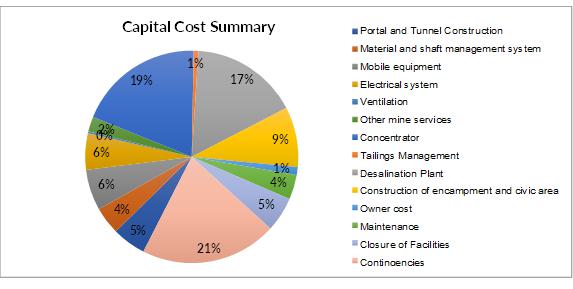
Figure 18-1 Distribution of Project Capital Expenditures
| 18.2 | Operating Costs (OPEX) |
Production: The production cost considers the expenses required to produce a mining unit (drilling, blasting, loading, and transportation) Transport is considered to the portal of each mine. The unit costs contemplate the equipment fleet, labor, and respective supplies.
The labor cost was estimated using the minimum staff numbers considering the availability of instrumentation and automatic control. Market rates were used and labor is incorporated in each unit detailed. This cost considers the main services for the production of an operating unit.
| Key Mining Corp. | |
| S-K 1300 - Technical Report Summary – Fiel Rosita | Page 104 |
| | |
Preparation: The preparation cost considers all unit operations for the horizontal preparation (tunnels). The operations contemplated are drilling, loading of explosives, blasting, ventilation, wedging, fortification, loading and transportation of ore. This cost considers the main services to progress with the tunneling.
Maintenance: The consumption of operating supplies and materials was estimated using databases of projects of a similar size, updating the tariffs to the current market. The different mine maintenance operations are included.
Backfill: This includes the transport of tailings material, incorporation of cement (3%) in the backfill plant and transport inside the mine.
G&A: The administration cost was estimated as 10% of the total accumulated operating cost.
The mine operation costs (OPEX) are summarized in Table 18-3 using the parameterization of the main activities scaled for the Fiel Rosita project. The production, preparation, and backfill activities consider the cost of mining services.
Table 18-3 Mining OPEX
| Item | Unit Cost (US$/t) |
| Production | $4.9 |
| Preparation | $3.4 |
| Maintenance | $4.3 |
| Backfill | $4.9 |
| G&A (10% operation cost) | $1.7 |
| OPEX Mine | $19.2 |
The operating costs of the concentrator plant were estimated, taking as a reference the flow diagram of a previous study and the staff proposed by BIOS, adjusted to the production levels proposed for the Fiel Rosita business case.
For the estimation, the following cost breakdown by item was considered:
Labor: The labor cost corresponds to the cost associated with the staff. In this case, the criterion is to have a daily operation/maintenance staff and to outsource major maintenance services. The labor cost was estimated using the minimum staff numbers considering the availability of instrumentation and automatic control. As in the case of mine, market rates were used.
Energy: The energy cost was estimated based on consumption and electricity tariff. The consumption considered was estimated following the capacity of the main process equipment and secondary material and pulp handling equipment. The electricity tariff was considered to be US$80/MWh.
Operation and Maintenance Materials: The consumption of operating supplies and materials were estimated using the databases of projects of a similar size, updating the tariffs to the current market.
Third-Party Services: The cost of third-party services, which is outsourced labor, was estimated as 50% of own labor costs.
G&A: The administration cost was estimated as 12% of the total accumulated operating cost.
Infrastructure Scaling: To estimate the energy consumption and the capacities of the transport systems, scaling factors defined according to the following criteria were used:
| ● | Crushing and Grinding: Scaling by treatment rate compared to reference project with a production of 6.5 Mt/year. |
| Key Mining Corp. | |
| S-K 1300 - Technical Report Summary – Fiel Rosita | Page 105 |
| | |
| ● | Flotation: The sizes of the flotation equipment were estimated considering a scale factor that delivers the same residence time defined for PFR in previous studies. This makes it possible to ensure that the flotation kinetics are correct. |
| ● | Tailings and concentrates management: scaling factor is used using the production rate, under the assumption that there are no changes in recovery. |
| ● | Seawater Supply: to establish the cost associated with the water supply, the water balance was estimated, considering the use of paste tailings and the “make–up” of fresh water was calculated, including a fraction of waste from the water production osmosis plant for washing concentrates and human consumption. |
The estimated operation costs of the concentrator plant and the seawater supply are summarized in Table 18-4.
Table 18-4 Plant OPEX
| Item | Unit Cost (USD/t) |
| General | $1.03 |
| Primary crushing and pre-crushing | $0.47 |
| Grinding | $3.05 |
| Flotation | $1.82 |
| Thickening and Filtering of Concentrate | $0.22 |
| Tailings Thickening | $0.52 |
| G&A (12% operation cost) | $0.86 |
| Tailings Management | $0.75 |
| Sea water propulsion | $1.12 |
| Transportation of material to Plant | $0.24 |
| Plant OPEX | $10.08 |
The operational cost of Fiel Rosita amounts to US$30.1/t, which incorporates the mine (19.2 US$/t), plant (10.08 US$/t) and general (0.8 US$/t) costs. Figure 18-2 and Figure 18-3 show a summary of the mine and plant costs respectively.
| Key Mining Corp. | |
| S-K 1300 - Technical Report Summary – Fiel Rosita | Page 106 |
| | |
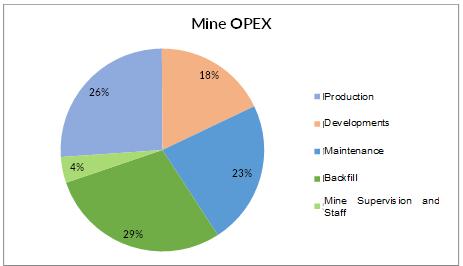
Figure 18-2 Distribution of mining OPEX
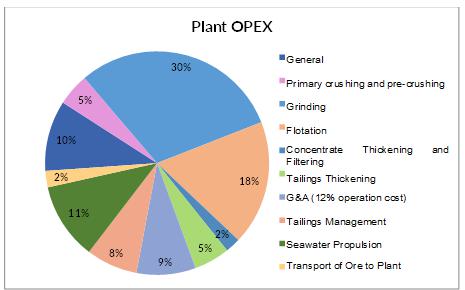
Figure 18-3 Distribution of processing OPEX
| Key Mining Corp. | |
| S-K 1300 - Technical Report Summary – Fiel Rosita | Page 107 |
| | |
For the economic evaluation, a mining plan was generated (100% mining recovery and 5% dilution of the mining units) with annual production to the plant 2.4 Mt for a period of 14 years, with a year zero and the first semester of the first year for development and activation. The products are Cu (includes Au and Ag), Mo, and Zn concentrate. The metallurgical recovery was estimated at 90% Cu, 62% Au, 45% Ag, 68% Mo, and 80% Zn. The major expenditures were scheduled for the first two years, the closure plan cost and the maintenance and operational continuity costs were charged in the final period.
The following section discusses an initial economic assessment for the Project. This economic assessment is preliminary in nature, it includes Inferred Mineral Resources that are considered too speculative geologically to have modifying factors applied to them that would enable them to be categorized as mineral reserves, there is no certainty that this economic assessment will be realized. Forty-Nine percent (49%) of the Mineral Resources used in the cash flow analysis are classified as Inferred Mineral Resources.
A summary of the mining plan and criteria used for the economic evaluation are summarized in Table19-1 and in Table 19-2 excluding Inferred Mineral Resources. Results of the economic analysis are presented in Table 19-3 and in Table 19-4 which excludes Inferred Mineral Resources.
Table 19-1 Summary Mining Plan and Criteria for the Economic Analysis Including Inferred Mineral Resources
| Item | Unit | Value |
| LOM | | |
| Construction periods | years | 1.5 |
| Life of Mine (LOM) | years | 14 |
| Maximum plant capacity | Mt/year | 2.4 |
| Grade to plant | | |
| Copper Grade | % | 0.47 |
| Molybdenum Grade | g/t | 705.8 |
| Zinc Grade | % | 0.34 |
| Gold Grade | g/t | 0.27 |
| Silver Grade | g/t | 8.84 |
| Production | | |
| Fine recoverable Copper | lb | 277,590,177 |
| Fine recoverable Molybdenum | lb | 31,626,036 |
| Fine recoverable Zinc | lb | 178,349,642 |
| Fine recoverable Gold | oz | 159,404 |
| Fine recoverable Silver | oz | 3,822,800 |
| Market Prices | | |
| Copper | USD/lb | 4.1 |
| Molybdenum | USD/lb | 12.7 |
| Zinc | USD/lb | 1.5 |
| Gold | USD/oz | 1,802 |
| Silver | USD/oz | 23.5 |
| Expenses and Taxes | | |
| Basis of analysis | | January, 2023 |
| Inflation | | N.A. |
| General tax | % | 27 |
| Discount rates evaluated | % | 5, 8, and 10 |
| Key Mining Corp. | |
| S-K 1300 - Technical Report Summary – Fiel Rosita | Page 108 |
| | |
Table 19-2 Summary Mining Plan and Criteria for the Economic Analysis Excluding Inferred Mineral Resources
| Item | Unit | Value |
| LOM | | |
| Construction periods | years | 1.5 |
| Life of Mine (LOM) | years | 7.1 |
| Maximum plant capacity | Mt/year | 2.4 |
| Grade to plant | | |
| Copper Grade | % | 0.62 |
| Molybdenum Grade | g/t | 323.6 |
| Zinc Grade | % | 0.58 |
| Gold Grade | g/t | 0.17 |
| Silver Grade | g/t | 11.38 |
| Production | | |
| Fine recoverable Copper | lb | 180,703,700 |
| Fine recoverable Molybdenum | lb | 7,110,500 |
| Fine recoverable Zinc | lb | 84,699,200 |
| Fine recoverable Gold | oz | 50,100 |
| Fine recoverable Silver | oz | 2,412,500 |
| Market Prices | | |
| Copper | USD/lb | 4.1 |
| Molybdenum | USD/lb | 12.7 |
| Zinc | USD/lb | 1.5 |
| Gold | USD/oz | 1,802 |
| Silver | USD/oz | 23.5 |
| Expenses and Taxes | | |
| Basis of analysis | | January, 2023 |
| Inflation | | N.A. |
| General tax | % | 27 |
| Discount rates evaluated | % | 5, 8, and 10 |
| Key Mining Corp. | |
| S-K 1300 - Technical Report Summary – Fiel Rosita | Page 109 |
| | |
Table 19-3 Summary of the economic analysis of underground mining of the Project Including Inferred Mineral Resources
| Production Metrics |
| Mill Throughput | 7,000 | Dry tonnes/day |
| Head Grade – LOM | 0.91 | % Copper Equivalent |
| Mine Life (including pre-production) | 15.5 | Years |
| Total Copper Produced | 277,600,000 | Pounds |
| Total Gold Produced | 159,000 | Ounces |
| Total Silver Produced | 2,413,000 | Ounces |
| Total Molybdenum Produced | 7,111,000 | Pounds |
| Total Zinc Produced | 84,699,000 | Pounds |
| Capital and Operating Costs | |
| CAPEX – Initial | 342.96 | US$Million |
| CAPEX – Sustaining | 14.1 | US$Million |
| Reclamation | 20 | US$Million |
| OPEX – Mining | 17.50 | US$/t mined |
| OPEX – Processing | 9.22 | US$/t processed |
| OPEX – G&A | 2.56 | US$/t mined/processed |
| Pre-Tax Financial Metrics |
| Pre-Tax NPV (@8%) | 459.8 | US$Million |
| Pre-Tax IRR | 48 | % |
| Pre-Tax Payback | 1.4 | Years |
| Post-Tax Financial Metrics |
| Post-Tax NPV (@8%) | 302.0 | US$Million |
| Post-Tax IRR | 40 | % |
| Post-Tax Payback | 2.2 | Years |
The pre-tax internal rate of return (IRR) is 48% and the pre-tax net present value (NPV) using an 8% discount rate over the life of mine is US$460M. The after-tax IRR is 40% and the pre-tax NPV using an 8% discount rate over the life of mine is US$302M.
| Key Mining Corp. | |
| S-K 1300 - Technical Report Summary – Fiel Rosita | Page 110 |
| | |
Table 19-3 Summary of the economic analysis of underground mining of the Project Excluding Inferred Mineral Resources
| Production Metrics |
| Mill Throughput | 7,000 | Dry tonnes/day |
| Head Grade – LOM | 1.13 | % Copper Equivalent |
| Mine Life (including pre-production) | 8.6 | Years |
| Total Copper Produced | 180,704,000 | Pounds |
| Total Gold Produced | 50,000 | Ounces |
| Total Silver Produced | 3,823,000 | Ounces |
| Total Molybdenum Produced | 31,626,000 | Pounds |
| Total Zinc Produced | 178,350,000 | Pounds |
| Capital and Operating Costs | |
| CAPEX – Initial | 342.96 | US$Million |
| CAPEX – Sustaining | 14.1 | US$Million |
| Reclamation | 20 | US$Million |
| OPEX – Mining | 19.20 | US$/t mined |
| OPEX – Processing | 10.1 | US$/t processed |
| OPEX – G&A | 0.80 | US$/t mined/processed |
| Pre-Tax Financial Metrics |
| Pre-Tax NPV (@8%) | 184 | US$Million |
| Pre-Tax IRR | 30 | % |
| Pre-Tax Payback | 1.4 | Years |
| Post-Tax Financial Metrics |
| Post-Tax NPV (@8%) | 94 | US$Million |
| Post-Tax IRR | 20 | % |
| Post-Tax Payback | 2.2 | Years |
Excluding Inferred Resources, the pre-tax internal rate of return is 30% and the pre-tax NPV 8% is US$184M. On an after-tax basis the post-tax IRR is 20% and the post-tax NPV 8% is UD$94M excluding inferred Mineral Resources.
| Key Mining Corp. | |
| S-K 1300 - Technical Report Summary – Fiel Rosita | Page 111 |
| | |
The capital expenditures, operating expenditures, metal prices and copper price were sensitized by ±10% and ±20% from the base case (each variable independently). The price of copper is sensitized separately since it the economic driver of the Fiel Rosita deposit. Table 19-5 shows the variation of the NPV for a discount rate of 8% (pre- and post-tax); while in Figure 19-1 and Figure 19-2, these variations are shown graphically.
Table 19-5 Sensitivity Analysis Summary
| Variation | NPV - Before Tax (MUSD) | | NPV - After Tax (MUSD) |
| CAPEX | OPEX | Price of metals | Cu Price | | CAPEX | OPEX | Price of metals | Cu Price |
| -20% | 361.4 | 396.3 | 91.0 | 194.0 | | 523.3 | 588.3 | 173.1 | 312.2 |
| -10% | 331.7 | 349.2 | 197.1 | 248.0 | | 491.6 | 524.1 | 316.5 | 386.0 |
| 0 | 302.0 | 302.0 | 302.0 | 302.0 | | 459.8 | 459.8 | 459.8 | 459.8 |
| 10% | 272.4 | 254.9 | 406.9 | 356.0 | | 428.0 | 395.5 | 603.1 | 533.6 |
| 20% | 242.7 | 207.8 | 511.8 | 410.0 | | 396.3 | 331.2 | 746.5 | 607.4 |
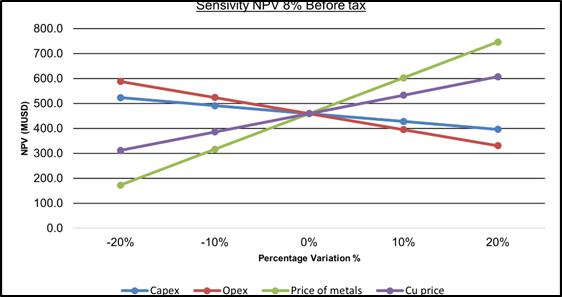
Figure 19-1 Sensitivity Analysis (Pre-Tax)
| Key Mining Corp. | |
| S-K 1300 - Technical Report Summary – Fiel Rosita | Page 112 |
| | |
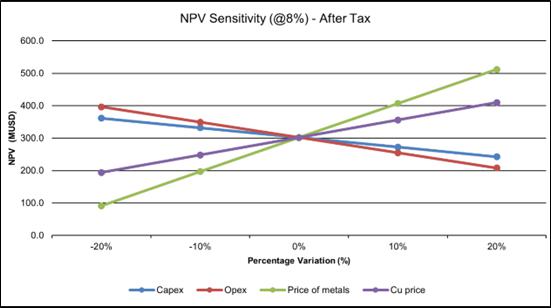
Figure 19-2 Sensitivity Analysis (Post-Tax)
| Key Mining Corp. | |
| S-K 1300 - Technical Report Summary – Fiel Rosita | Page 113 |
| | |
As mentioned in the previous chapters, since Fiel Rosita is a polymetallic deposit, the metallurgical recovery for each mineral plays a preponderant role, which is why sensitization is presented considering ranges between ±3% and ±6% (post-tax). The summary of the sensitization of these parameters is shown in Table 19-6 and graphically in Figure 19-3.
Table 19-6 Sensitivities to NPV by varying metallurgical recoveries
| Variation | NPV - After Tax (MUSD) |
| Cu | Au | Ag | Mo | Zn | Metals |
| -6% | 271.8 | 291.8 | 299.6 | 291.6 | 296.3 | 243.1 |
| -3% | 286.9 | 296.9 | 300.8 | 296.8 | 299.2 | 272.5 |
| 0 | 302.0 | 302.0 | 302.0 | 302.0 | 302.0 | 302.0 |
| 3% | 317.1 | 307.1 | 303.3 | 307.2 | 304.9 | 331.5 |
| 6% | 332.2 | 312.2 | 304.5 | 312.4 | 307.7 | 361.0 |
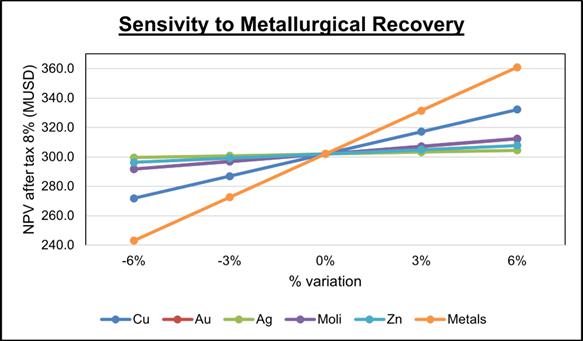
Figure 19-3 Sensitivity of varying metallurgical recoveries
| Key Mining Corp. | |
| S-K 1300 - Technical Report Summary – Fiel Rosita | Page 114 |
| | |
RDA is not aware of properties adjacent to Fiel Rosita with publicly disclosed information.
| Key Mining Corp. | |
| S-K 1300 - Technical Report Summary – Fiel Rosita | Page 115 |
| | |
| 21 | Other Relevant Data and Information |
There is no other relevant information regarding the Fiel Rosita property which would provide a complete and balanced presentation of the value of the Property.
| Key Mining Corp. | |
| S-K 1300 - Technical Report Summary – Fiel Rosita | Page 116 |
| | |
| 22 | Interpretation and Conclusions |
| 22.1 | Mineral Resources Interpretations and Conclusions. |
There have been successive exploration campaigns, which have continued to contribute additional resources to the project. Mineralization has not yet been closed off by drilling. Geologic models need to be improved in three dimensions to better define high grade zones of mineralization.
The recovery results from the metallurgical tests have yielded positive results.
The topography and surrounding area would be suitable for developing a mining operation.
RDA recommends that Fiel Rosita warrants further exploration including drilling to upgrade and delimit Mineral Resources, project wide geological mapping with additional soil sampling.
Sample Preparation
From the analyses conducted by Golder (2014) and consistent with the controls implemented as a part of SQM’s QA and QC, RDA recommend that work must be done on the following issues:
| ● | Preparing a document detailing all of the main aspects of the QA and QC program for clarity in respect of the process, and a consistent use of the ppm and % measurement units; |
| ● | Implementing a work platform to ensure that there is no external manipulation of the results and analyses thereof, and which enables online result management, with result reception and inclusion of all process-related information; |
| ● | Even though there is generally no evidence of any systematic contamination, we recommend a review to ensure that there are no CB values over the tolerance limits, as well as assessing the use of CB materials according to the type of deposits and duly certified for use; and |
| ● | Although the accuracy values obtained from the standards were acceptable for TCu, the results for other elements showed bias levels that must be investigated and assessed to determine their origins. Additionally, we recommend reviewing those values that were notably outside the acceptance ranges to determine the reasons at origin. |
The accuracy values obtained from the various duplicates were acceptable for the main elements, such as TCu and Zn, but not for secondary elements, like Pb, Mo and Au, which evidence problems that may be connected to the existing sampling protocol; secondly, since FD results showed an increased accuracy in respect of CD results, in line with expectations, we recommend checking for any potential confusion problems regarding labelling or envelope confusions associated with sample pairs that showed the greatest differences, and thirdly, the low LD accuracy results bring about the need for a detail review of the analysis procedures of both laboratories, possibly considering that some standards be forwarded for the second laboratory’s assessment of such results.
The initial assessment is based upon the extensive experience of recognized authorities in the mining industry. The methodology used is to the level of a scoping study, where a low level of detailed engineering and a high level of experience and reference to similar studies are required. The geology of the deposit is well recognized at a district and deposit level.
To date, there is sufficient geotechnical information to support the selection of the Sublevel Stoping, along with the recommended infrastructure and mining equipment. The results for the initial assessment, demonstrate that KM Chile can continue development of the Project.
The 25% contingency in capital costs is suitable to absorb deviations in the estimation of key parameters or indices both in the mine and the process plant. The results of the economic assessment show a promising business case that is not overly sensitive to the estimated investment and operating costs at this level of engineering. The greatest sensitivity of the economic evaluation would be in the metallurgical recovery parameters that the CuEq (copper equivalent) grades must guarantee, as it is for a low-grade deposit.
| Key Mining Corp. | |
| S-K 1300 - Technical Report Summary – Fiel Rosita | Page 117 |
| | |
RDA is recommending two separate work programs for the development of the Project: an exploration work program of US$6.9M and pre-feasibility development program of US$6.7M. Neither program is contingent on the other, nor are the programs successive to one another. KM Chile may choose to implement one, or the other, or both.
It is recommended that Fiel Rosita warrants further exploration including drilling to upgrade and delimit Mineral Resources, project wide geological mapping with additional soil sampling. Geological models need to be improved in three dimensions to better define high grade zones of mineralization.
RDA recommends that a soil sampling program be implemented across the Fiel Rosita project area. This program would identify the existence of additional Cu bearing mineral deposits within the project area. Additionally, a drilling program consisting of 10,000 meters, tentatively distributed across ten, 500-to-1500-meter-deep core holes, should be drilled to expand known mineralization and to infill portions of the current block models.
Table 23-1 Proposed Exploration Work Program to Delineate Fiel Rosita Mineral Resources
| Activity | Amount US$ (*1,000) |
| Core Drilling Program 10,000 meters @ $300US per meter | 3,000 |
| Assaying | 200 |
| Technical Services | 400 |
| Soil Sampling & Interpretation Program | 500 |
| Resource Modeling | 500 |
| License, Fees & Taxes | 300 |
| G&A | 1,000 |
| Calculated Exploration Development Cost | 5,900 |
| Contingency (17%) | 1,019 |
| Total | 6,919 |
Monte Carlo simulations suggest there is a 55% probability that the recommended work program will exceed US$5,900,000. A contingency of 17% has been added to the suggested work program cost.
| 23.2 | Recommended Work Program to Support a Pre-Feasibility Study |
KMC should continue to de-risk the Project. A processing plant flowsheet should be developed specifically based on the geo-metallurgical properties of Fiel Rosita mineralization to ensure the recovery of Cu and the by-products that support the equivalent grades. Develop a more comprehensive design of the mining infrastructure complete the “layout” of the mine including the reinforcement backfill infrastructure and ensuring the viability of the seawater supply as a safe alternative.
The use of seawater is a common practice in Chilean mining and should not generate major deviations in its implementation and operation. However, the environmental and community requirements related to its route of approximately 100 km to the plant should be resolved early.
| Key Mining Corp. | |
| S-K 1300 - Technical Report Summary – Fiel Rosita | Page 118 |
| | |
The Fiel Rosita initial assessment suggests an economically viable mining project may be developed. An infill drilling r program is recommended. Additional drilling is required to characterize rock mechanics and to collect samples for metallurgical testing. Table 23-2 delineates the cost breakdown to develop a pre-feasibility study.
Table 23-2 Pre-Feasibility Cost Breakdown
| Activity | Amount US$ (*1,000) |
| Geotechnical Drilling Program 4,000 meters @ US$300 | 1,200 |
| Assaying | 100 |
| Metallurgical Testing Program | 1,000 |
| Hydro-geological modeling | 700 |
| Geotechnical Mapping | 200 |
| Infrastructure Layout Assessment | 400 |
| Mill Flowsheet | 700 |
| Technical Services and Economic Analysis | 1,180 |
| Site General Costs | 500 |
| G&A | 1,000 |
| Calculated Pre-Feasibility Cost | 5,700 |
| Contingency (17%) | 971 |
| Total | 6,671 |
Monte Carlo simulations suggest there is a 49% probability that the recommended work program will exceed US$5,700,000. A contingency of 17% has been added to the suggested work program cost.
| Key Mining Corp. | |
| S-K 1300 - Technical Report Summary – Fiel Rosita | Page 119 |
| | |
E-Mining Technology S.A., 2023: Preliminary Economic Assessment, Fiel Rosita Mining Project. 65 pages
Golder Associates, 2014: “Estimación de Recursos Sector La Viejita, IV Región, Chile” [Resource Estimates in La Viejita, Fourth Region, Chile]; Technical Report to SQM, No.: 1392154010_IT067, Rev. 0; October of 2014;
Golder Associates, 2014: “Estimación de Recursos Sector Fiel Rosita, IV Región, Chile” [Resource Estimates in Fiel Rosita, Fourth Region, Chile]; Technical Report to SQM, No.: 139 215 4010_IT055, Rev. 0; October of 2014;
Golder Associates, 2014: “QAQC Análisis Resultado de QAQC Programa de Leyes Analíticas, Distrito Fiel Rosita, III Región” [Analysis of the QA&QC Analytical-Grade Program Results, Fiel-Rosita District, Third Region, Chile]; Technical Report to SQM, No.: 149 215 4010_MT057, Rev. B, June of 2014;
Golder Associates, 2013: “Distrito Fiel Rosita: Construcción Modelo Recursos, Proyecto Fiel Rosita, III Región, Chile” [Fiel-Rosita District: Resource Modelling, Fiel-Rosita Project, Third Region, Chile]; Technical Report to SQM, No.: 129 215 4006_IT018, Rev. B, July of 2013;
Promet101, 2014: “Proyecto Fiel Rosita Fase II: Estimación Costos de Capital” [Fiel-Rosita Project, Phase 2: Capital Cost Estimates]; Conceptual Study, Revision B; Technical Report to SQM SQM, July 28, 2014;
Promet101, 2014: “Proyecto Fiel Rosita Fase II: Ingeniería Conceptual: Reporte Metalúrgico” [Fiel-Rosita Project, Phase 2, Conceptual Engineering: Metallurgical Report], Revision P; Technical Report to SQM, August 1, 2014, and
Promet101, 2014: “Proyecto Fiel Rosita Fase II: Descripción de Procesos” [Fiel-Rosita Project, Phase 2: Process Descriptions], Revision P; Technical Report to SQM, July 27, 2014.
Resource Development Associates, 2021: MI 43-101 Technical Report, Key Metals Fiel Rosita Project, Region III, Atacama, Chile. 72 Pages
| Key Mining Corp. | |
| S-K 1300 - Technical Report Summary – Fiel Rosita | Page 120 |
| | |
| 25 | Reliance on Information Provided by the Registrant |
RDA has not reviewed the mineral tenure, nor independently verified the legal status, ownership of the Project area, underlying property agreements or permits. RDA has fully relied upon information derived from KM Chile experts and experts retained by KM Chile for this information through the following documents:
| ● | Dario Bustos: Propiedad Minera – Key Metals Corporation Chile SpA: Report prepared for Key Metals Corporation Chile SpA, August 24th 2021 |
| ● | Chile Inc. (Abogados): Informe de Títulos de Concesiones Mineras de Proyecto Fiel Rosita: Title opinion prepared for Key Metals Corporation Chile SpA. |
| Key Mining Corp. | |
| S-K 1300 - Technical Report Summary – Fiel Rosita | Page 121 |
| | |
| 26 | Date and Signature Page |
Certificate of Author
Resource Development Associates Inc, (RDA) of Highlands Ranch, Colorado, USA does hereby certify that:
| ● | RDA is an independent, third-party consulting firm comprising mining experts such as professional geologists, mining engineers and, metallurgists. |
| ● | RDA has read the definition of “qualified person” set out in S-K 1300 and certifies that by reason of education, professional registration and relevant work experience, RDA professionals fulfill the requirements to be a “qualified person” for the purposes of S-K 1300. |
/s/ Scott Wilson
Resource Development Associates, Inc.































































